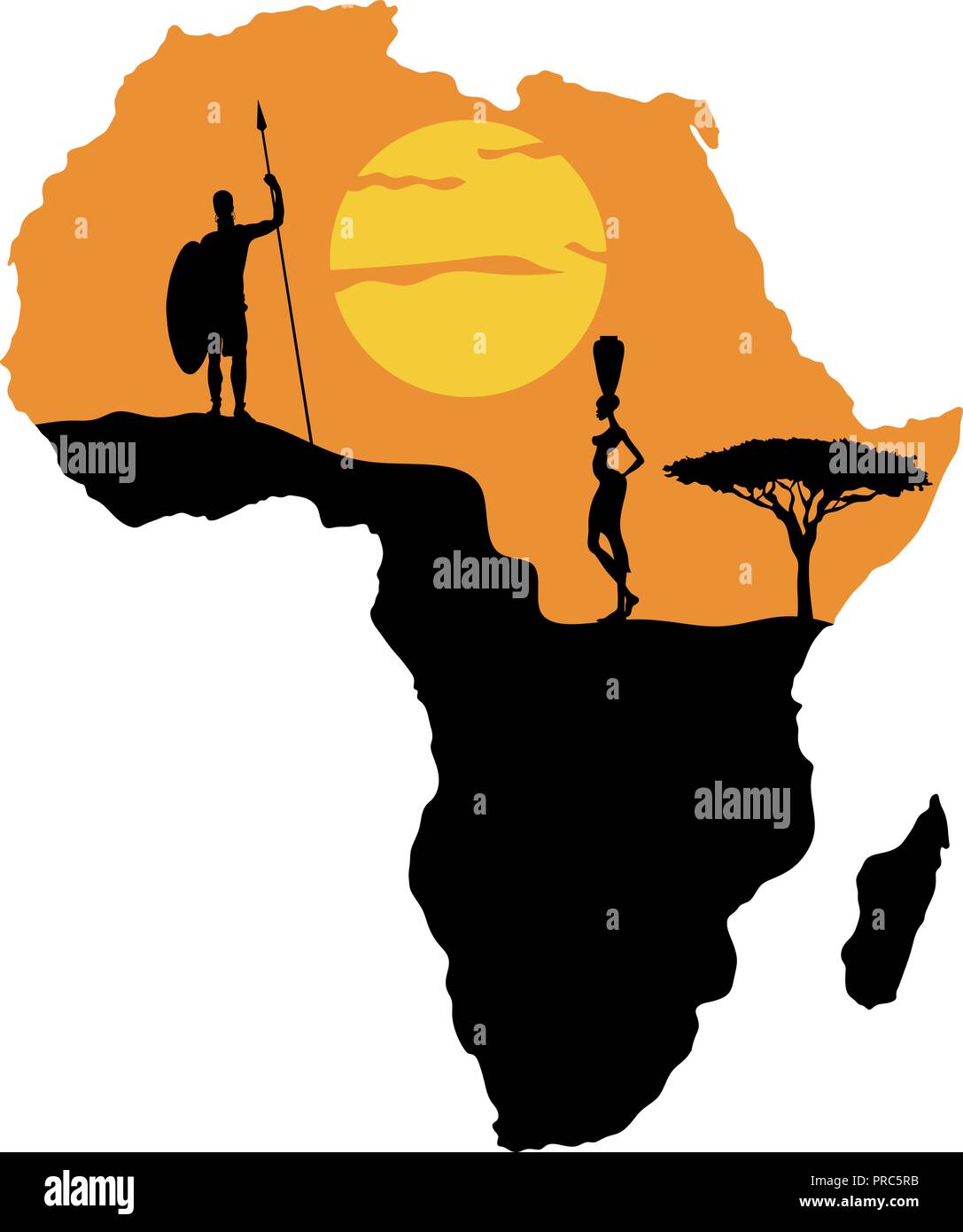Quick filters:
Sudan warrior Stock Photos and Images
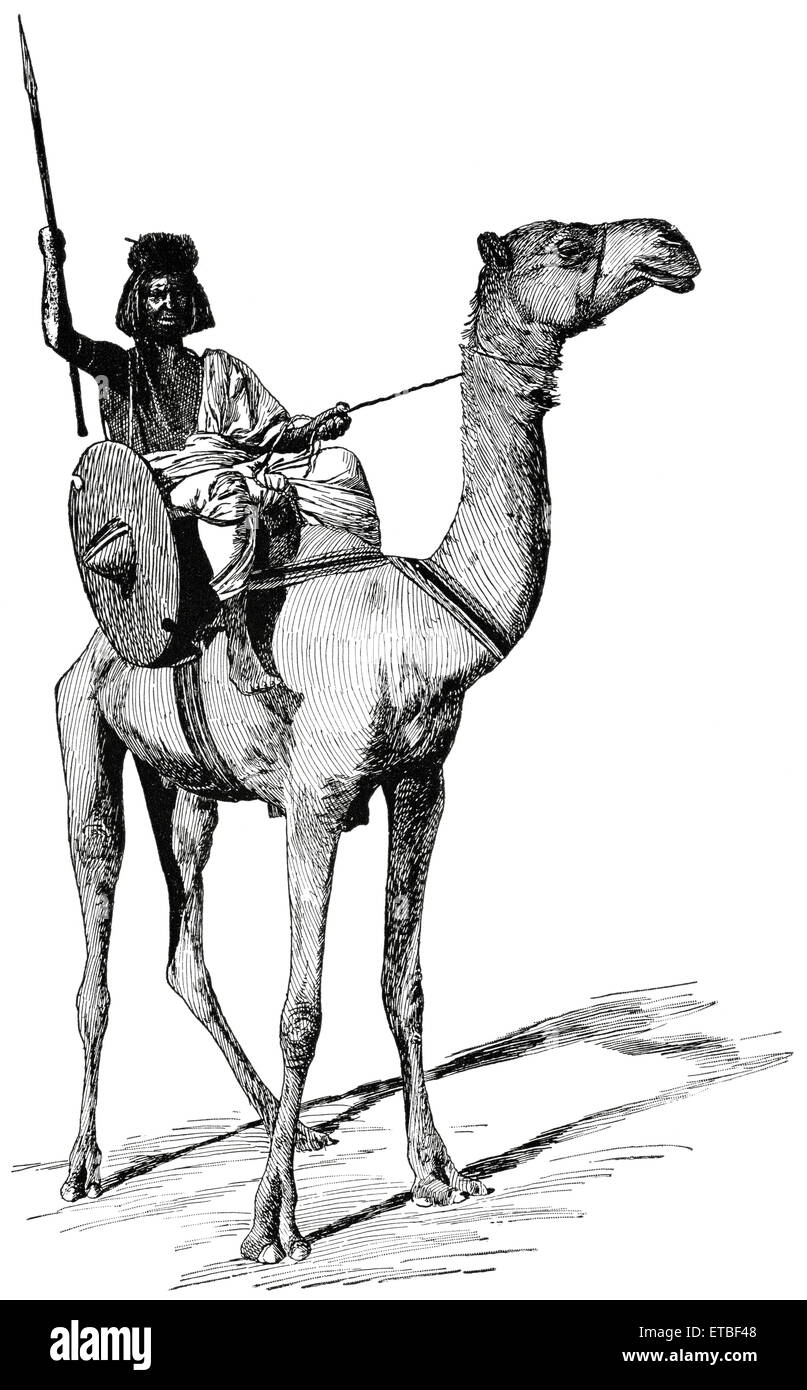 Sudanese Warrior on Camel, Sudan, 'Classical Portfolio of Primitive Carriers', by Marshall M. Kirman, World Railway Publ. Co., Illustration, 1895 Stock Photohttps://www.alamy.com/image-license-details/?v=1https://www.alamy.com/stock-photo-sudanese-warrior-on-camel-sudan-classical-portfolio-of-primitive-carriers-83846568.html
Sudanese Warrior on Camel, Sudan, 'Classical Portfolio of Primitive Carriers', by Marshall M. Kirman, World Railway Publ. Co., Illustration, 1895 Stock Photohttps://www.alamy.com/image-license-details/?v=1https://www.alamy.com/stock-photo-sudanese-warrior-on-camel-sudan-classical-portfolio-of-primitive-carriers-83846568.htmlRMETBF48–Sudanese Warrior on Camel, Sudan, 'Classical Portfolio of Primitive Carriers', by Marshall M. Kirman, World Railway Publ. Co., Illustration, 1895
 Beja Tribe Men Dancing In Front Of The Khatmiyah Mosque At The Base Of The Taka Mountains, Kassala, Sudan Stock Photohttps://www.alamy.com/image-license-details/?v=1https://www.alamy.com/stock-photo-beja-tribe-men-dancing-in-front-of-the-khatmiyah-mosque-at-the-base-55549768.html
Beja Tribe Men Dancing In Front Of The Khatmiyah Mosque At The Base Of The Taka Mountains, Kassala, Sudan Stock Photohttps://www.alamy.com/image-license-details/?v=1https://www.alamy.com/stock-photo-beja-tribe-men-dancing-in-front-of-the-khatmiyah-mosque-at-the-base-55549768.htmlRMD6AE88–Beja Tribe Men Dancing In Front Of The Khatmiyah Mosque At The Base Of The Taka Mountains, Kassala, Sudan
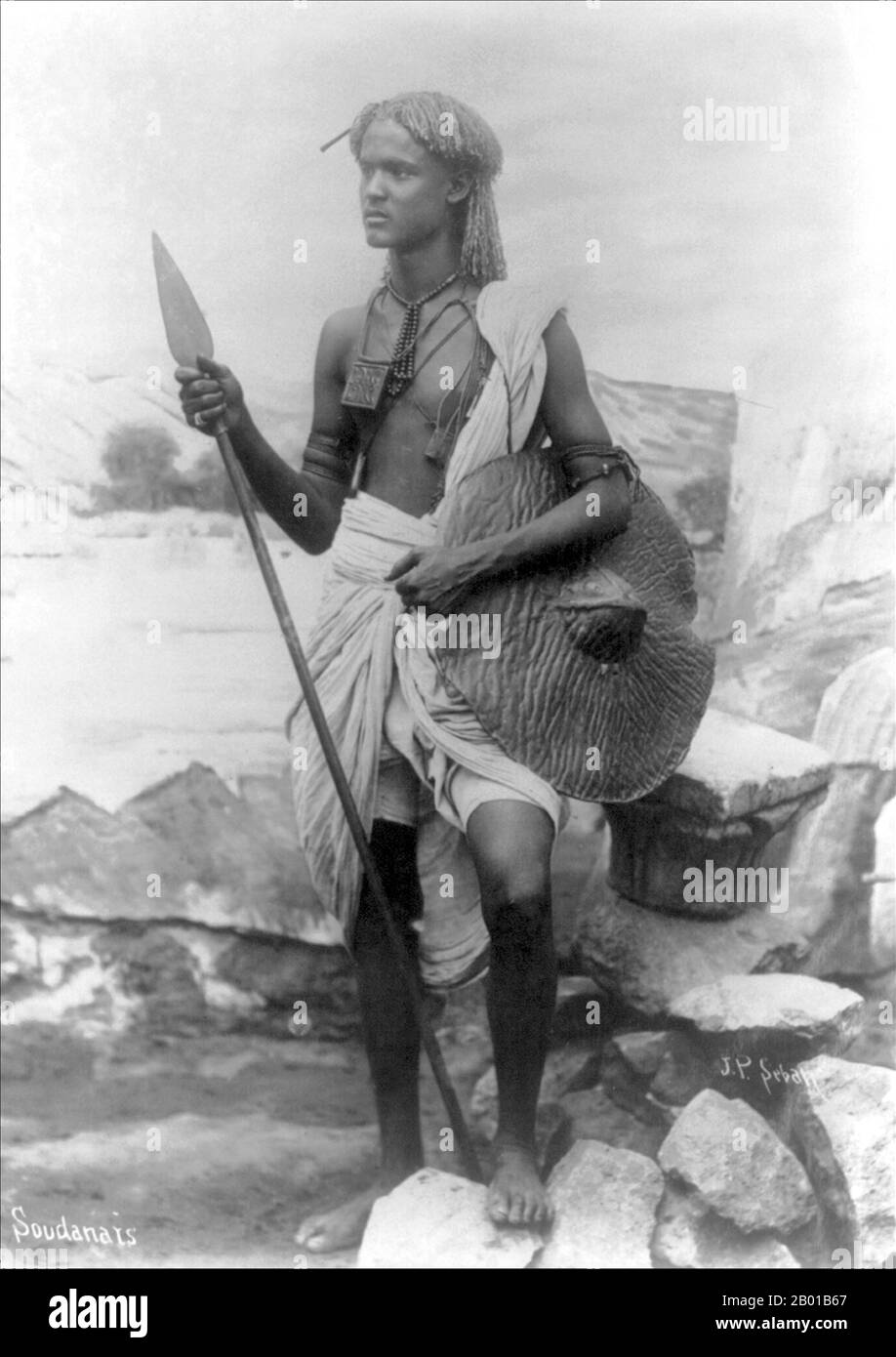 Sudan: A Sudanese warrior. Photo by Jean Pascal Sebah (1872 - 6 June 1947), c. 1920-1930. The Republic of Sudan is a country in North Africa. It is bordered by Egypt to the north, the Red Sea to the northeast, Eritrea and Ethiopia to the east, South Sudan to the south, the Central African Republic to the southwest, Chad to the west and Libya to the northwest. The world's longest river, the Nile, divides the country between east and west sides. Stock Photohttps://www.alamy.com/image-license-details/?v=1https://www.alamy.com/sudan-a-sudanese-warrior-photo-by-jean-pascal-sebah-1872-6-june-1947-c-1920-1930-the-republic-of-sudan-is-a-country-in-north-africa-it-is-bordered-by-egypt-to-the-north-the-red-sea-to-the-northeast-eritrea-and-ethiopia-to-the-east-south-sudan-to-the-south-the-central-african-republic-to-the-southwest-chad-to-the-west-and-libya-to-the-northwest-the-worlds-longest-river-the-nile-divides-the-country-between-east-and-west-sides-image344238111.html
Sudan: A Sudanese warrior. Photo by Jean Pascal Sebah (1872 - 6 June 1947), c. 1920-1930. The Republic of Sudan is a country in North Africa. It is bordered by Egypt to the north, the Red Sea to the northeast, Eritrea and Ethiopia to the east, South Sudan to the south, the Central African Republic to the southwest, Chad to the west and Libya to the northwest. The world's longest river, the Nile, divides the country between east and west sides. Stock Photohttps://www.alamy.com/image-license-details/?v=1https://www.alamy.com/sudan-a-sudanese-warrior-photo-by-jean-pascal-sebah-1872-6-june-1947-c-1920-1930-the-republic-of-sudan-is-a-country-in-north-africa-it-is-bordered-by-egypt-to-the-north-the-red-sea-to-the-northeast-eritrea-and-ethiopia-to-the-east-south-sudan-to-the-south-the-central-african-republic-to-the-southwest-chad-to-the-west-and-libya-to-the-northwest-the-worlds-longest-river-the-nile-divides-the-country-between-east-and-west-sides-image344238111.htmlRM2B01B67–Sudan: A Sudanese warrior. Photo by Jean Pascal Sebah (1872 - 6 June 1947), c. 1920-1930. The Republic of Sudan is a country in North Africa. It is bordered by Egypt to the north, the Red Sea to the northeast, Eritrea and Ethiopia to the east, South Sudan to the south, the Central African Republic to the southwest, Chad to the west and Libya to the northwest. The world's longest river, the Nile, divides the country between east and west sides.
 Sudan warrior. 1920-1930 Stock Photohttps://www.alamy.com/image-license-details/?v=1https://www.alamy.com/sudan-warrior-1920-1930-image330277124.html
Sudan warrior. 1920-1930 Stock Photohttps://www.alamy.com/image-license-details/?v=1https://www.alamy.com/sudan-warrior-1920-1930-image330277124.htmlRM2A59BRG–Sudan warrior. 1920-1930
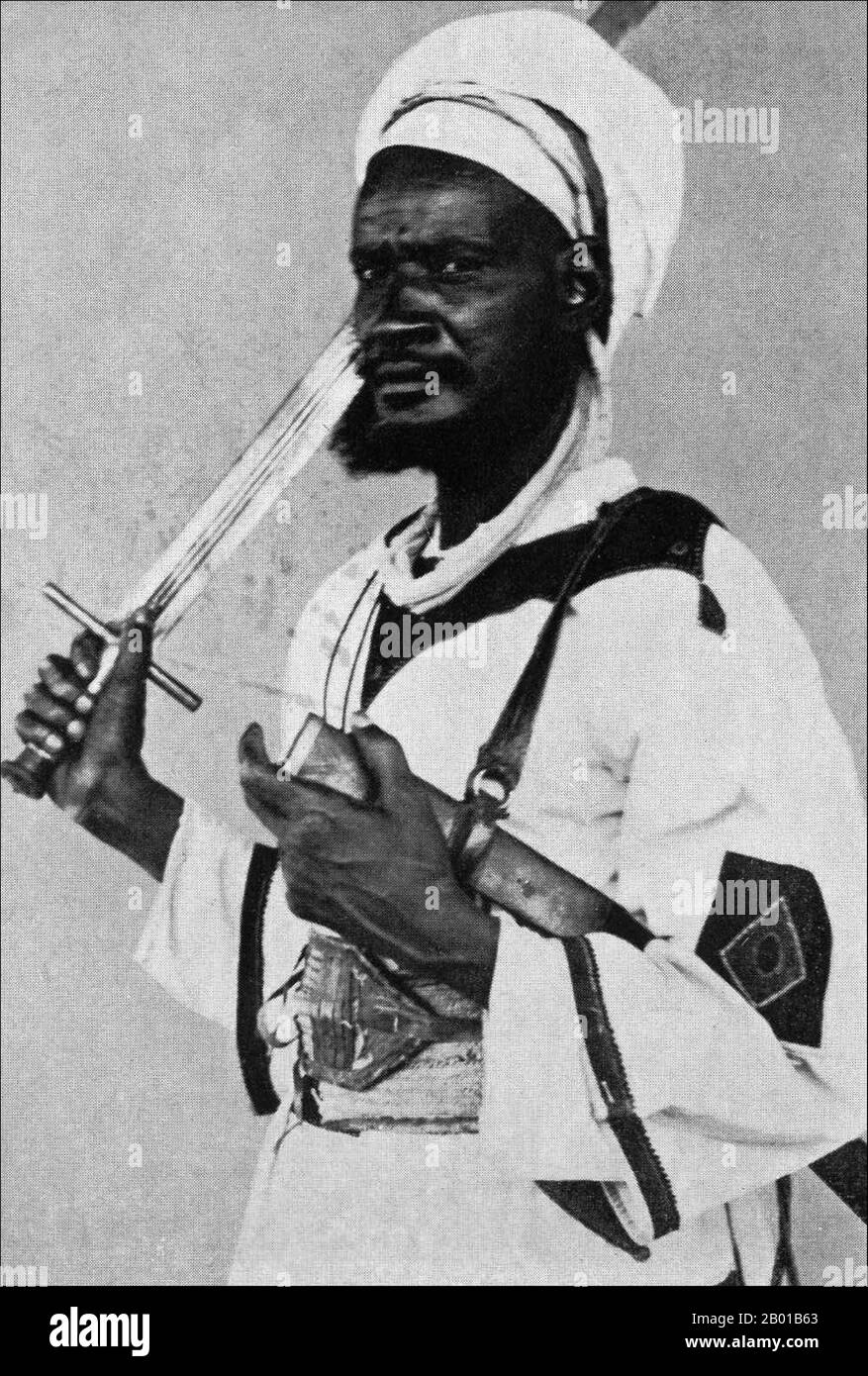 Sudan: A Mahdist warrior, early 20th century. Muhammad Ahmad bin Abd Allah (12 August 1844 - 22 June 1885) was a religious leader of the Samaniyya order in Sudan who, on June 29, 1881, proclaimed himself as the Mahdi or messianic redeemer of the Islamic faith. His proclamation came during a period of widespread resentment among the Sudanese population of the oppressive policies of the Turco-Egyptian rulers, and capitalised on the messianic beliefs popular among the various Sudanese religious sects of the time. Stock Photohttps://www.alamy.com/image-license-details/?v=1https://www.alamy.com/sudan-a-mahdist-warrior-early-20th-century-muhammad-ahmad-bin-abd-allah-12-august-1844-22-june-1885-was-a-religious-leader-of-the-samaniyya-order-in-sudan-who-on-june-29-1881-proclaimed-himself-as-the-mahdi-or-messianic-redeemer-of-the-islamic-faith-his-proclamation-came-during-a-period-of-widespread-resentment-among-the-sudanese-population-of-the-oppressive-policies-of-the-turco-egyptian-rulers-and-capitalised-on-the-messianic-beliefs-popular-among-the-various-sudanese-religious-sects-of-the-time-image344238107.html
Sudan: A Mahdist warrior, early 20th century. Muhammad Ahmad bin Abd Allah (12 August 1844 - 22 June 1885) was a religious leader of the Samaniyya order in Sudan who, on June 29, 1881, proclaimed himself as the Mahdi or messianic redeemer of the Islamic faith. His proclamation came during a period of widespread resentment among the Sudanese population of the oppressive policies of the Turco-Egyptian rulers, and capitalised on the messianic beliefs popular among the various Sudanese religious sects of the time. Stock Photohttps://www.alamy.com/image-license-details/?v=1https://www.alamy.com/sudan-a-mahdist-warrior-early-20th-century-muhammad-ahmad-bin-abd-allah-12-august-1844-22-june-1885-was-a-religious-leader-of-the-samaniyya-order-in-sudan-who-on-june-29-1881-proclaimed-himself-as-the-mahdi-or-messianic-redeemer-of-the-islamic-faith-his-proclamation-came-during-a-period-of-widespread-resentment-among-the-sudanese-population-of-the-oppressive-policies-of-the-turco-egyptian-rulers-and-capitalised-on-the-messianic-beliefs-popular-among-the-various-sudanese-religious-sects-of-the-time-image344238107.htmlRM2B01B63–Sudan: A Mahdist warrior, early 20th century. Muhammad Ahmad bin Abd Allah (12 August 1844 - 22 June 1885) was a religious leader of the Samaniyya order in Sudan who, on June 29, 1881, proclaimed himself as the Mahdi or messianic redeemer of the Islamic faith. His proclamation came during a period of widespread resentment among the Sudanese population of the oppressive policies of the Turco-Egyptian rulers, and capitalised on the messianic beliefs popular among the various Sudanese religious sects of the time.
 Shilluk warrior, South Sudan Stock Photohttps://www.alamy.com/image-license-details/?v=1https://www.alamy.com/stock-photo-shilluk-warrior-south-sudan-131056642.html
Shilluk warrior, South Sudan Stock Photohttps://www.alamy.com/image-license-details/?v=1https://www.alamy.com/stock-photo-shilluk-warrior-south-sudan-131056642.htmlRMHH642A–Shilluk warrior, South Sudan
![Soudan [Sudan] Warrior from the book Stanley in Africa. The wonderful discoveries and thrilling adventures of the great African explorer, and other travelers, pioneers and missionaries by James Penny Boyd, Publisher: Philadelphia, Pa.; St. Louis, Mo., P. W. Ziegler & co in 1889 Stock Photo Soudan [Sudan] Warrior from the book Stanley in Africa. The wonderful discoveries and thrilling adventures of the great African explorer, and other travelers, pioneers and missionaries by James Penny Boyd, Publisher: Philadelphia, Pa.; St. Louis, Mo., P. W. Ziegler & co in 1889 Stock Photo](https://c8.alamy.com/comp/2HJBBR7/soudan-sudan-warrior-from-the-book-stanley-in-africa-the-wonderful-discoveries-and-thrilling-adventures-of-the-great-african-explorer-and-other-travelers-pioneers-and-missionaries-by-james-penny-boyd-publisher-philadelphia-pa-st-louis-mo-p-w-ziegler-co-in-1889-2HJBBR7.jpg) Soudan [Sudan] Warrior from the book Stanley in Africa. The wonderful discoveries and thrilling adventures of the great African explorer, and other travelers, pioneers and missionaries by James Penny Boyd, Publisher: Philadelphia, Pa.; St. Louis, Mo., P. W. Ziegler & co in 1889 Stock Photohttps://www.alamy.com/image-license-details/?v=1https://www.alamy.com/soudan-sudan-warrior-from-the-book-stanley-in-africa-the-wonderful-discoveries-and-thrilling-adventures-of-the-great-african-explorer-and-other-travelers-pioneers-and-missionaries-by-james-penny-boyd-publisher-philadelphia-pa-st-louis-mo-p-w-ziegler-co-in-1889-image458784123.html
Soudan [Sudan] Warrior from the book Stanley in Africa. The wonderful discoveries and thrilling adventures of the great African explorer, and other travelers, pioneers and missionaries by James Penny Boyd, Publisher: Philadelphia, Pa.; St. Louis, Mo., P. W. Ziegler & co in 1889 Stock Photohttps://www.alamy.com/image-license-details/?v=1https://www.alamy.com/soudan-sudan-warrior-from-the-book-stanley-in-africa-the-wonderful-discoveries-and-thrilling-adventures-of-the-great-african-explorer-and-other-travelers-pioneers-and-missionaries-by-james-penny-boyd-publisher-philadelphia-pa-st-louis-mo-p-w-ziegler-co-in-1889-image458784123.htmlRF2HJBBR7–Soudan [Sudan] Warrior from the book Stanley in Africa. The wonderful discoveries and thrilling adventures of the great African explorer, and other travelers, pioneers and missionaries by James Penny Boyd, Publisher: Philadelphia, Pa.; St. Louis, Mo., P. W. Ziegler & co in 1889
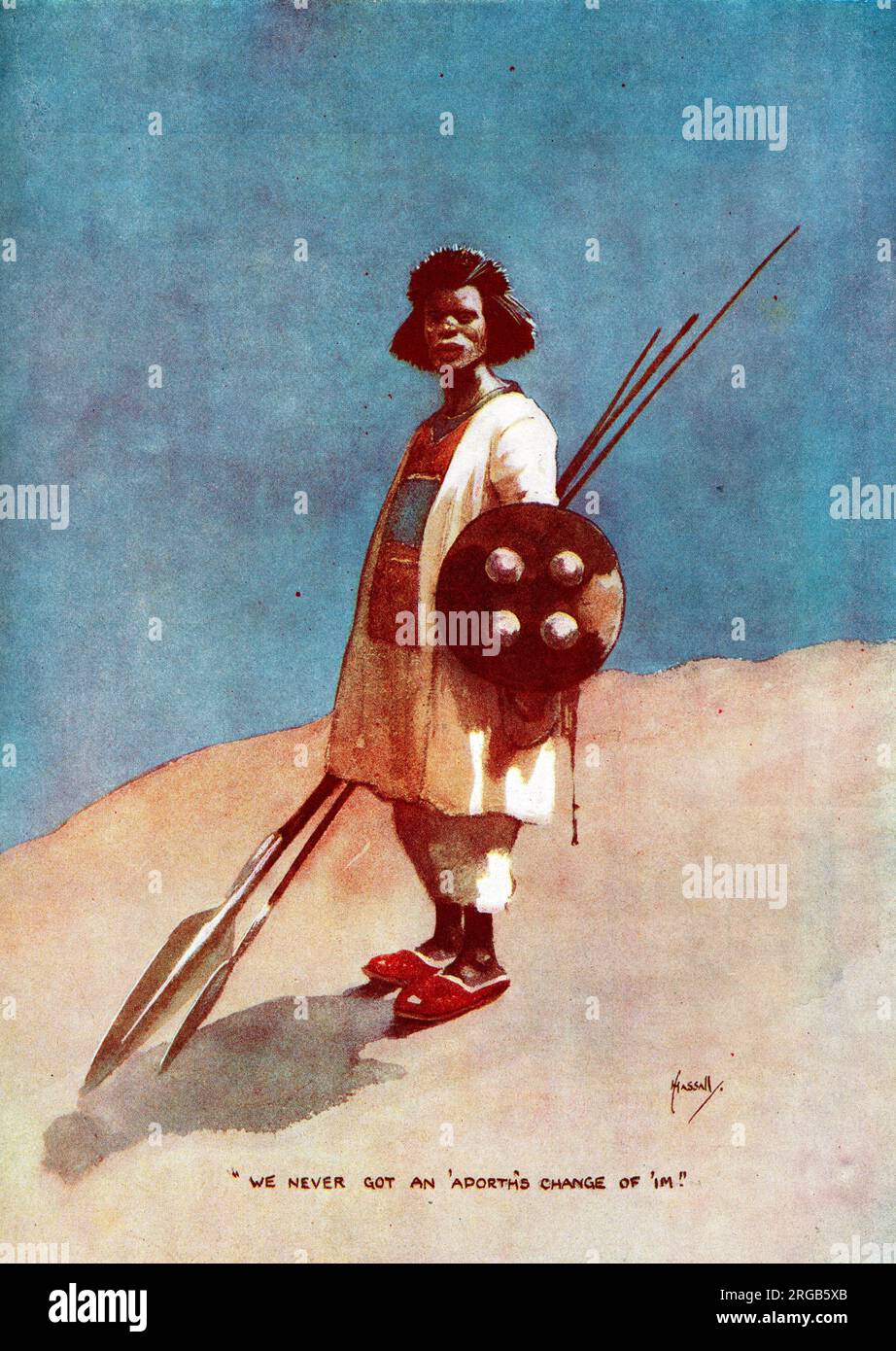 Hadendoa Warrior, Sudan - Fuzzy-Wuzzy by John Hassall - Union Jack Club Stock Photohttps://www.alamy.com/image-license-details/?v=1https://www.alamy.com/hadendoa-warrior-sudan-fuzzy-wuzzy-by-john-hassall-union-jack-club-image560812403.html
Hadendoa Warrior, Sudan - Fuzzy-Wuzzy by John Hassall - Union Jack Club Stock Photohttps://www.alamy.com/image-license-details/?v=1https://www.alamy.com/hadendoa-warrior-sudan-fuzzy-wuzzy-by-john-hassall-union-jack-club-image560812403.htmlRM2RGB5XB–Hadendoa Warrior, Sudan - Fuzzy-Wuzzy by John Hassall - Union Jack Club
 Mali: A 'young Sudanese warrior' (from the former French Soudan), early 20th century. French Sudan was a colony in French West Africa that had two separate periods of existence, first from 1890 to 1899, then from 1920 to 1960, when the territory became the independent nation of Mali. Stock Photohttps://www.alamy.com/image-license-details/?v=1https://www.alamy.com/mali-a-young-sudanese-warrior-from-the-former-french-soudan-early-20th-century-french-sudan-was-a-colony-in-french-west-africa-that-had-two-separate-periods-of-existence-first-from-1890-to-1899-then-from-1920-to-1960-when-the-territory-became-the-independent-nation-of-mali-image344248196.html
Mali: A 'young Sudanese warrior' (from the former French Soudan), early 20th century. French Sudan was a colony in French West Africa that had two separate periods of existence, first from 1890 to 1899, then from 1920 to 1960, when the territory became the independent nation of Mali. Stock Photohttps://www.alamy.com/image-license-details/?v=1https://www.alamy.com/mali-a-young-sudanese-warrior-from-the-former-french-soudan-early-20th-century-french-sudan-was-a-colony-in-french-west-africa-that-had-two-separate-periods-of-existence-first-from-1890-to-1899-then-from-1920-to-1960-when-the-territory-became-the-independent-nation-of-mali-image344248196.htmlRM2B01T2C–Mali: A 'young Sudanese warrior' (from the former French Soudan), early 20th century. French Sudan was a colony in French West Africa that had two separate periods of existence, first from 1890 to 1899, then from 1920 to 1960, when the territory became the independent nation of Mali.
 A Shilluk Warrior - Upper Nile, Sudan, Africa - posing in a pretty laid-back stance resting on his long spear. Stock Photohttps://www.alamy.com/image-license-details/?v=1https://www.alamy.com/a-shilluk-warrior-upper-nile-sudan-africa-posing-in-a-pretty-laid-back-stance-resting-on-his-long-spear-image485681695.html
A Shilluk Warrior - Upper Nile, Sudan, Africa - posing in a pretty laid-back stance resting on his long spear. Stock Photohttps://www.alamy.com/image-license-details/?v=1https://www.alamy.com/a-shilluk-warrior-upper-nile-sudan-africa-posing-in-a-pretty-laid-back-stance-resting-on-his-long-spear-image485681695.htmlRM2K64KXR–A Shilluk Warrior - Upper Nile, Sudan, Africa - posing in a pretty laid-back stance resting on his long spear.
 . English: Sudan warrior - Native types of Africa. 192? . between 1920 and 1930. Frank and Frances Carpenter 60 Sudan warrior 1920 Stock Photohttps://www.alamy.com/image-license-details/?v=1https://www.alamy.com/english-sudan-warrior-native-types-of-africa-192-between-1920-and-1930-frank-and-frances-carpenter-60-sudan-warrior-1920-image208057987.html
. English: Sudan warrior - Native types of Africa. 192? . between 1920 and 1930. Frank and Frances Carpenter 60 Sudan warrior 1920 Stock Photohttps://www.alamy.com/image-license-details/?v=1https://www.alamy.com/english-sudan-warrior-native-types-of-africa-192-between-1920-and-1930-frank-and-frances-carpenter-60-sudan-warrior-1920-image208057987.htmlRMP2DT2B–. English: Sudan warrior - Native types of Africa. 192? . between 1920 and 1930. Frank and Frances Carpenter 60 Sudan warrior 1920
 A Shilluk Warrior - Upper Nile, Sudan, Africa Stock Photohttps://www.alamy.com/image-license-details/?v=1https://www.alamy.com/a-shilluk-warrior-upper-nile-sudan-africa-image66159378.html
A Shilluk Warrior - Upper Nile, Sudan, Africa Stock Photohttps://www.alamy.com/image-license-details/?v=1https://www.alamy.com/a-shilluk-warrior-upper-nile-sudan-africa-image66159378.htmlRMDRHPXX–A Shilluk Warrior - Upper Nile, Sudan, Africa
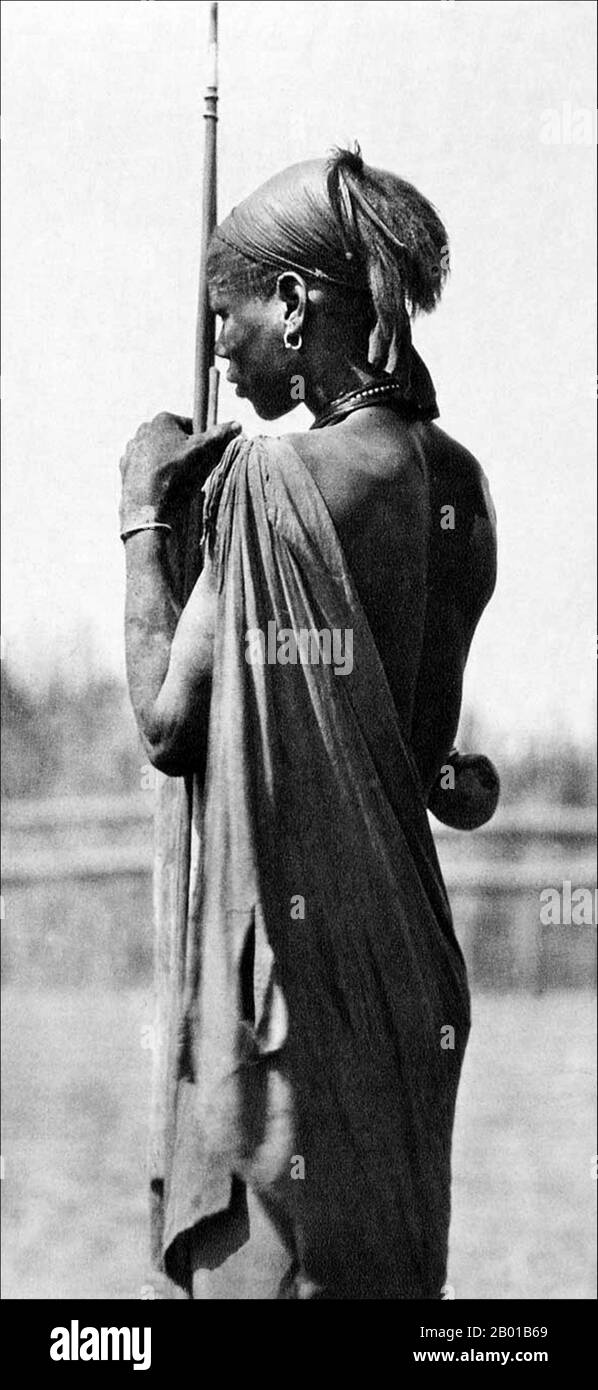 Sudan/South Sudan: A Shilluk or Chollo warrior. Photo by Hugo Adolf Bernatzik (26 March 1897 - 9 March 1953), 1930. The Shilluk, who prefer to be known as Chollo, are a major Nilotic ethnic group of southern Sudan, living on both banks of the river Nile, in the vicinity of the city of Malakal. The most extensive Chollo area is located on the western bank of the Nile north from Malakal. Before the second Sudanese civil war the Chollo also lived in a number of settlements on the northern bank of the Sobat river. The Shilluk are the third largest minority ethnic group of southern Sudan. Stock Photohttps://www.alamy.com/image-license-details/?v=1https://www.alamy.com/sudansouth-sudan-a-shilluk-or-chollo-warrior-photo-by-hugo-adolf-bernatzik-26-march-1897-9-march-1953-1930-the-shilluk-who-prefer-to-be-known-as-chollo-are-a-major-nilotic-ethnic-group-of-southern-sudan-living-on-both-banks-of-the-river-nile-in-the-vicinity-of-the-city-of-malakal-the-most-extensive-chollo-area-is-located-on-the-western-bank-of-the-nile-north-from-malakal-before-the-second-sudanese-civil-war-the-chollo-also-lived-in-a-number-of-settlements-on-the-northern-bank-of-the-sobat-river-the-shilluk-are-the-third-largest-minority-ethnic-group-of-southern-sudan-image344238113.html
Sudan/South Sudan: A Shilluk or Chollo warrior. Photo by Hugo Adolf Bernatzik (26 March 1897 - 9 March 1953), 1930. The Shilluk, who prefer to be known as Chollo, are a major Nilotic ethnic group of southern Sudan, living on both banks of the river Nile, in the vicinity of the city of Malakal. The most extensive Chollo area is located on the western bank of the Nile north from Malakal. Before the second Sudanese civil war the Chollo also lived in a number of settlements on the northern bank of the Sobat river. The Shilluk are the third largest minority ethnic group of southern Sudan. Stock Photohttps://www.alamy.com/image-license-details/?v=1https://www.alamy.com/sudansouth-sudan-a-shilluk-or-chollo-warrior-photo-by-hugo-adolf-bernatzik-26-march-1897-9-march-1953-1930-the-shilluk-who-prefer-to-be-known-as-chollo-are-a-major-nilotic-ethnic-group-of-southern-sudan-living-on-both-banks-of-the-river-nile-in-the-vicinity-of-the-city-of-malakal-the-most-extensive-chollo-area-is-located-on-the-western-bank-of-the-nile-north-from-malakal-before-the-second-sudanese-civil-war-the-chollo-also-lived-in-a-number-of-settlements-on-the-northern-bank-of-the-sobat-river-the-shilluk-are-the-third-largest-minority-ethnic-group-of-southern-sudan-image344238113.htmlRM2B01B69–Sudan/South Sudan: A Shilluk or Chollo warrior. Photo by Hugo Adolf Bernatzik (26 March 1897 - 9 March 1953), 1930. The Shilluk, who prefer to be known as Chollo, are a major Nilotic ethnic group of southern Sudan, living on both banks of the river Nile, in the vicinity of the city of Malakal. The most extensive Chollo area is located on the western bank of the Nile north from Malakal. Before the second Sudanese civil war the Chollo also lived in a number of settlements on the northern bank of the Sobat river. The Shilluk are the third largest minority ethnic group of southern Sudan.
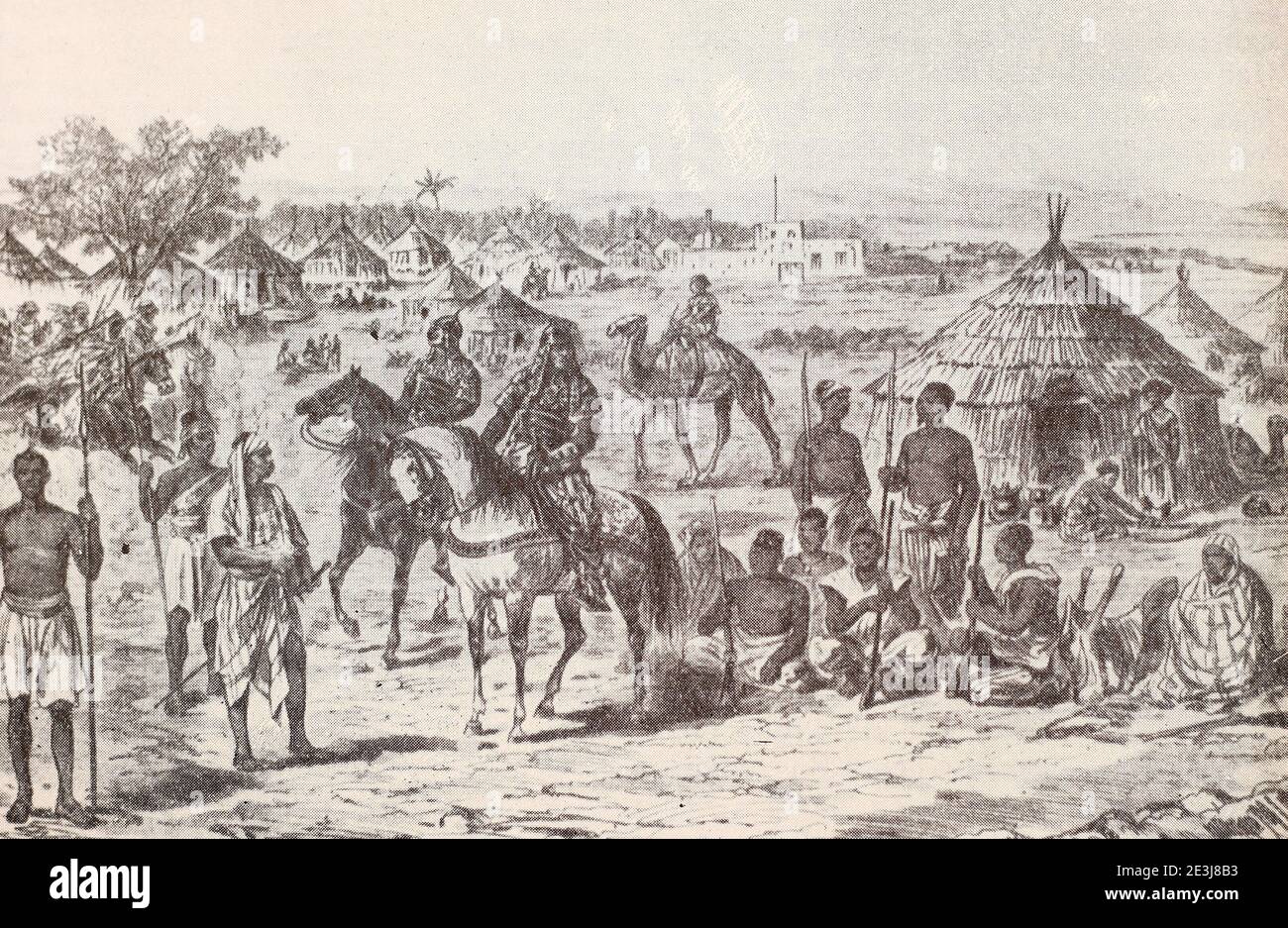 Mahdi camp in El-Obeid. Engraving of 1883. Stock Photohttps://www.alamy.com/image-license-details/?v=1https://www.alamy.com/mahdi-camp-in-el-obeid-engraving-of-1883-image398084151.html
Mahdi camp in El-Obeid. Engraving of 1883. Stock Photohttps://www.alamy.com/image-license-details/?v=1https://www.alamy.com/mahdi-camp-in-el-obeid-engraving-of-1883-image398084151.htmlRM2E3J8B3–Mahdi camp in El-Obeid. Engraving of 1883.
 In a small town of Malual kon in south Sudan, the SPLA (Sudanese People Liberation Army) takes part in a Peace Rally to demonstrate their acceptance of the Peace Agreement by laying down their arms. Stock Photohttps://www.alamy.com/image-license-details/?v=1https://www.alamy.com/in-a-small-town-of-malual-kon-in-south-sudan-the-spla-sudanese-people-liberation-army-takes-part-in-a-peace-rally-to-demonstrate-their-acceptance-of-the-peace-agreement-by-laying-down-their-arms-image245764902.html
In a small town of Malual kon in south Sudan, the SPLA (Sudanese People Liberation Army) takes part in a Peace Rally to demonstrate their acceptance of the Peace Agreement by laying down their arms. Stock Photohttps://www.alamy.com/image-license-details/?v=1https://www.alamy.com/in-a-small-town-of-malual-kon-in-south-sudan-the-spla-sudanese-people-liberation-army-takes-part-in-a-peace-rally-to-demonstrate-their-acceptance-of-the-peace-agreement-by-laying-down-their-arms-image245764902.htmlRMT7RFHX–In a small town of Malual kon in south Sudan, the SPLA (Sudanese People Liberation Army) takes part in a Peace Rally to demonstrate their acceptance of the Peace Agreement by laying down their arms.
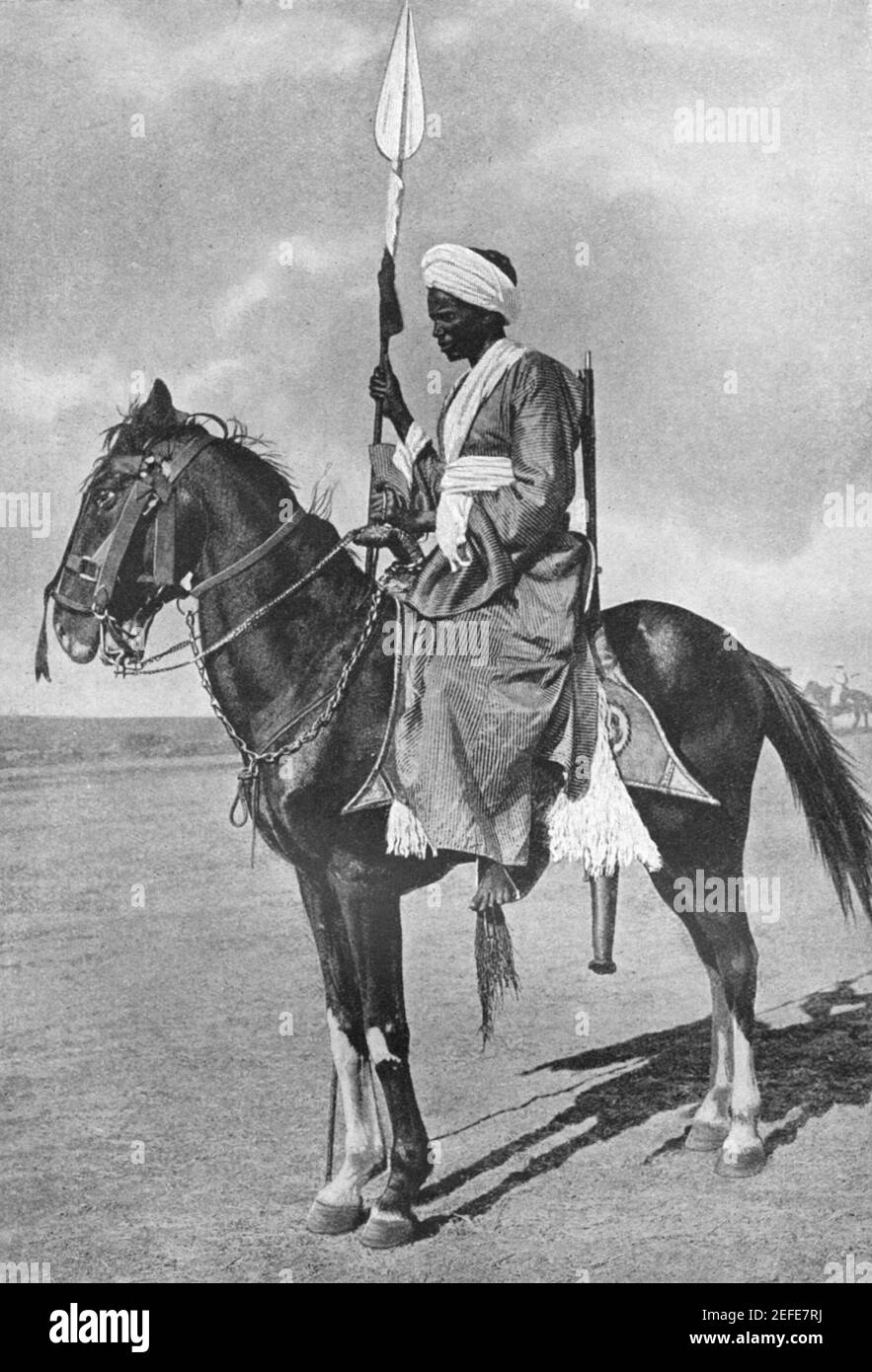 Early 20th century photo of a sheikh of a Sudanese tribe on horse back armed with a spear circa early 1900s Stock Photohttps://www.alamy.com/image-license-details/?v=1https://www.alamy.com/early-20th-century-photo-of-a-sheikh-of-a-sudanese-tribe-on-horse-back-armed-with-a-spear-circa-early-1900s-image405371782.html
Early 20th century photo of a sheikh of a Sudanese tribe on horse back armed with a spear circa early 1900s Stock Photohttps://www.alamy.com/image-license-details/?v=1https://www.alamy.com/early-20th-century-photo-of-a-sheikh-of-a-sudanese-tribe-on-horse-back-armed-with-a-spear-circa-early-1900s-image405371782.htmlRM2EFE7RJ–Early 20th century photo of a sheikh of a Sudanese tribe on horse back armed with a spear circa early 1900s
 A patriotic subjects of his majesty A picture from Sudan showing a native warrior with his home fashioned instrument , playing ' God save the King ' 16 January 1926 Stock Photohttps://www.alamy.com/image-license-details/?v=1https://www.alamy.com/a-patriotic-subjects-of-his-majesty-a-picture-from-sudan-showing-a-native-warrior-with-his-home-fashioned-instrument-playing-god-save-the-king-16-january-1926-image359833639.html
A patriotic subjects of his majesty A picture from Sudan showing a native warrior with his home fashioned instrument , playing ' God save the King ' 16 January 1926 Stock Photohttps://www.alamy.com/image-license-details/?v=1https://www.alamy.com/a-patriotic-subjects-of-his-majesty-a-picture-from-sudan-showing-a-native-warrior-with-his-home-fashioned-instrument-playing-god-save-the-king-16-january-1926-image359833639.htmlRM2BWBRDB–A patriotic subjects of his majesty A picture from Sudan showing a native warrior with his home fashioned instrument , playing ' God save the King ' 16 January 1926
 Visit the Sudan Stock Photohttps://www.alamy.com/image-license-details/?v=1https://www.alamy.com/stock-image-visit-the-sudan-169357877.html
Visit the Sudan Stock Photohttps://www.alamy.com/image-license-details/?v=1https://www.alamy.com/stock-image-visit-the-sudan-169357877.htmlRMKREWKH–Visit the Sudan
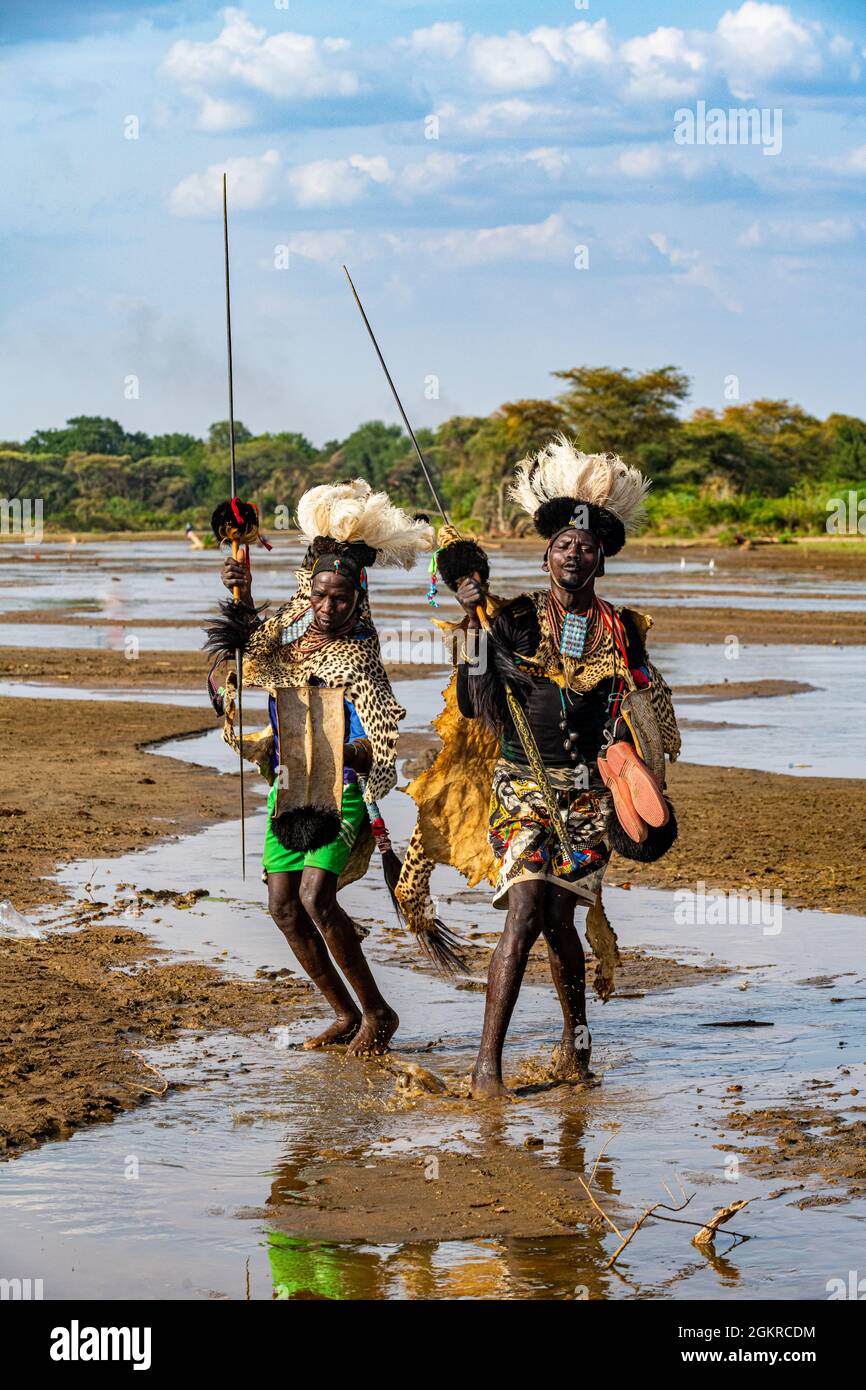 Men from the Toposa tribe posing in their traditional warrior costume, Eastern Equatoria, South Sudan, Africa Stock Photohttps://www.alamy.com/image-license-details/?v=1https://www.alamy.com/men-from-the-toposa-tribe-posing-in-their-traditional-warrior-costume-eastern-equatoria-south-sudan-africa-image442452352.html
Men from the Toposa tribe posing in their traditional warrior costume, Eastern Equatoria, South Sudan, Africa Stock Photohttps://www.alamy.com/image-license-details/?v=1https://www.alamy.com/men-from-the-toposa-tribe-posing-in-their-traditional-warrior-costume-eastern-equatoria-south-sudan-africa-image442452352.htmlRF2GKRCDM–Men from the Toposa tribe posing in their traditional warrior costume, Eastern Equatoria, South Sudan, Africa
 A Rhizigat Warrior, circa 1883 Stock Photohttps://www.alamy.com/image-license-details/?v=1https://www.alamy.com/stock-image-a-rhizigat-warrior-circa-1883-164039660.html
A Rhizigat Warrior, circa 1883 Stock Photohttps://www.alamy.com/image-license-details/?v=1https://www.alamy.com/stock-image-a-rhizigat-warrior-circa-1883-164039660.htmlRMKETJ78–A Rhizigat Warrior, circa 1883
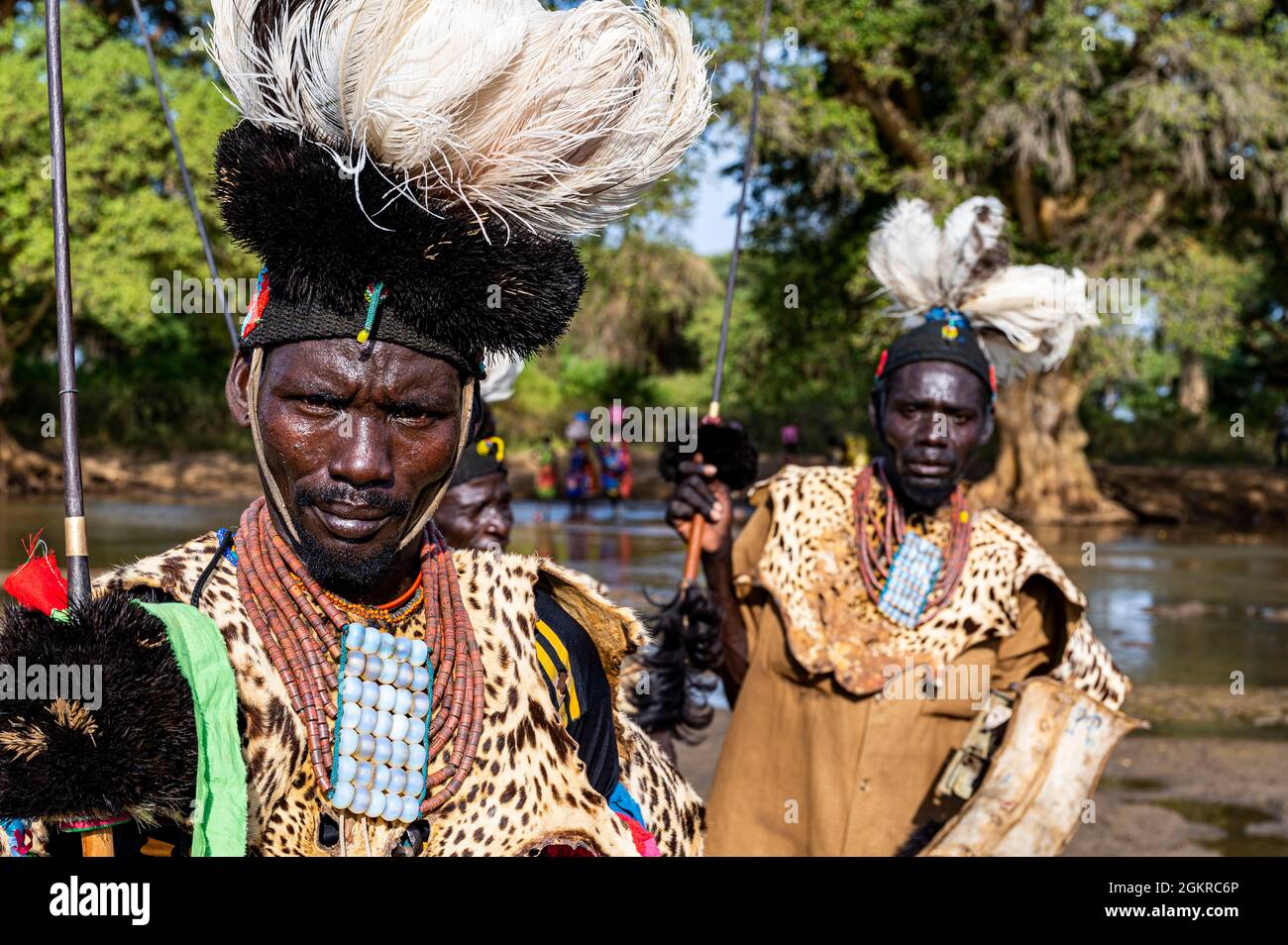 Men from the Toposa tribe posing in their traditional warrior costumes, Eastern Equatoria, South Sudan, Africa Stock Photohttps://www.alamy.com/image-license-details/?v=1https://www.alamy.com/men-from-the-toposa-tribe-posing-in-their-traditional-warrior-costumes-eastern-equatoria-south-sudan-africa-image442452158.html
Men from the Toposa tribe posing in their traditional warrior costumes, Eastern Equatoria, South Sudan, Africa Stock Photohttps://www.alamy.com/image-license-details/?v=1https://www.alamy.com/men-from-the-toposa-tribe-posing-in-their-traditional-warrior-costumes-eastern-equatoria-south-sudan-africa-image442452158.htmlRF2GKRC6P–Men from the Toposa tribe posing in their traditional warrior costumes, Eastern Equatoria, South Sudan, Africa
 SOUTH-SUDAN, Cuibet, Dinka warrior, shepherd with ash smeared face posing with soviet or russian made Kalashnikov machine gun AK-47 in cattle camp Stock Photohttps://www.alamy.com/image-license-details/?v=1https://www.alamy.com/stock-photo-south-sudan-cuibet-dinka-warrior-shepherd-with-ash-smeared-face-posing-28823380.html
SOUTH-SUDAN, Cuibet, Dinka warrior, shepherd with ash smeared face posing with soviet or russian made Kalashnikov machine gun AK-47 in cattle camp Stock Photohttps://www.alamy.com/image-license-details/?v=1https://www.alamy.com/stock-photo-south-sudan-cuibet-dinka-warrior-shepherd-with-ash-smeared-face-posing-28823380.htmlRMBJW0EC–SOUTH-SUDAN, Cuibet, Dinka warrior, shepherd with ash smeared face posing with soviet or russian made Kalashnikov machine gun AK-47 in cattle camp
 Sudan warrior. 1920-1930 Stock Photohttps://www.alamy.com/image-license-details/?v=1https://www.alamy.com/sudan-warrior-1920-1930-image214125497.html
Sudan warrior. 1920-1930 Stock Photohttps://www.alamy.com/image-license-details/?v=1https://www.alamy.com/sudan-warrior-1920-1930-image214125497.htmlRMPCA775–Sudan warrior. 1920-1930
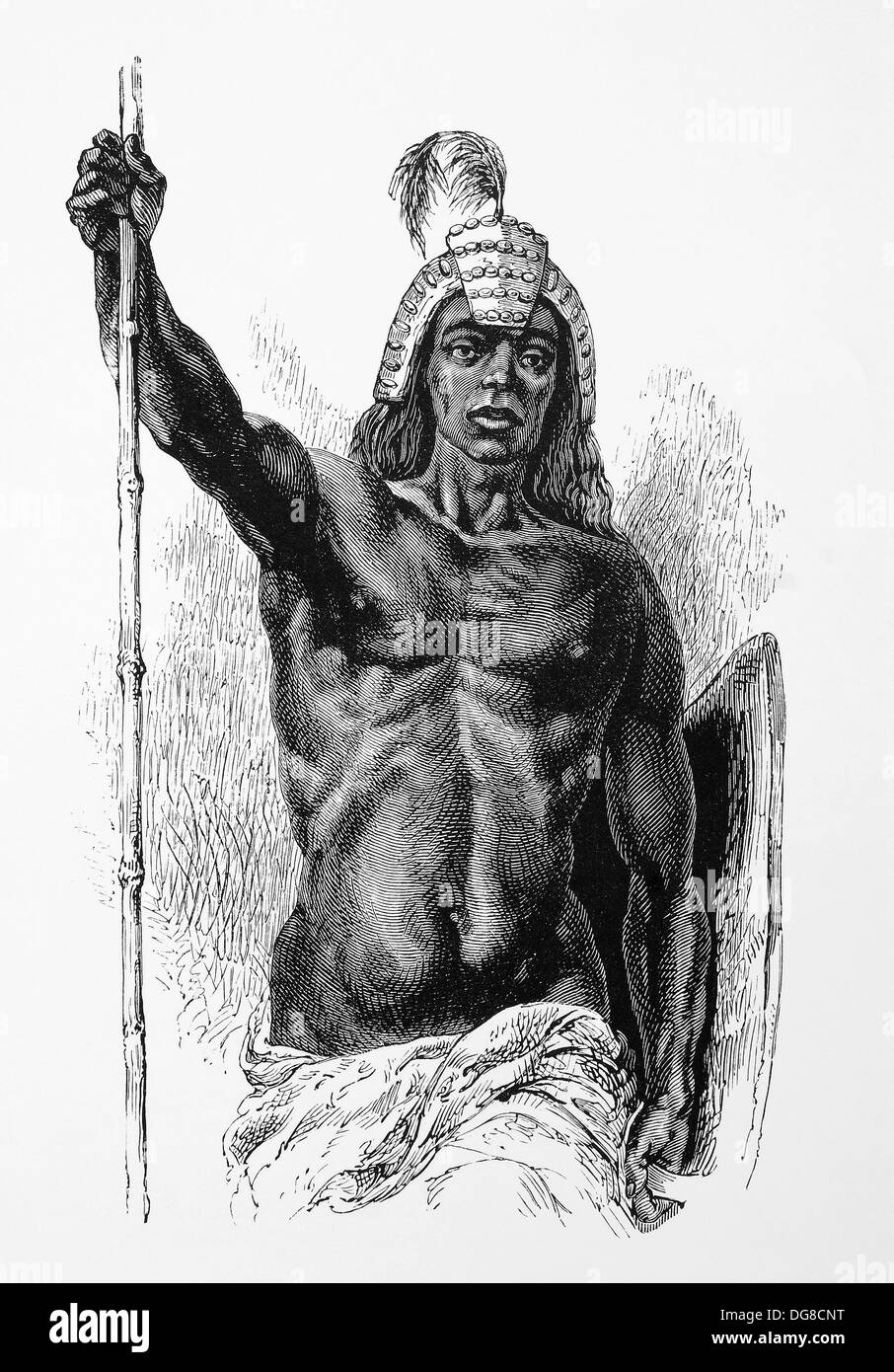 Africa. Sudan. Nuba chief, c. 1880. Engraving. 19th century. Stock Photohttps://www.alamy.com/image-license-details/?v=1https://www.alamy.com/africa-sudan-nuba-chief-c-1880-engraving-19th-century-image61651236.html
Africa. Sudan. Nuba chief, c. 1880. Engraving. 19th century. Stock Photohttps://www.alamy.com/image-license-details/?v=1https://www.alamy.com/africa-sudan-nuba-chief-c-1880-engraving-19th-century-image61651236.htmlRMDG8CNT–Africa. Sudan. Nuba chief, c. 1880. Engraving. 19th century.
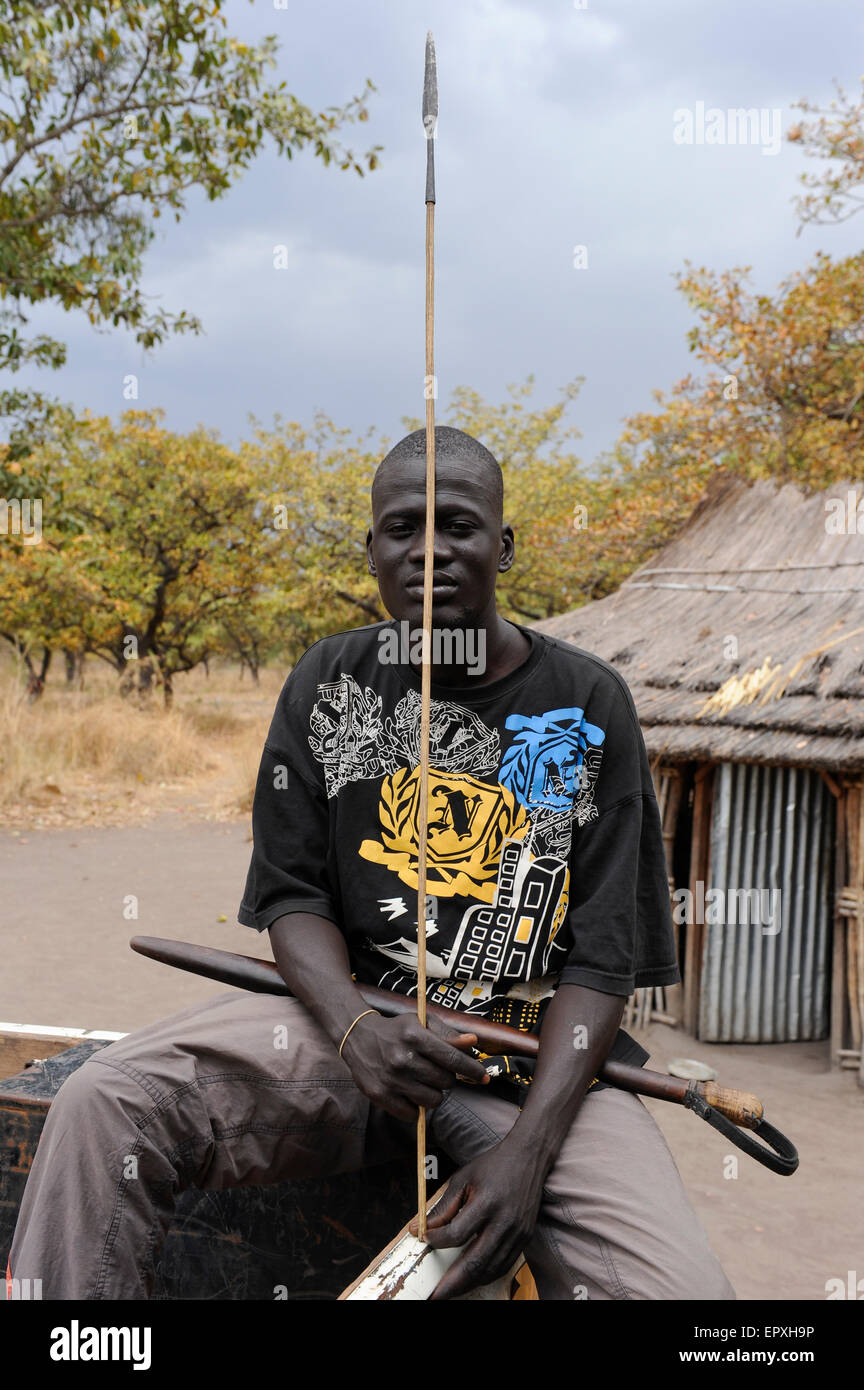 SOUTH-SUDAN Rumbek , village, Colocok, Dinka warrior with spear / SUED SUDAN, Rumbek, Dinka Dorf Colocok, Dinka Krieger mit Speer Stock Photohttps://www.alamy.com/image-license-details/?v=1https://www.alamy.com/stock-photo-south-sudan-rumbek-village-colocok-dinka-warrior-with-spear-sued-sudan-82948258.html
SOUTH-SUDAN Rumbek , village, Colocok, Dinka warrior with spear / SUED SUDAN, Rumbek, Dinka Dorf Colocok, Dinka Krieger mit Speer Stock Photohttps://www.alamy.com/image-license-details/?v=1https://www.alamy.com/stock-photo-south-sudan-rumbek-village-colocok-dinka-warrior-with-spear-sued-sudan-82948258.htmlRMEPXH9P–SOUTH-SUDAN Rumbek , village, Colocok, Dinka warrior with spear / SUED SUDAN, Rumbek, Dinka Dorf Colocok, Dinka Krieger mit Speer
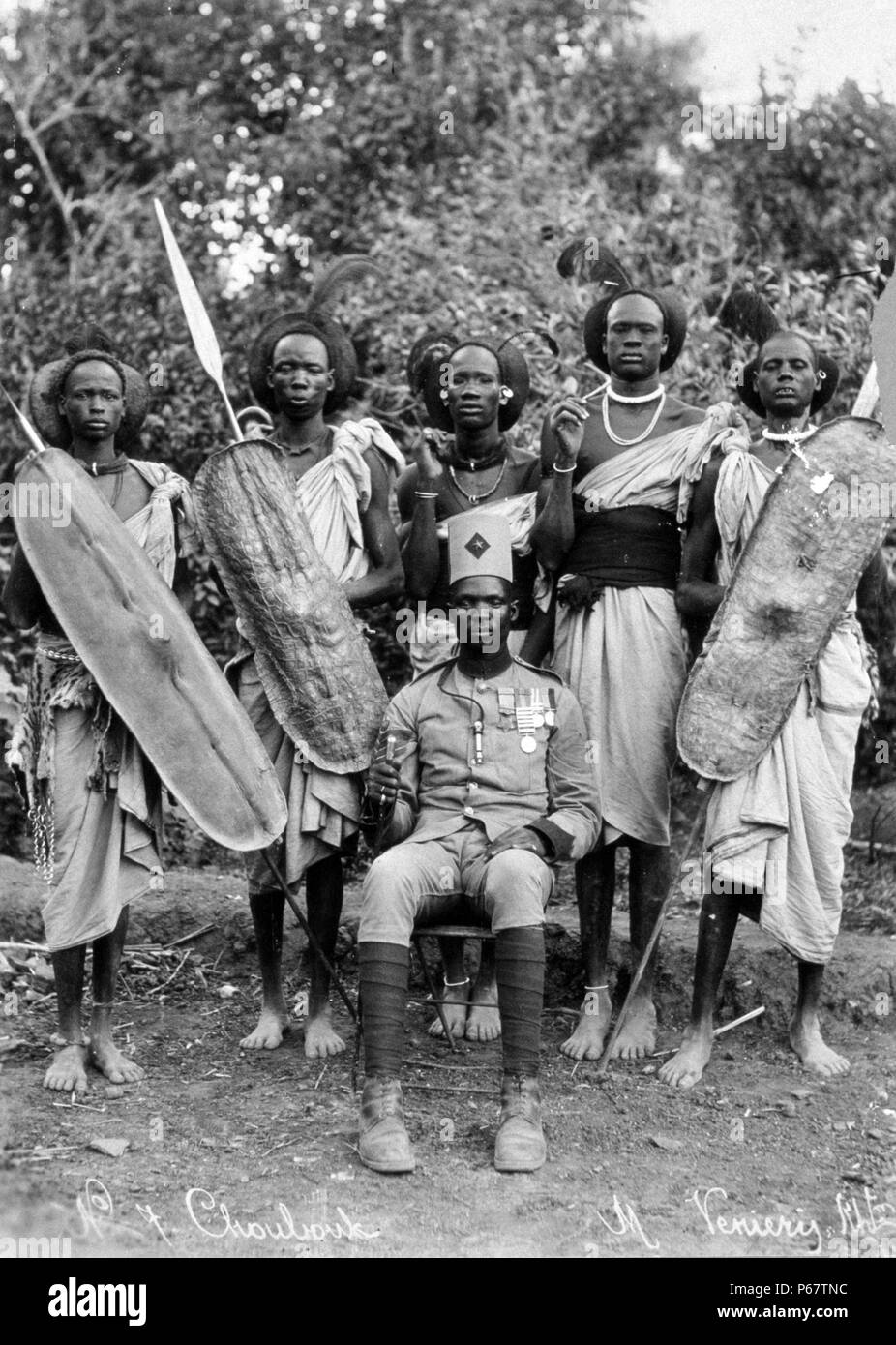 Photograph of Sudanese warriors standing next to a seated officer in Khartoum. Taken by M. Veniery. Dated 1920 Stock Photohttps://www.alamy.com/image-license-details/?v=1https://www.alamy.com/photograph-of-sudanese-warriors-standing-next-to-a-seated-officer-in-khartoum-taken-by-m-veniery-dated-1920-image210385432.html
Photograph of Sudanese warriors standing next to a seated officer in Khartoum. Taken by M. Veniery. Dated 1920 Stock Photohttps://www.alamy.com/image-license-details/?v=1https://www.alamy.com/photograph-of-sudanese-warriors-standing-next-to-a-seated-officer-in-khartoum-taken-by-m-veniery-dated-1920-image210385432.htmlRMP67TNC–Photograph of Sudanese warriors standing next to a seated officer in Khartoum. Taken by M. Veniery. Dated 1920
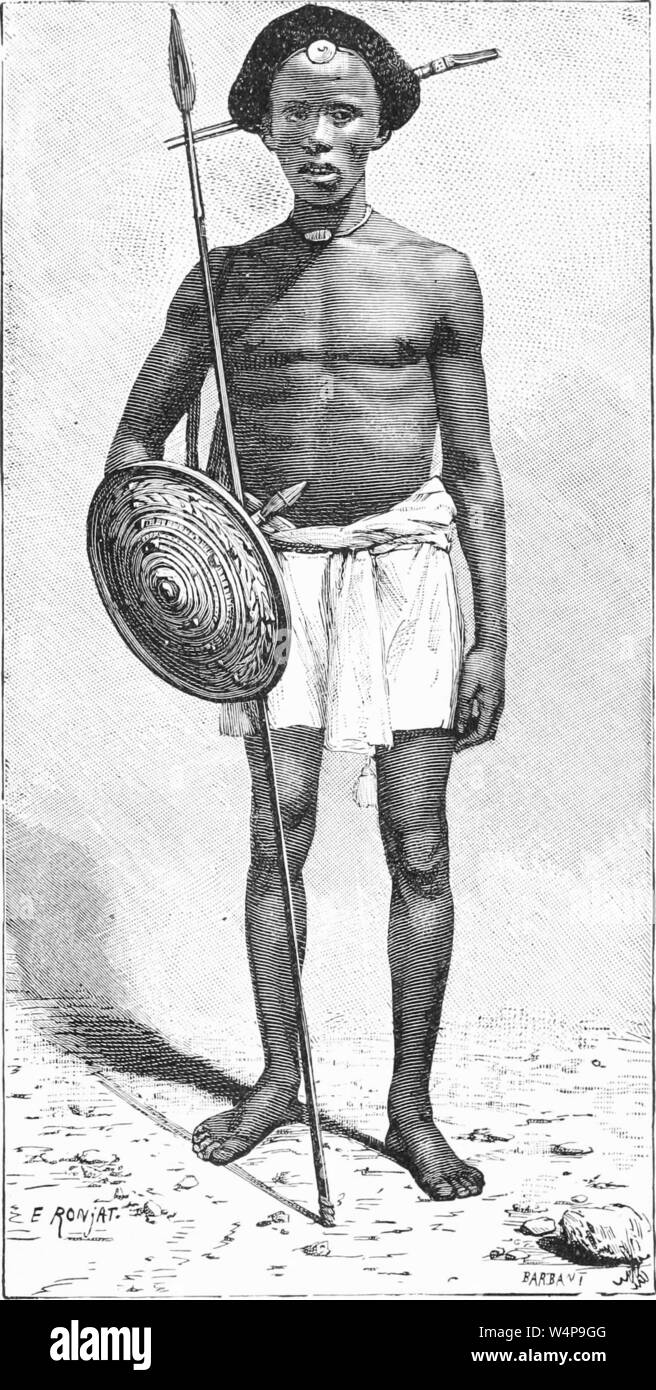 Engraved drawing of the Sudanese warrior, from the book 'Ridpath's Universal history' by John Clark Ridpath, 1897. Courtesy Internet Archive. () Stock Photohttps://www.alamy.com/image-license-details/?v=1https://www.alamy.com/engraved-drawing-of-the-sudanese-warrior-from-the-book-ridpaths-universal-history-by-john-clark-ridpath-1897-courtesy-internet-archive-image261104608.html
Engraved drawing of the Sudanese warrior, from the book 'Ridpath's Universal history' by John Clark Ridpath, 1897. Courtesy Internet Archive. () Stock Photohttps://www.alamy.com/image-license-details/?v=1https://www.alamy.com/engraved-drawing-of-the-sudanese-warrior-from-the-book-ridpaths-universal-history-by-john-clark-ridpath-1897-courtesy-internet-archive-image261104608.htmlRMW4P9GG–Engraved drawing of the Sudanese warrior, from the book 'Ridpath's Universal history' by John Clark Ridpath, 1897. Courtesy Internet Archive. ()
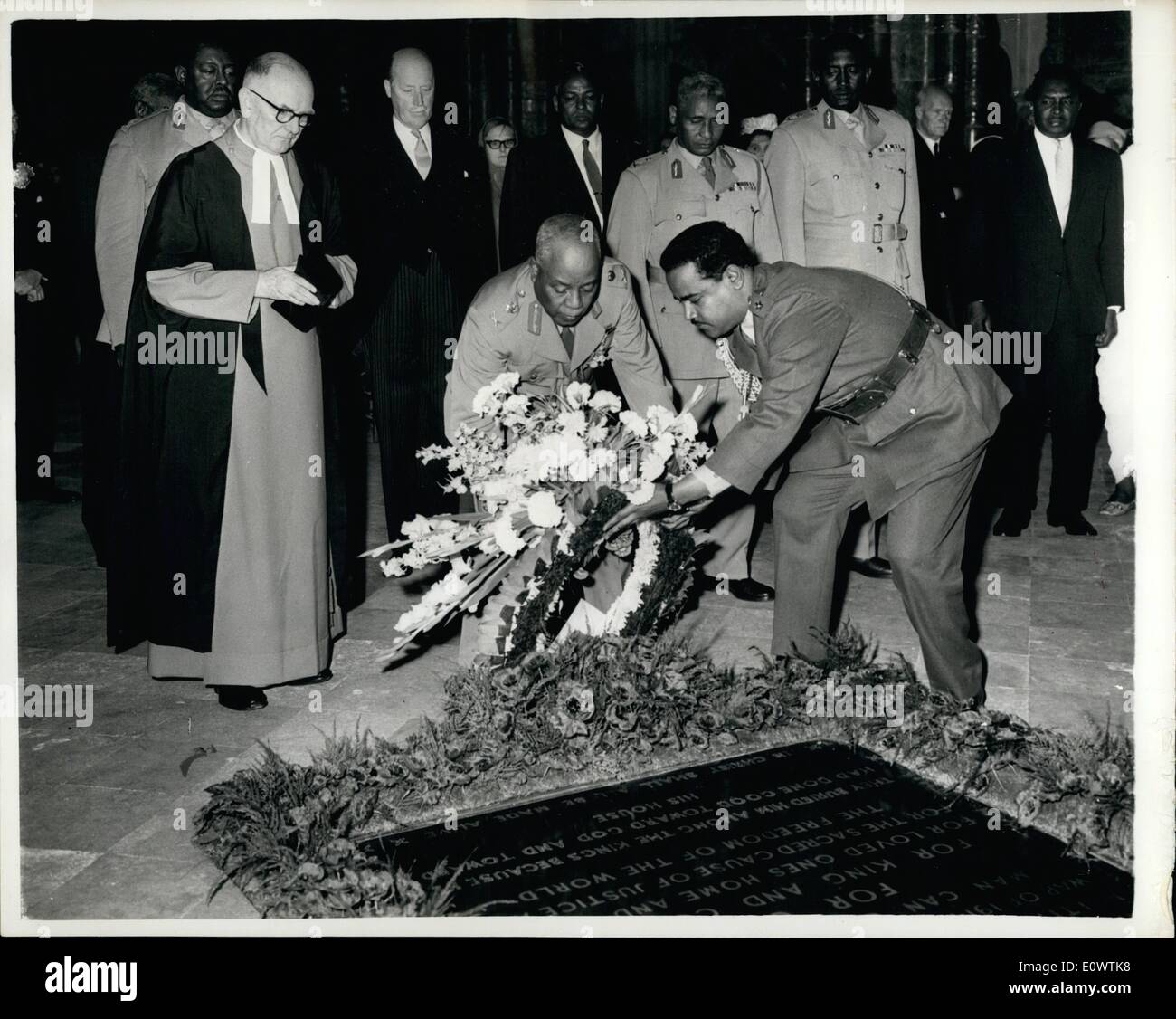 Apr. 04, 1964 - Abb Oud lays wreath on grave of unknown warrior: Westminister Abbey sub-Dean Rev. Canon Max Warren looks on as Sudan President Ibrahim Abb Oud lays a wreath on the tomb of the unknown warrior at the Abbey here today. President Abb Oud arrived in London earlier today at the start of a nine-day state visit to this country Stock Photohttps://www.alamy.com/image-license-details/?v=1https://www.alamy.com/apr-04-1964-abb-oud-lays-wreath-on-grave-of-unknown-warrior-westminister-image69409628.html
Apr. 04, 1964 - Abb Oud lays wreath on grave of unknown warrior: Westminister Abbey sub-Dean Rev. Canon Max Warren looks on as Sudan President Ibrahim Abb Oud lays a wreath on the tomb of the unknown warrior at the Abbey here today. President Abb Oud arrived in London earlier today at the start of a nine-day state visit to this country Stock Photohttps://www.alamy.com/image-license-details/?v=1https://www.alamy.com/apr-04-1964-abb-oud-lays-wreath-on-grave-of-unknown-warrior-westminister-image69409628.htmlRME0WTK8–Apr. 04, 1964 - Abb Oud lays wreath on grave of unknown warrior: Westminister Abbey sub-Dean Rev. Canon Max Warren looks on as Sudan President Ibrahim Abb Oud lays a wreath on the tomb of the unknown warrior at the Abbey here today. President Abb Oud arrived in London earlier today at the start of a nine-day state visit to this country
 War Dance of Shulluk Warriors, Sudan Stock Photohttps://www.alamy.com/image-license-details/?v=1https://www.alamy.com/war-dance-of-shulluk-warriors-sudan-image504870239.html
War Dance of Shulluk Warriors, Sudan Stock Photohttps://www.alamy.com/image-license-details/?v=1https://www.alamy.com/war-dance-of-shulluk-warriors-sudan-image504870239.htmlRM2M9AR3Y–War Dance of Shulluk Warriors, Sudan
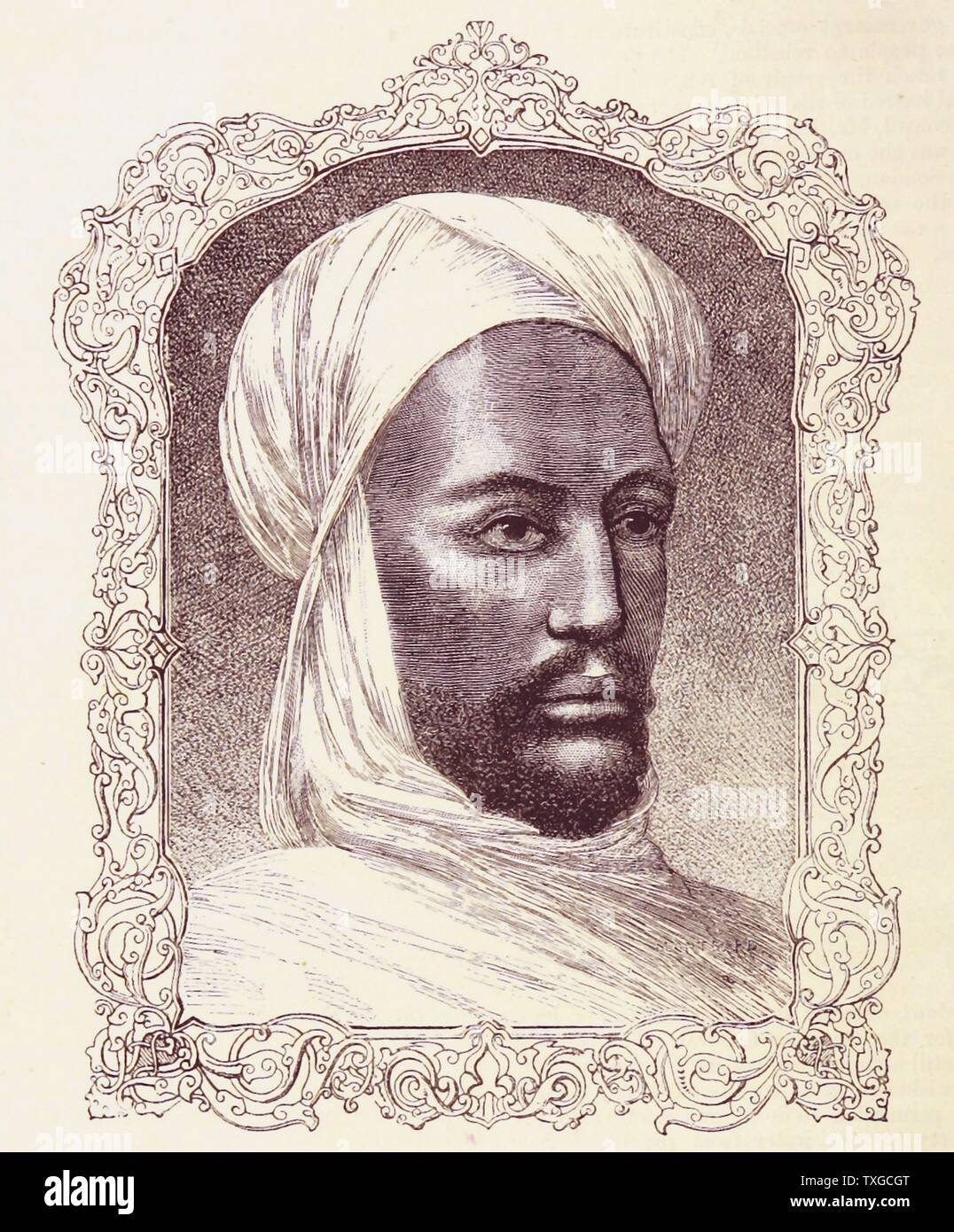 Muhammad Ahmad bin Abd Allah (1844 – June 22, 1885) religious leader of the Samaniyya order in Sudan who, on June 29, 1881, proclaimed himself the Mahdi (or Mahdi), the messianic redeemer of the Islamic faith. Stock Photohttps://www.alamy.com/image-license-details/?v=1https://www.alamy.com/muhammad-ahmad-bin-abd-allah-1844-june-22-1885-religious-leader-of-the-samaniyya-order-in-sudan-who-on-june-29-1881-proclaimed-himself-the-mahdi-or-mahdi-the-messianic-redeemer-of-the-islamic-faith-image257287320.html
Muhammad Ahmad bin Abd Allah (1844 – June 22, 1885) religious leader of the Samaniyya order in Sudan who, on June 29, 1881, proclaimed himself the Mahdi (or Mahdi), the messianic redeemer of the Islamic faith. Stock Photohttps://www.alamy.com/image-license-details/?v=1https://www.alamy.com/muhammad-ahmad-bin-abd-allah-1844-june-22-1885-religious-leader-of-the-samaniyya-order-in-sudan-who-on-june-29-1881-proclaimed-himself-the-mahdi-or-mahdi-the-messianic-redeemer-of-the-islamic-faith-image257287320.htmlRMTXGCGT–Muhammad Ahmad bin Abd Allah (1844 – June 22, 1885) religious leader of the Samaniyya order in Sudan who, on June 29, 1881, proclaimed himself the Mahdi (or Mahdi), the messianic redeemer of the Islamic faith.
 Dinka warriors - Bor District, South Sudan (Upper Nile). Stock Photohttps://www.alamy.com/image-license-details/?v=1https://www.alamy.com/dinka-warriors-bor-district-south-sudan-upper-nile-image485666137.html
Dinka warriors - Bor District, South Sudan (Upper Nile). Stock Photohttps://www.alamy.com/image-license-details/?v=1https://www.alamy.com/dinka-warriors-bor-district-south-sudan-upper-nile-image485666137.htmlRM2K64035–Dinka warriors - Bor District, South Sudan (Upper Nile).
 1945 War Illustrated Askari warrior of the Sudan defence force Stock Photohttps://www.alamy.com/image-license-details/?v=1https://www.alamy.com/stock-photo-1945-war-illustrated-askari-warrior-of-the-sudan-defence-force-126442905.html
1945 War Illustrated Askari warrior of the Sudan defence force Stock Photohttps://www.alamy.com/image-license-details/?v=1https://www.alamy.com/stock-photo-1945-war-illustrated-askari-warrior-of-the-sudan-defence-force-126442905.htmlRMH9KY61–1945 War Illustrated Askari warrior of the Sudan defence force
 Shulluk warriors pose by Alan Cobham's aeroplane in Sudan Stock Photohttps://www.alamy.com/image-license-details/?v=1https://www.alamy.com/shulluk-warriors-pose-by-alan-cobhams-aeroplane-in-sudan-image504870062.html
Shulluk warriors pose by Alan Cobham's aeroplane in Sudan Stock Photohttps://www.alamy.com/image-license-details/?v=1https://www.alamy.com/shulluk-warriors-pose-by-alan-cobhams-aeroplane-in-sudan-image504870062.htmlRM2M9APWJ–Shulluk warriors pose by Alan Cobham's aeroplane in Sudan
 In a small town of Malual kon in south Sudan, the SPLA (Sudanese People Liberation Army) takes part in a Peace Rally to demonstrate their acceptance of the Peace Agreement by laying down their arms. Stock Photohttps://www.alamy.com/image-license-details/?v=1https://www.alamy.com/in-a-small-town-of-malual-kon-in-south-sudan-the-spla-sudanese-people-liberation-army-takes-part-in-a-peace-rally-to-demonstrate-their-acceptance-of-the-peace-agreement-by-laying-down-their-arms-image245761511.html
In a small town of Malual kon in south Sudan, the SPLA (Sudanese People Liberation Army) takes part in a Peace Rally to demonstrate their acceptance of the Peace Agreement by laying down their arms. Stock Photohttps://www.alamy.com/image-license-details/?v=1https://www.alamy.com/in-a-small-town-of-malual-kon-in-south-sudan-the-spla-sudanese-people-liberation-army-takes-part-in-a-peace-rally-to-demonstrate-their-acceptance-of-the-peace-agreement-by-laying-down-their-arms-image245761511.htmlRMT7RB8R–In a small town of Malual kon in south Sudan, the SPLA (Sudanese People Liberation Army) takes part in a Peace Rally to demonstrate their acceptance of the Peace Agreement by laying down their arms.
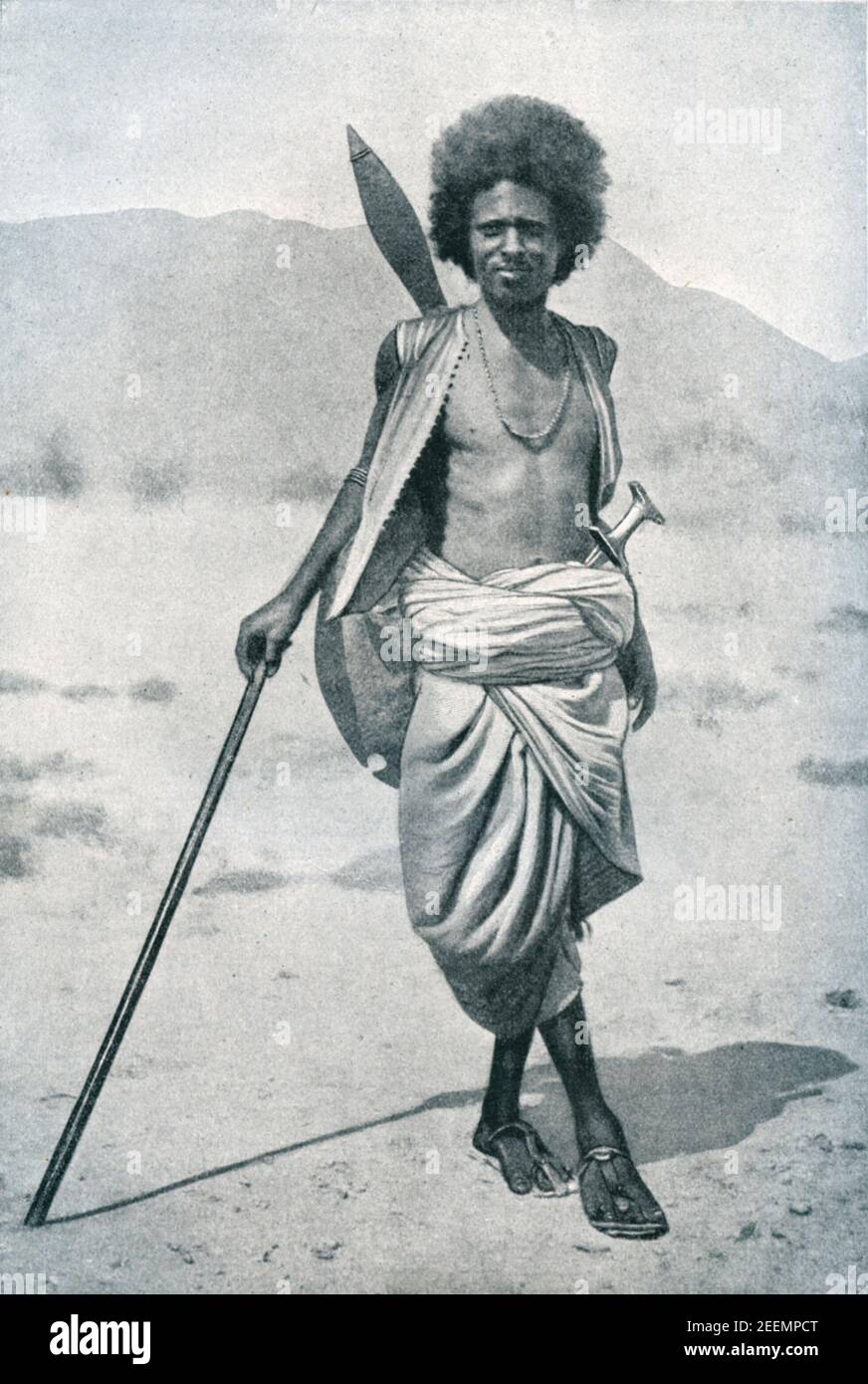 Early 20th century photo of member of the Hadendoa Beja nomadic tribe of eastern Sudan armed with spear, sword and shield. Their hair style (tiffa) gained them the nick name Fuzzy Wuzzy among British troops during the Mahdist War of the 1880-1890s Stock Photohttps://www.alamy.com/image-license-details/?v=1https://www.alamy.com/early-20th-century-photo-of-member-of-the-hadendoa-beja-nomadic-tribe-of-eastern-sudan-armed-with-spear-sword-and-shield-their-hair-style-tiffa-gained-them-the-nick-name-fuzzy-wuzzy-among-british-troops-during-the-mahdist-war-of-the-1880-1890s-image404900296.html
Early 20th century photo of member of the Hadendoa Beja nomadic tribe of eastern Sudan armed with spear, sword and shield. Their hair style (tiffa) gained them the nick name Fuzzy Wuzzy among British troops during the Mahdist War of the 1880-1890s Stock Photohttps://www.alamy.com/image-license-details/?v=1https://www.alamy.com/early-20th-century-photo-of-member-of-the-hadendoa-beja-nomadic-tribe-of-eastern-sudan-armed-with-spear-sword-and-shield-their-hair-style-tiffa-gained-them-the-nick-name-fuzzy-wuzzy-among-british-troops-during-the-mahdist-war-of-the-1880-1890s-image404900296.htmlRM2EEMPCT–Early 20th century photo of member of the Hadendoa Beja nomadic tribe of eastern Sudan armed with spear, sword and shield. Their hair style (tiffa) gained them the nick name Fuzzy Wuzzy among British troops during the Mahdist War of the 1880-1890s
 Poorly Madi warrior fed Liebig Extract - Stanley Stock Photohttps://www.alamy.com/image-license-details/?v=1https://www.alamy.com/poorly-madi-warrior-fed-liebig-extract-stanley-image501472741.html
Poorly Madi warrior fed Liebig Extract - Stanley Stock Photohttps://www.alamy.com/image-license-details/?v=1https://www.alamy.com/poorly-madi-warrior-fed-liebig-extract-stanley-image501472741.htmlRM2M3T1GN–Poorly Madi warrior fed Liebig Extract - Stanley
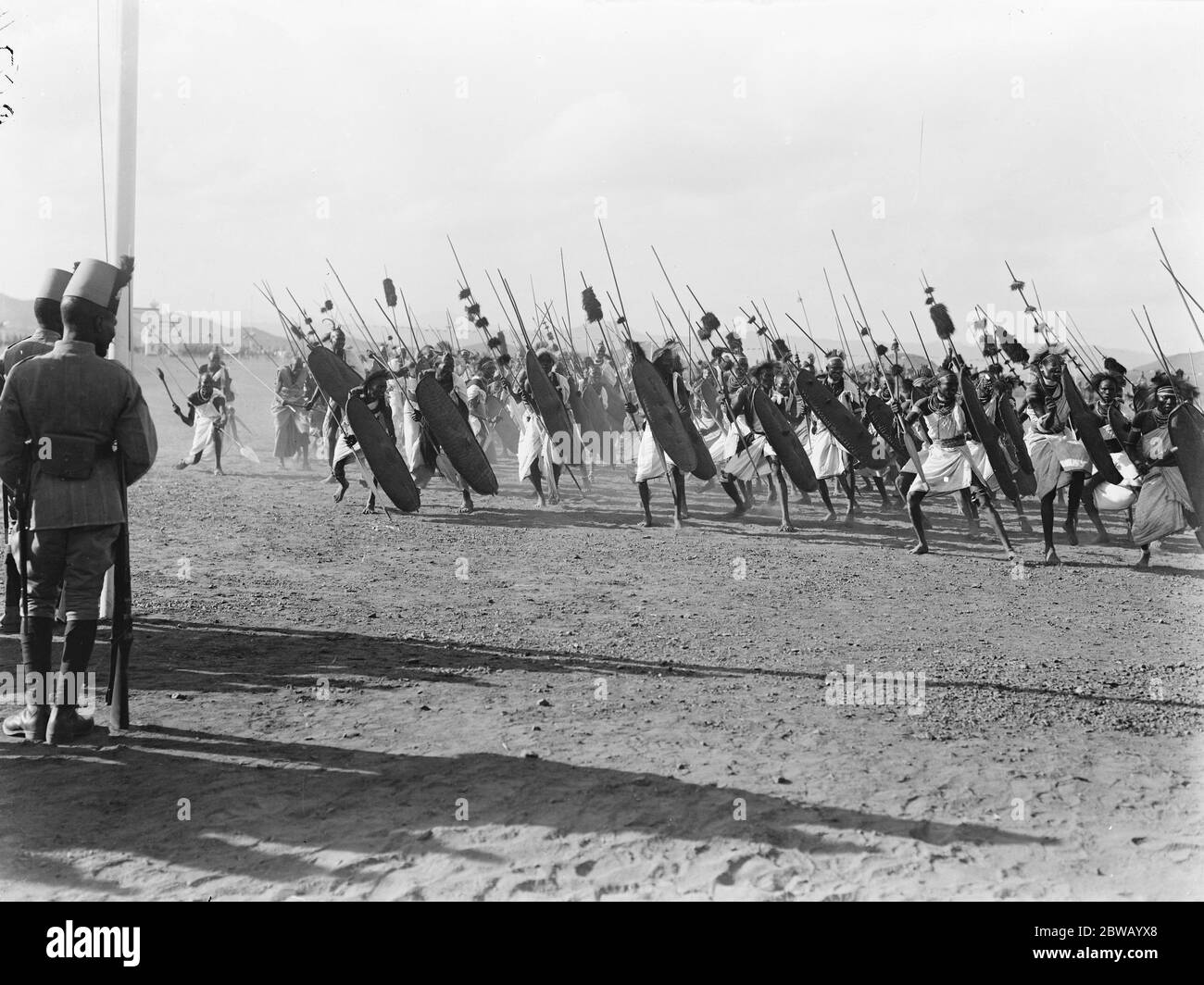 Types of Sudan Natives doing a war dance before the King 1912 Stock Photohttps://www.alamy.com/image-license-details/?v=1https://www.alamy.com/types-of-sudan-natives-doing-a-war-dance-before-the-king-1912-image359815184.html
Types of Sudan Natives doing a war dance before the King 1912 Stock Photohttps://www.alamy.com/image-license-details/?v=1https://www.alamy.com/types-of-sudan-natives-doing-a-war-dance-before-the-king-1912-image359815184.htmlRM2BWAYX8–Types of Sudan Natives doing a war dance before the King 1912
 Sudan - A group of Hadendoa Warriors. The Hadendoa is the name of a nomadic subdivision of the Beja people, known for their support of the Mahdiyyah rebellion during the 1880s to 1890s. The area historically inhabited by the Hadendoa is today parts of Sud Stock Photohttps://www.alamy.com/image-license-details/?v=1https://www.alamy.com/stock-photo-sudan-a-group-of-hadendoa-warriors-the-hadendoa-is-the-name-of-a-nomadic-131022246.html
Sudan - A group of Hadendoa Warriors. The Hadendoa is the name of a nomadic subdivision of the Beja people, known for their support of the Mahdiyyah rebellion during the 1880s to 1890s. The area historically inhabited by the Hadendoa is today parts of Sud Stock Photohttps://www.alamy.com/image-license-details/?v=1https://www.alamy.com/stock-photo-sudan-a-group-of-hadendoa-warriors-the-hadendoa-is-the-name-of-a-nomadic-131022246.htmlRMHH4G5X–Sudan - A group of Hadendoa Warriors. The Hadendoa is the name of a nomadic subdivision of the Beja people, known for their support of the Mahdiyyah rebellion during the 1880s to 1890s. The area historically inhabited by the Hadendoa is today parts of Sud
 A Dervish Emir Stock Photohttps://www.alamy.com/image-license-details/?v=1https://www.alamy.com/stock-image-a-dervish-emir-164039635.html
A Dervish Emir Stock Photohttps://www.alamy.com/image-license-details/?v=1https://www.alamy.com/stock-image-a-dervish-emir-164039635.htmlRMKETJ6B–A Dervish Emir
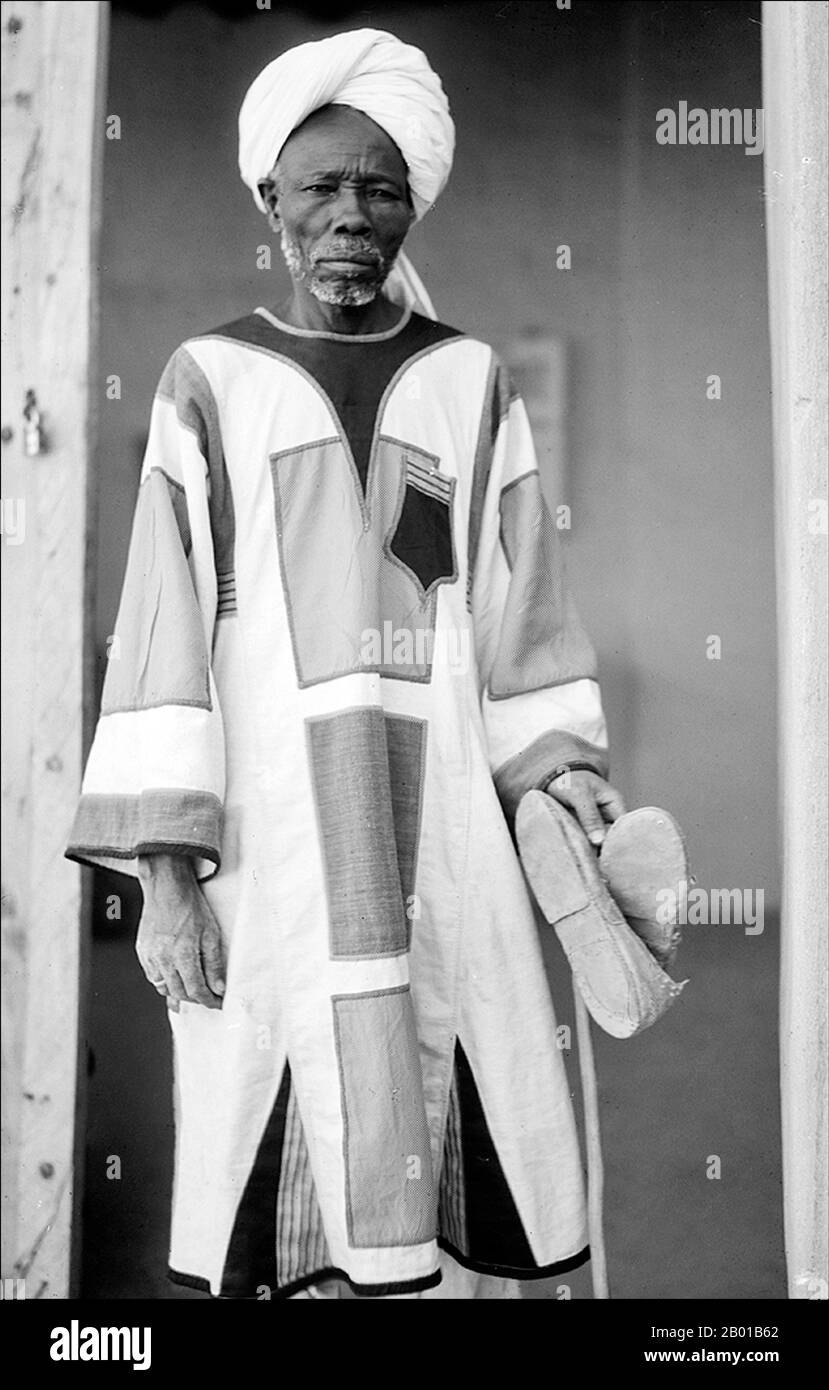 Sudan: A Mahdist guardian at the house of the former Mahdi, Omdurman, 1936. Muhammad Ahmad bin Abd Allah (12 August 1844 - 22 June 1885) was a religious leader of the Samaniyya order in Sudan who, on June 29, 1881, proclaimed himself as the Mahdi or messianic redeemer of the Islamic faith. His proclamation came during a period of widespread resentment among the Sudanese population of the oppressive policies of the Turco-Egyptian rulers, and capitalised on the messianic beliefs popular among the various Sudanese religious sects of the time. Stock Photohttps://www.alamy.com/image-license-details/?v=1https://www.alamy.com/sudan-a-mahdist-guardian-at-the-house-of-the-former-mahdi-omdurman-1936-muhammad-ahmad-bin-abd-allah-12-august-1844-22-june-1885-was-a-religious-leader-of-the-samaniyya-order-in-sudan-who-on-june-29-1881-proclaimed-himself-as-the-mahdi-or-messianic-redeemer-of-the-islamic-faith-his-proclamation-came-during-a-period-of-widespread-resentment-among-the-sudanese-population-of-the-oppressive-policies-of-the-turco-egyptian-rulers-and-capitalised-on-the-messianic-beliefs-popular-among-the-various-sudanese-religious-sects-of-the-time-image344238106.html
Sudan: A Mahdist guardian at the house of the former Mahdi, Omdurman, 1936. Muhammad Ahmad bin Abd Allah (12 August 1844 - 22 June 1885) was a religious leader of the Samaniyya order in Sudan who, on June 29, 1881, proclaimed himself as the Mahdi or messianic redeemer of the Islamic faith. His proclamation came during a period of widespread resentment among the Sudanese population of the oppressive policies of the Turco-Egyptian rulers, and capitalised on the messianic beliefs popular among the various Sudanese religious sects of the time. Stock Photohttps://www.alamy.com/image-license-details/?v=1https://www.alamy.com/sudan-a-mahdist-guardian-at-the-house-of-the-former-mahdi-omdurman-1936-muhammad-ahmad-bin-abd-allah-12-august-1844-22-june-1885-was-a-religious-leader-of-the-samaniyya-order-in-sudan-who-on-june-29-1881-proclaimed-himself-as-the-mahdi-or-messianic-redeemer-of-the-islamic-faith-his-proclamation-came-during-a-period-of-widespread-resentment-among-the-sudanese-population-of-the-oppressive-policies-of-the-turco-egyptian-rulers-and-capitalised-on-the-messianic-beliefs-popular-among-the-various-sudanese-religious-sects-of-the-time-image344238106.htmlRM2B01B62–Sudan: A Mahdist guardian at the house of the former Mahdi, Omdurman, 1936. Muhammad Ahmad bin Abd Allah (12 August 1844 - 22 June 1885) was a religious leader of the Samaniyya order in Sudan who, on June 29, 1881, proclaimed himself as the Mahdi or messianic redeemer of the Islamic faith. His proclamation came during a period of widespread resentment among the Sudanese population of the oppressive policies of the Turco-Egyptian rulers, and capitalised on the messianic beliefs popular among the various Sudanese religious sects of the time.
 Africa SOUTH SUDAN Bahr al Ghazal region , Lakes State, town Rumbek , drunken SPLA soldier in War Heroes Center Stock Photohttps://www.alamy.com/image-license-details/?v=1https://www.alamy.com/stock-photo-africa-south-sudan-bahr-al-ghazal-region-lakes-state-town-rumbek-drunken-43430820.html
Africa SOUTH SUDAN Bahr al Ghazal region , Lakes State, town Rumbek , drunken SPLA soldier in War Heroes Center Stock Photohttps://www.alamy.com/image-license-details/?v=1https://www.alamy.com/stock-photo-africa-south-sudan-bahr-al-ghazal-region-lakes-state-town-rumbek-drunken-43430820.htmlRMCEJCCM–Africa SOUTH SUDAN Bahr al Ghazal region , Lakes State, town Rumbek , drunken SPLA soldier in War Heroes Center
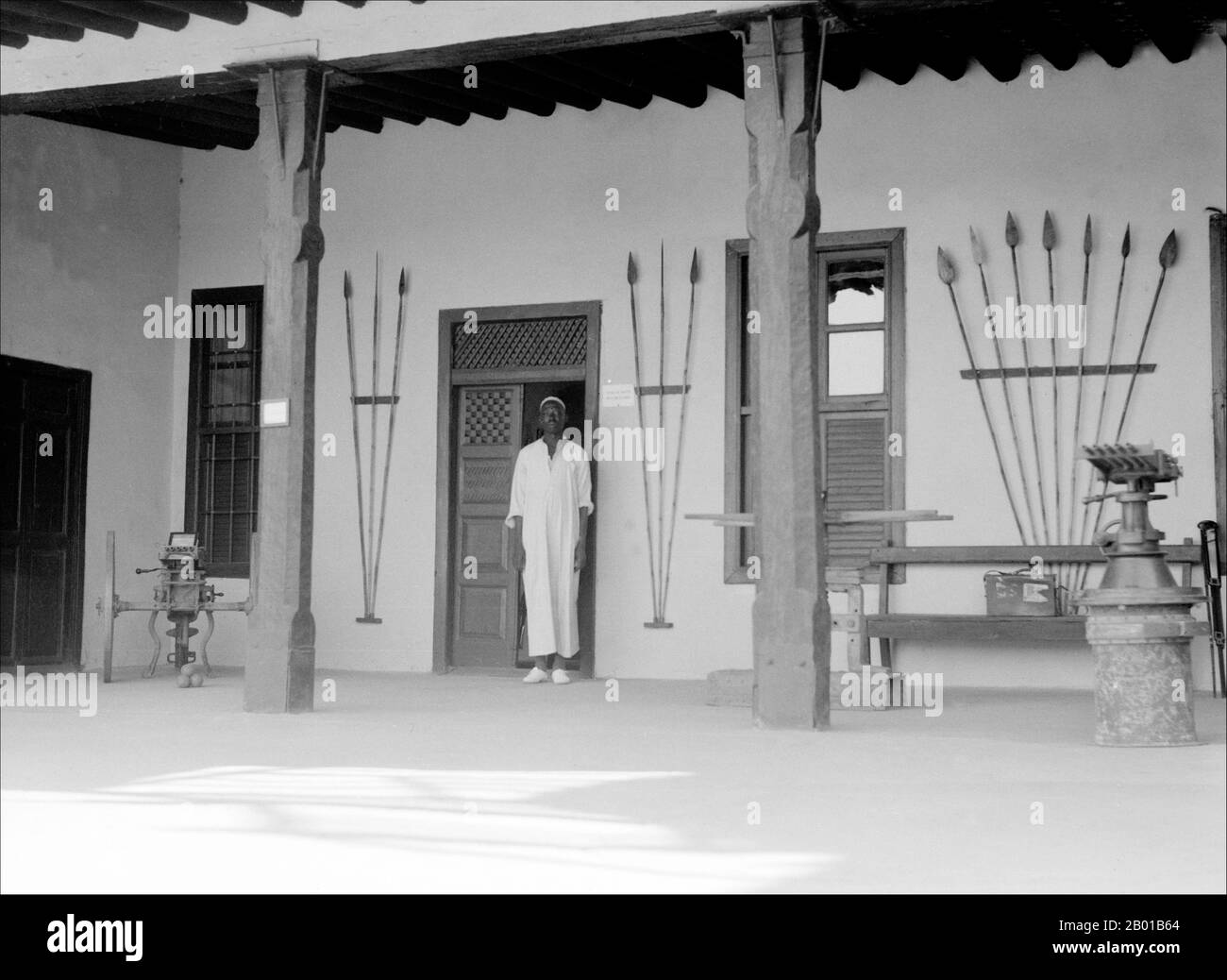 Sudan: A door keeper at the house of the former Mahdi, Omdurman, 1936. Muhammad Ahmad bin Abd Allah (12 August 1844 - 22 June 1885) was a religious leader of the Samaniyya order in Sudan who, on June 29, 1881, proclaimed himself as the Mahdi or messianic redeemer of the Islamic faith. His proclamation came during a period of widespread resentment among the Sudanese population of the oppressive policies of the Turco-Egyptian rulers, and capitalised on the messianic beliefs popular among the various Sudanese religious sects of the time. Stock Photohttps://www.alamy.com/image-license-details/?v=1https://www.alamy.com/sudan-a-door-keeper-at-the-house-of-the-former-mahdi-omdurman-1936-muhammad-ahmad-bin-abd-allah-12-august-1844-22-june-1885-was-a-religious-leader-of-the-samaniyya-order-in-sudan-who-on-june-29-1881-proclaimed-himself-as-the-mahdi-or-messianic-redeemer-of-the-islamic-faith-his-proclamation-came-during-a-period-of-widespread-resentment-among-the-sudanese-population-of-the-oppressive-policies-of-the-turco-egyptian-rulers-and-capitalised-on-the-messianic-beliefs-popular-among-the-various-sudanese-religious-sects-of-the-time-image344238108.html
Sudan: A door keeper at the house of the former Mahdi, Omdurman, 1936. Muhammad Ahmad bin Abd Allah (12 August 1844 - 22 June 1885) was a religious leader of the Samaniyya order in Sudan who, on June 29, 1881, proclaimed himself as the Mahdi or messianic redeemer of the Islamic faith. His proclamation came during a period of widespread resentment among the Sudanese population of the oppressive policies of the Turco-Egyptian rulers, and capitalised on the messianic beliefs popular among the various Sudanese religious sects of the time. Stock Photohttps://www.alamy.com/image-license-details/?v=1https://www.alamy.com/sudan-a-door-keeper-at-the-house-of-the-former-mahdi-omdurman-1936-muhammad-ahmad-bin-abd-allah-12-august-1844-22-june-1885-was-a-religious-leader-of-the-samaniyya-order-in-sudan-who-on-june-29-1881-proclaimed-himself-as-the-mahdi-or-messianic-redeemer-of-the-islamic-faith-his-proclamation-came-during-a-period-of-widespread-resentment-among-the-sudanese-population-of-the-oppressive-policies-of-the-turco-egyptian-rulers-and-capitalised-on-the-messianic-beliefs-popular-among-the-various-sudanese-religious-sects-of-the-time-image344238108.htmlRM2B01B64–Sudan: A door keeper at the house of the former Mahdi, Omdurman, 1936. Muhammad Ahmad bin Abd Allah (12 August 1844 - 22 June 1885) was a religious leader of the Samaniyya order in Sudan who, on June 29, 1881, proclaimed himself as the Mahdi or messianic redeemer of the Islamic faith. His proclamation came during a period of widespread resentment among the Sudanese population of the oppressive policies of the Turco-Egyptian rulers, and capitalised on the messianic beliefs popular among the various Sudanese religious sects of the time.
 A Shoa warrior. Stock Photohttps://www.alamy.com/image-license-details/?v=1https://www.alamy.com/a-shoa-warrior-image268798226.html
A Shoa warrior. Stock Photohttps://www.alamy.com/image-license-details/?v=1https://www.alamy.com/a-shoa-warrior-image268798226.htmlRMWH8PTJ–A Shoa warrior.
 Africa. Sudan. Nuba chief, c. 1880. Engraving. Later colouration.19th century. Stock Photohttps://www.alamy.com/image-license-details/?v=1https://www.alamy.com/africa-sudan-nuba-chief-c-1880-engraving-later-colouration19th-century-image61648674.html
Africa. Sudan. Nuba chief, c. 1880. Engraving. Later colouration.19th century. Stock Photohttps://www.alamy.com/image-license-details/?v=1https://www.alamy.com/africa-sudan-nuba-chief-c-1880-engraving-later-colouration19th-century-image61648674.htmlRMDG89EA–Africa. Sudan. Nuba chief, c. 1880. Engraving. Later colouration.19th century.
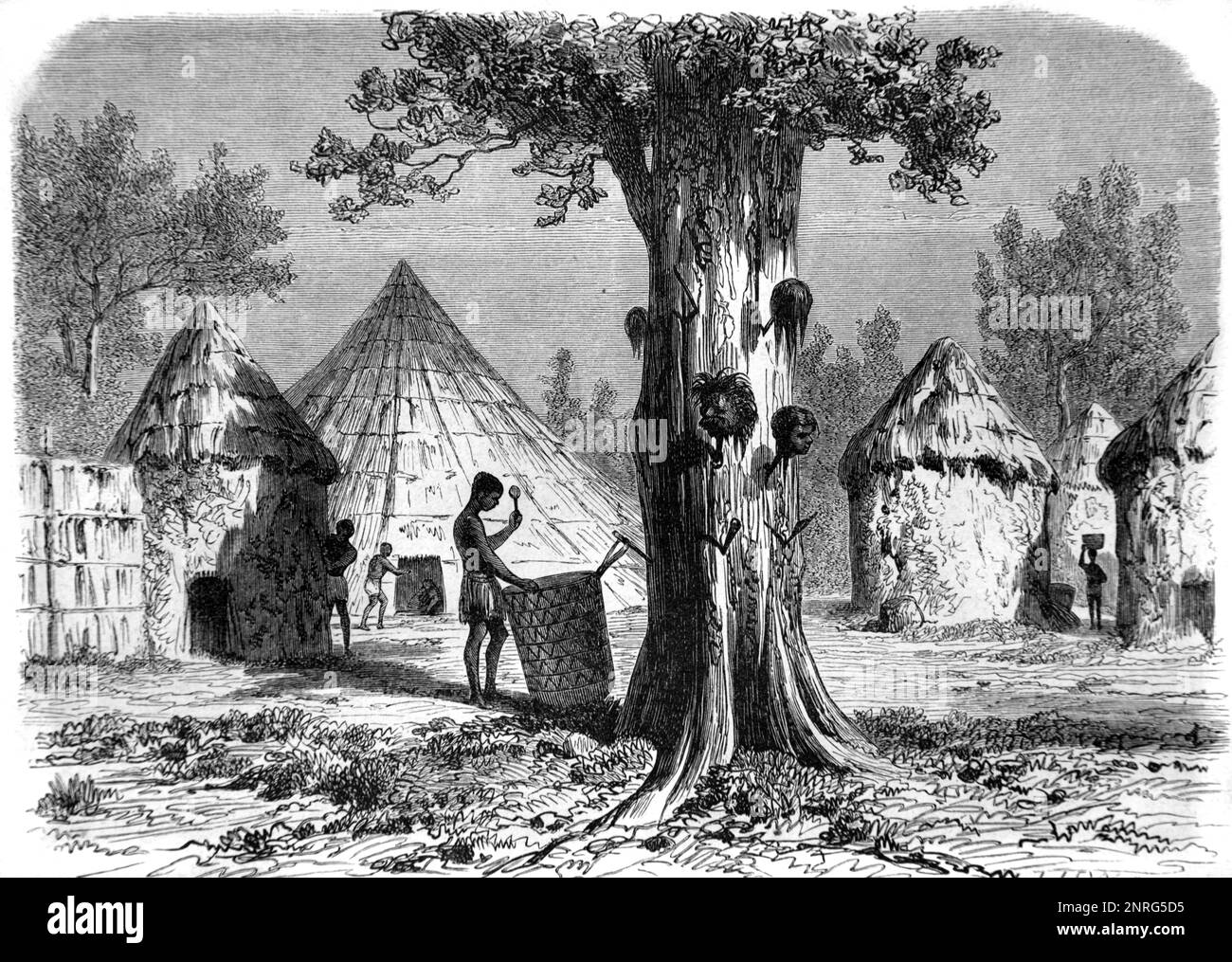 War Tree or Trophy Tree Hung with Severed Heads of Rival Tribe in Nuer Village or African Village of Round Mud Huts in the White Nile Region of South Sudan Africa. Vintage Engraving or Illustration 1862 Stock Photohttps://www.alamy.com/image-license-details/?v=1https://www.alamy.com/war-tree-or-trophy-tree-hung-with-severed-heads-of-rival-tribe-in-nuer-village-or-african-village-of-round-mud-huts-in-the-white-nile-region-of-south-sudan-africa-vintage-engraving-or-illustration-1862-image530803649.html
War Tree or Trophy Tree Hung with Severed Heads of Rival Tribe in Nuer Village or African Village of Round Mud Huts in the White Nile Region of South Sudan Africa. Vintage Engraving or Illustration 1862 Stock Photohttps://www.alamy.com/image-license-details/?v=1https://www.alamy.com/war-tree-or-trophy-tree-hung-with-severed-heads-of-rival-tribe-in-nuer-village-or-african-village-of-round-mud-huts-in-the-white-nile-region-of-south-sudan-africa-vintage-engraving-or-illustration-1862-image530803649.htmlRM2NRG5D5–War Tree or Trophy Tree Hung with Severed Heads of Rival Tribe in Nuer Village or African Village of Round Mud Huts in the White Nile Region of South Sudan Africa. Vintage Engraving or Illustration 1862
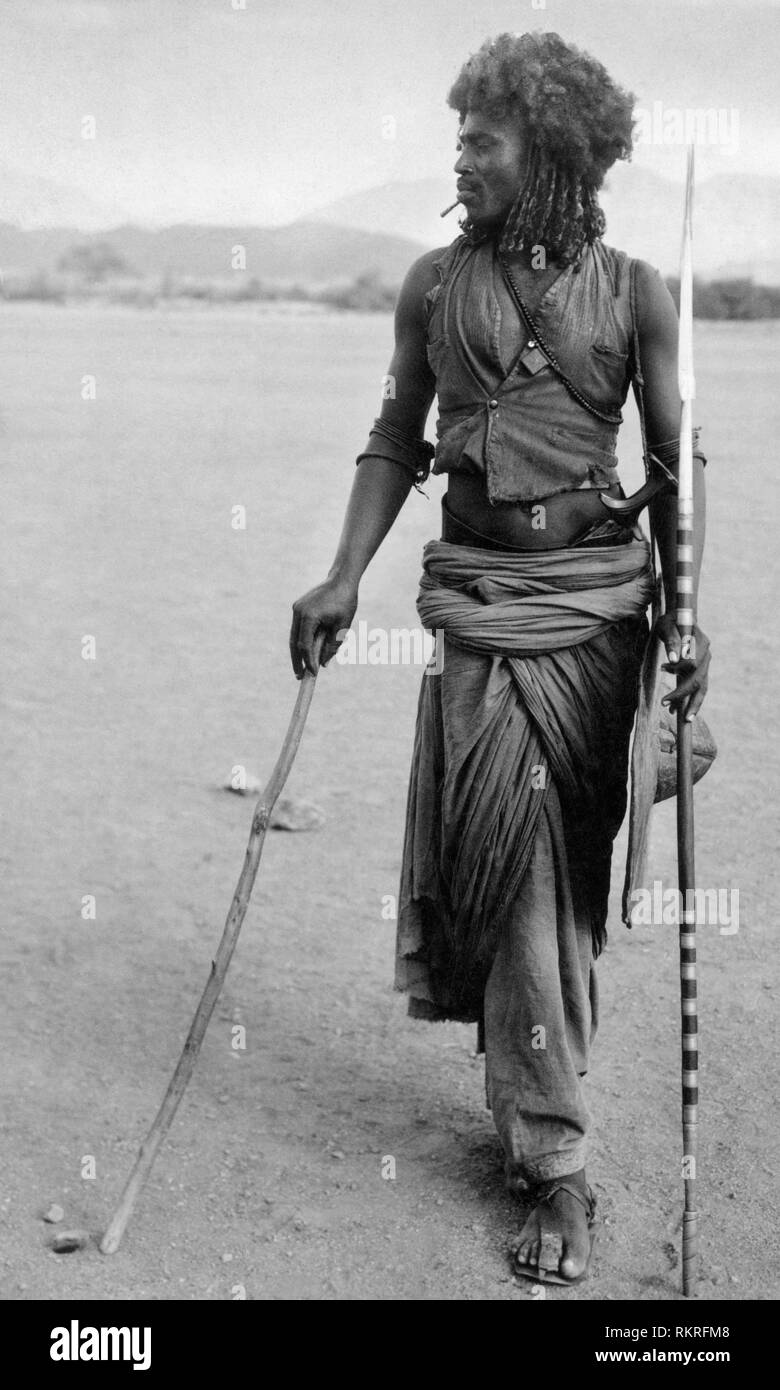 hadendoa warrior, sudan, africa 1920 1930 Stock Photohttps://www.alamy.com/image-license-details/?v=1https://www.alamy.com/hadendoa-warrior-sudan-africa-1920-1930-image235930472.html
hadendoa warrior, sudan, africa 1920 1930 Stock Photohttps://www.alamy.com/image-license-details/?v=1https://www.alamy.com/hadendoa-warrior-sudan-africa-1920-1930-image235930472.htmlRMRKRFM8–hadendoa warrior, sudan, africa 1920 1930
 The War in the Soudan (Sudan): The Late Sir Herbert Stewart Wounded, Carrying the General to the Nile the Day after the Battle of Gubat, January 20 Stock Photohttps://www.alamy.com/image-license-details/?v=1https://www.alamy.com/the-war-in-the-soudan-sudan-the-late-sir-herbert-stewart-wounded-carrying-the-general-to-the-nile-the-day-after-the-battle-of-gubat-january-20-image240561070.html
The War in the Soudan (Sudan): The Late Sir Herbert Stewart Wounded, Carrying the General to the Nile the Day after the Battle of Gubat, January 20 Stock Photohttps://www.alamy.com/image-license-details/?v=1https://www.alamy.com/the-war-in-the-soudan-sudan-the-late-sir-herbert-stewart-wounded-carrying-the-general-to-the-nile-the-day-after-the-battle-of-gubat-january-20-image240561070.htmlRMRYAE2P–The War in the Soudan (Sudan): The Late Sir Herbert Stewart Wounded, Carrying the General to the Nile the Day after the Battle of Gubat, January 20
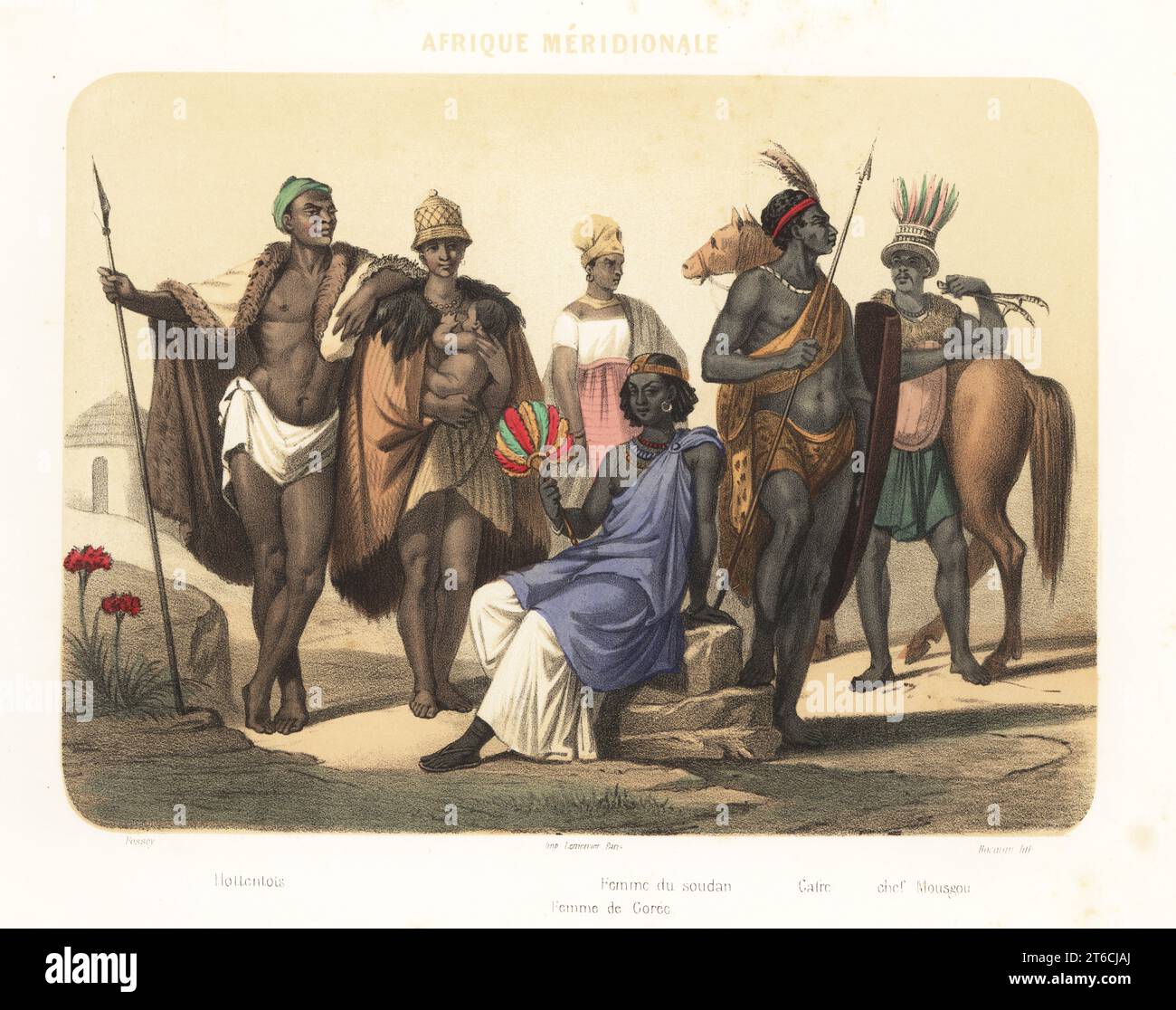 Costumes of Africa, 1858. Khoikhoi man and woman with sheepskin cloaks, woman from Sudan, Signare woman from the slave-trading Ile de Goree (Senegal), Zulu warrior with assegai spear and isihlangu cow-hide shield, and Musgum chief in feather headdress with ostrich bones (Cameroon). Hottentots, femme de Soudan, femme de Goree, Caffre, chef Mousgou. Handcoloured and sepia-tinted lithograph by Jean-Adolphe Bocquin after an illustration by Felix Fossey from Elisabeth Muller (pseudonym of Leonie Bedelet)s Le Monde en Estampes, The World in Prints, Amadee Bedelet, Paris, 1858. Stock Photohttps://www.alamy.com/image-license-details/?v=1https://www.alamy.com/costumes-of-africa-1858-khoikhoi-man-and-woman-with-sheepskin-cloaks-woman-from-sudan-signare-woman-from-the-slave-trading-ile-de-goree-senegal-zulu-warrior-with-assegai-spear-and-isihlangu-cow-hide-shield-and-musgum-chief-in-feather-headdress-with-ostrich-bones-cameroon-hottentots-femme-de-soudan-femme-de-goree-caffre-chef-mousgou-handcoloured-and-sepia-tinted-lithograph-by-jean-adolphe-bocquin-after-an-illustration-by-felix-fossey-from-elisabeth-muller-pseudonym-of-leonie-bedelets-le-monde-en-estampes-the-world-in-prints-amadee-bedelet-paris-1858-image571907914.html
Costumes of Africa, 1858. Khoikhoi man and woman with sheepskin cloaks, woman from Sudan, Signare woman from the slave-trading Ile de Goree (Senegal), Zulu warrior with assegai spear and isihlangu cow-hide shield, and Musgum chief in feather headdress with ostrich bones (Cameroon). Hottentots, femme de Soudan, femme de Goree, Caffre, chef Mousgou. Handcoloured and sepia-tinted lithograph by Jean-Adolphe Bocquin after an illustration by Felix Fossey from Elisabeth Muller (pseudonym of Leonie Bedelet)s Le Monde en Estampes, The World in Prints, Amadee Bedelet, Paris, 1858. Stock Photohttps://www.alamy.com/image-license-details/?v=1https://www.alamy.com/costumes-of-africa-1858-khoikhoi-man-and-woman-with-sheepskin-cloaks-woman-from-sudan-signare-woman-from-the-slave-trading-ile-de-goree-senegal-zulu-warrior-with-assegai-spear-and-isihlangu-cow-hide-shield-and-musgum-chief-in-feather-headdress-with-ostrich-bones-cameroon-hottentots-femme-de-soudan-femme-de-goree-caffre-chef-mousgou-handcoloured-and-sepia-tinted-lithograph-by-jean-adolphe-bocquin-after-an-illustration-by-felix-fossey-from-elisabeth-muller-pseudonym-of-leonie-bedelets-le-monde-en-estampes-the-world-in-prints-amadee-bedelet-paris-1858-image571907914.htmlRM2T6CJAJ–Costumes of Africa, 1858. Khoikhoi man and woman with sheepskin cloaks, woman from Sudan, Signare woman from the slave-trading Ile de Goree (Senegal), Zulu warrior with assegai spear and isihlangu cow-hide shield, and Musgum chief in feather headdress with ostrich bones (Cameroon). Hottentots, femme de Soudan, femme de Goree, Caffre, chef Mousgou. Handcoloured and sepia-tinted lithograph by Jean-Adolphe Bocquin after an illustration by Felix Fossey from Elisabeth Muller (pseudonym of Leonie Bedelet)s Le Monde en Estampes, The World in Prints, Amadee Bedelet, Paris, 1858.
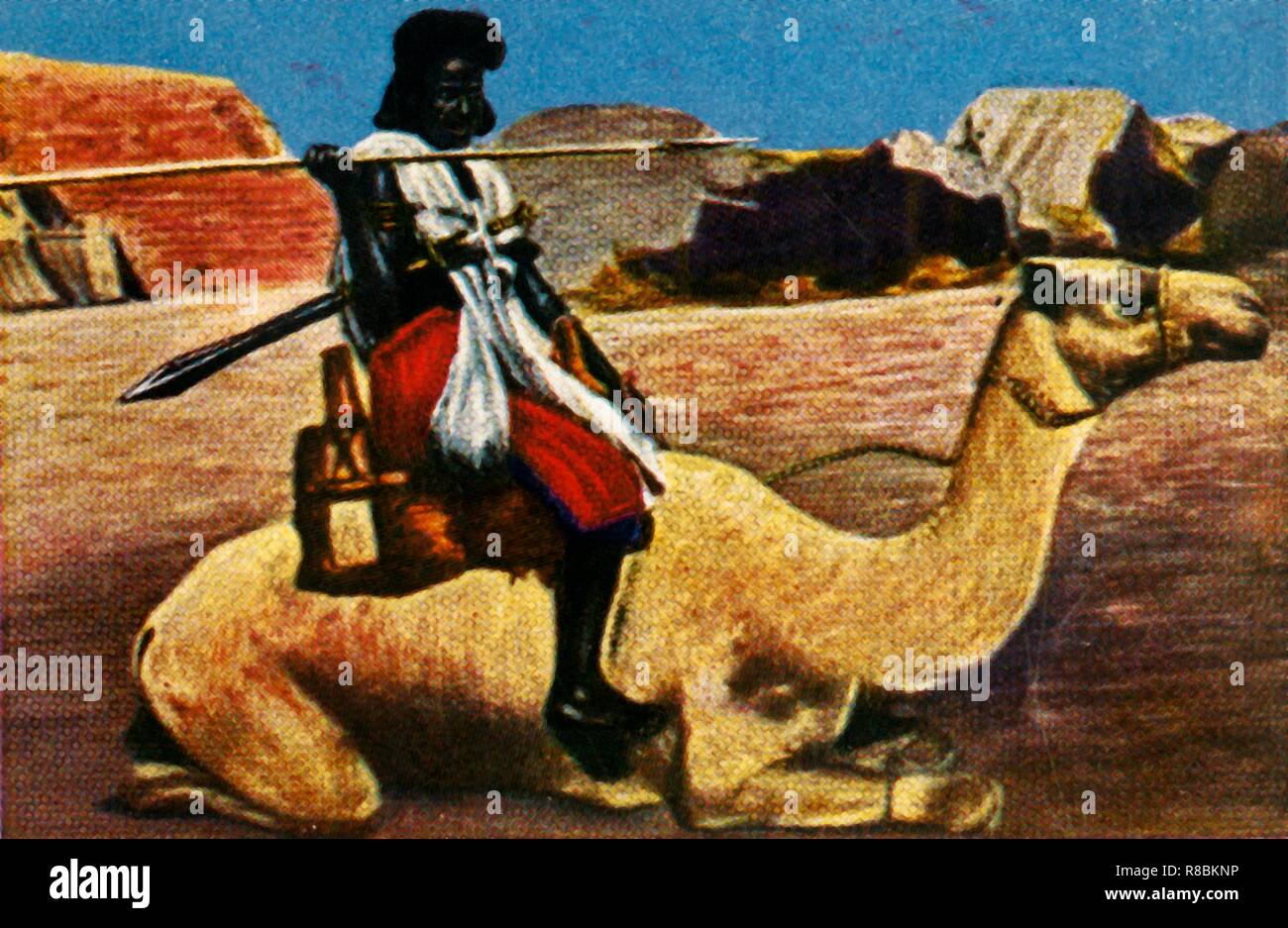 Sudanese warrior riding a camel, c1928. Creator: Unknown. Stock Photohttps://www.alamy.com/image-license-details/?v=1https://www.alamy.com/sudanese-warrior-riding-a-camel-c1928-creator-unknown-image228909010.html
Sudanese warrior riding a camel, c1928. Creator: Unknown. Stock Photohttps://www.alamy.com/image-license-details/?v=1https://www.alamy.com/sudanese-warrior-riding-a-camel-c1928-creator-unknown-image228909010.htmlRMR8BKNP–Sudanese warrior riding a camel, c1928. Creator: Unknown.
 Believers warrior of the Mahdi from Khartoum, warrior from Sudan, 1889 / Glaubensstreiter des Mahdi aus Khartum, Krieger aus dem Sudan, 1889, Historisch, digital improved reproduction of an original from the 19th century / digitale Reproduktion einer Originalvorlage aus dem 19. Jahrhundert, Stock Photohttps://www.alamy.com/image-license-details/?v=1https://www.alamy.com/believers-warrior-of-the-mahdi-from-khartoum-warrior-from-sudan-1889-glaubensstreiter-des-mahdi-aus-khartum-krieger-aus-dem-sudan-1889-historisch-digital-improved-reproduction-of-an-original-from-the-19th-century-digitale-reproduktion-einer-originalvorlage-aus-dem-19-jahrhundert-image349674417.html
Believers warrior of the Mahdi from Khartoum, warrior from Sudan, 1889 / Glaubensstreiter des Mahdi aus Khartum, Krieger aus dem Sudan, 1889, Historisch, digital improved reproduction of an original from the 19th century / digitale Reproduktion einer Originalvorlage aus dem 19. Jahrhundert, Stock Photohttps://www.alamy.com/image-license-details/?v=1https://www.alamy.com/believers-warrior-of-the-mahdi-from-khartoum-warrior-from-sudan-1889-glaubensstreiter-des-mahdi-aus-khartum-krieger-aus-dem-sudan-1889-historisch-digital-improved-reproduction-of-an-original-from-the-19th-century-digitale-reproduktion-einer-originalvorlage-aus-dem-19-jahrhundert-image349674417.htmlRF2B8W181–Believers warrior of the Mahdi from Khartoum, warrior from Sudan, 1889 / Glaubensstreiter des Mahdi aus Khartum, Krieger aus dem Sudan, 1889, Historisch, digital improved reproduction of an original from the 19th century / digitale Reproduktion einer Originalvorlage aus dem 19. Jahrhundert,
 Nuba stick wrestler warrior in matching wool twinset despite 100 degree humidity and high ambient temperature South of Kadugli N Stock Photohttps://www.alamy.com/image-license-details/?v=1https://www.alamy.com/nuba-stick-wrestler-warrior-in-matching-wool-twinset-despite-100-degree-image2411399.html
Nuba stick wrestler warrior in matching wool twinset despite 100 degree humidity and high ambient temperature South of Kadugli N Stock Photohttps://www.alamy.com/image-license-details/?v=1https://www.alamy.com/nuba-stick-wrestler-warrior-in-matching-wool-twinset-despite-100-degree-image2411399.htmlRMABTB88–Nuba stick wrestler warrior in matching wool twinset despite 100 degree humidity and high ambient temperature South of Kadugli N
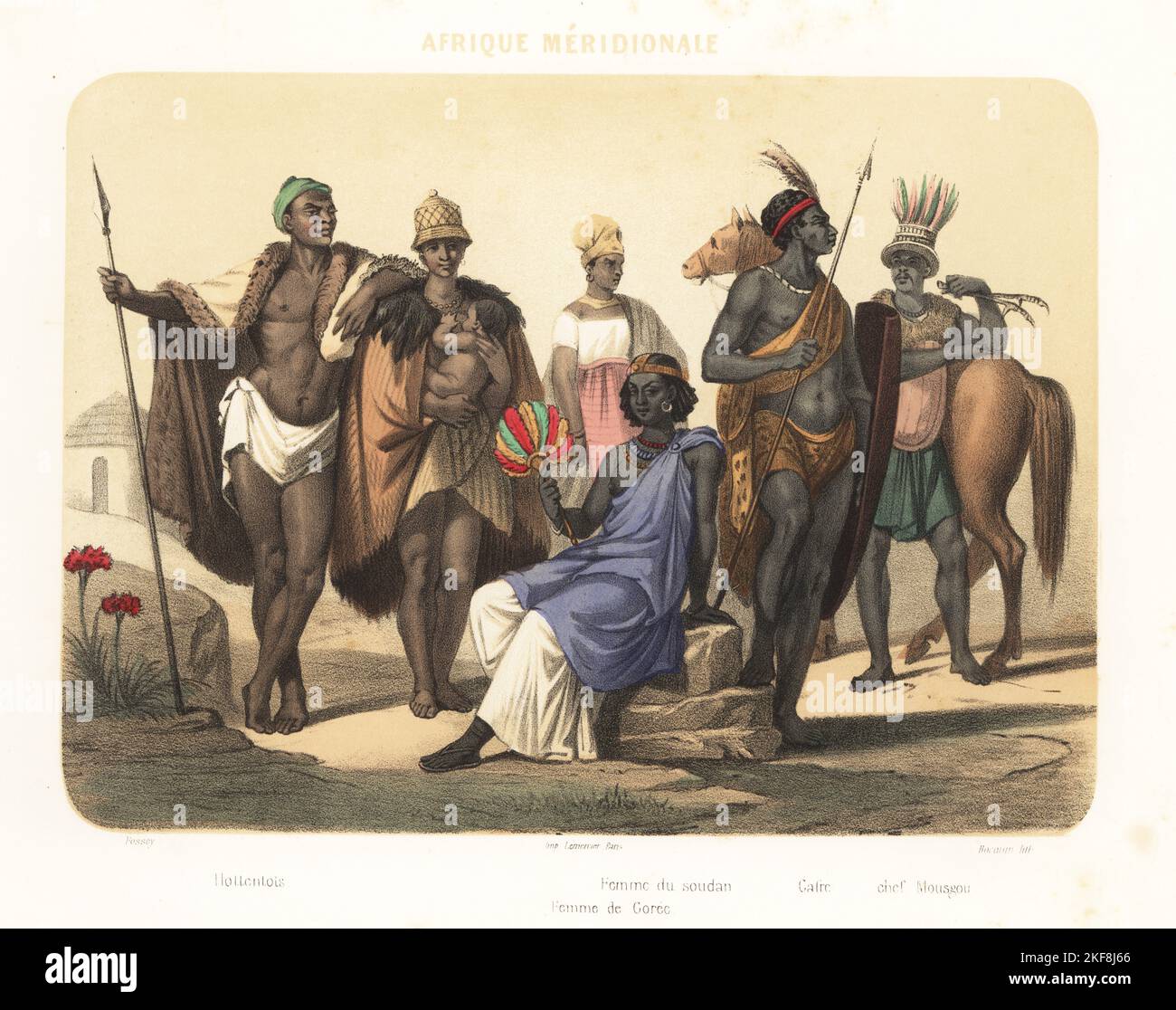 Costumes of Africa, 1858. Khoikhoi man and woman with sheepskin cloaks, woman from Sudan, Signare woman from the slave-trading Ile de Goree (Senegal), Zulu warrior with assegai spear and isihlangu cow-hide shield, and Musgum chief in feather headdress with ostrich bones (Cameroon). Hottentots, femme de Soudan, femme de Goree, Caffre, chef Mousgou. Handcoloured and sepia-tinted lithograph by Jean-Adolphe Bocquin after an illustration by Felix Fossey from Elisabeth Muller (pseudonym of Leonie Bedelet)’s Le Monde en Estampes, The World in Prints, Amadee Bedelet, Paris, 1858. Stock Photohttps://www.alamy.com/image-license-details/?v=1https://www.alamy.com/costumes-of-africa-1858-khoikhoi-man-and-woman-with-sheepskin-cloaks-woman-from-sudan-signare-woman-from-the-slave-trading-ile-de-goree-senegal-zulu-warrior-with-assegai-spear-and-isihlangu-cow-hide-shield-and-musgum-chief-in-feather-headdress-with-ostrich-bones-cameroon-hottentots-femme-de-soudan-femme-de-goree-caffre-chef-mousgou-handcoloured-and-sepia-tinted-lithograph-by-jean-adolphe-bocquin-after-an-illustration-by-felix-fossey-from-elisabeth-muller-pseudonym-of-leonie-bedelets-le-monde-en-estampes-the-world-in-prints-amadee-bedelet-paris-1858-image491300046.html
Costumes of Africa, 1858. Khoikhoi man and woman with sheepskin cloaks, woman from Sudan, Signare woman from the slave-trading Ile de Goree (Senegal), Zulu warrior with assegai spear and isihlangu cow-hide shield, and Musgum chief in feather headdress with ostrich bones (Cameroon). Hottentots, femme de Soudan, femme de Goree, Caffre, chef Mousgou. Handcoloured and sepia-tinted lithograph by Jean-Adolphe Bocquin after an illustration by Felix Fossey from Elisabeth Muller (pseudonym of Leonie Bedelet)’s Le Monde en Estampes, The World in Prints, Amadee Bedelet, Paris, 1858. Stock Photohttps://www.alamy.com/image-license-details/?v=1https://www.alamy.com/costumes-of-africa-1858-khoikhoi-man-and-woman-with-sheepskin-cloaks-woman-from-sudan-signare-woman-from-the-slave-trading-ile-de-goree-senegal-zulu-warrior-with-assegai-spear-and-isihlangu-cow-hide-shield-and-musgum-chief-in-feather-headdress-with-ostrich-bones-cameroon-hottentots-femme-de-soudan-femme-de-goree-caffre-chef-mousgou-handcoloured-and-sepia-tinted-lithograph-by-jean-adolphe-bocquin-after-an-illustration-by-felix-fossey-from-elisabeth-muller-pseudonym-of-leonie-bedelets-le-monde-en-estampes-the-world-in-prints-amadee-bedelet-paris-1858-image491300046.htmlRM2KF8J66–Costumes of Africa, 1858. Khoikhoi man and woman with sheepskin cloaks, woman from Sudan, Signare woman from the slave-trading Ile de Goree (Senegal), Zulu warrior with assegai spear and isihlangu cow-hide shield, and Musgum chief in feather headdress with ostrich bones (Cameroon). Hottentots, femme de Soudan, femme de Goree, Caffre, chef Mousgou. Handcoloured and sepia-tinted lithograph by Jean-Adolphe Bocquin after an illustration by Felix Fossey from Elisabeth Muller (pseudonym of Leonie Bedelet)’s Le Monde en Estampes, The World in Prints, Amadee Bedelet, Paris, 1858.
 In a small town of Malual kon in south Sudan, the SPLA (Sudanese People Liberation Army) takes part in a Peace Rally to demonstrate their acceptance of the Peace Agreement by laying down their arms. Stock Photohttps://www.alamy.com/image-license-details/?v=1https://www.alamy.com/in-a-small-town-of-malual-kon-in-south-sudan-the-spla-sudanese-people-liberation-army-takes-part-in-a-peace-rally-to-demonstrate-their-acceptance-of-the-peace-agreement-by-laying-down-their-arms-image245761162.html
In a small town of Malual kon in south Sudan, the SPLA (Sudanese People Liberation Army) takes part in a Peace Rally to demonstrate their acceptance of the Peace Agreement by laying down their arms. Stock Photohttps://www.alamy.com/image-license-details/?v=1https://www.alamy.com/in-a-small-town-of-malual-kon-in-south-sudan-the-spla-sudanese-people-liberation-army-takes-part-in-a-peace-rally-to-demonstrate-their-acceptance-of-the-peace-agreement-by-laying-down-their-arms-image245761162.htmlRMT7RATA–In a small town of Malual kon in south Sudan, the SPLA (Sudanese People Liberation Army) takes part in a Peace Rally to demonstrate their acceptance of the Peace Agreement by laying down their arms.
 Beja Tribe Men Dancing In Front Of The Khatmiyah Mosque At The Base Of The Taka Mountains, Kassala, Sudan Stock Photohttps://www.alamy.com/image-license-details/?v=1https://www.alamy.com/stock-photo-beja-tribe-men-dancing-in-front-of-the-khatmiyah-mosque-at-the-base-55549742.html
Beja Tribe Men Dancing In Front Of The Khatmiyah Mosque At The Base Of The Taka Mountains, Kassala, Sudan Stock Photohttps://www.alamy.com/image-license-details/?v=1https://www.alamy.com/stock-photo-beja-tribe-men-dancing-in-front-of-the-khatmiyah-mosque-at-the-base-55549742.htmlRMD6AE7A–Beja Tribe Men Dancing In Front Of The Khatmiyah Mosque At The Base Of The Taka Mountains, Kassala, Sudan
 Engraved drawing of the Sudanese warrior, from the book 'Ridpath's Universal history' by John Clark Ridpath, 1897. Courtesy Internet Archive. Note: Image has been digitally colorized using a modern process. Colors may not be period-accurate. () Stock Photohttps://www.alamy.com/image-license-details/?v=1https://www.alamy.com/engraved-drawing-of-the-sudanese-warrior-from-the-book-ridpaths-universal-history-by-john-clark-ridpath-1897-courtesy-internet-archive-note-image-has-been-digitally-colorized-using-a-modern-process-colors-may-not-be-period-accurate-image349197800.html
Engraved drawing of the Sudanese warrior, from the book 'Ridpath's Universal history' by John Clark Ridpath, 1897. Courtesy Internet Archive. Note: Image has been digitally colorized using a modern process. Colors may not be period-accurate. () Stock Photohttps://www.alamy.com/image-license-details/?v=1https://www.alamy.com/engraved-drawing-of-the-sudanese-warrior-from-the-book-ridpaths-universal-history-by-john-clark-ridpath-1897-courtesy-internet-archive-note-image-has-been-digitally-colorized-using-a-modern-process-colors-may-not-be-period-accurate-image349197800.htmlRM2B839A0–Engraved drawing of the Sudanese warrior, from the book 'Ridpath's Universal history' by John Clark Ridpath, 1897. Courtesy Internet Archive. Note: Image has been digitally colorized using a modern process. Colors may not be period-accurate. ()
 Mahdist War (1881-1899). It faced the followers of Sudanese religious leader Muhammad Ahmad bin Abdullah bin Fahal, the self-proclaimed Mahdi, against Egyptian Khedivate troops, who were later joined by British forces. The Sudanese insurgency. A raid by the Mahdi's troops near Suakin, where was housed the headquarters of the Anglo-Egyptian troops. Engraving by Bernardo Rico. La Ilustración Española y Americana (The Spanish and American Illustration), February 15, 1884. Stock Photohttps://www.alamy.com/image-license-details/?v=1https://www.alamy.com/mahdist-war-1881-1899-it-faced-the-followers-of-sudanese-religious-leader-muhammad-ahmad-bin-abdullah-bin-fahal-the-self-proclaimed-mahdi-against-egyptian-khedivate-troops-who-were-later-joined-by-british-forces-the-sudanese-insurgency-a-raid-by-the-mahdis-troops-near-suakin-where-was-housed-the-headquarters-of-the-anglo-egyptian-troops-engraving-by-bernardo-rico-la-ilustracin-espaola-y-americana-the-spanish-and-american-illustration-february-15-1884-image622477687.html
Mahdist War (1881-1899). It faced the followers of Sudanese religious leader Muhammad Ahmad bin Abdullah bin Fahal, the self-proclaimed Mahdi, against Egyptian Khedivate troops, who were later joined by British forces. The Sudanese insurgency. A raid by the Mahdi's troops near Suakin, where was housed the headquarters of the Anglo-Egyptian troops. Engraving by Bernardo Rico. La Ilustración Española y Americana (The Spanish and American Illustration), February 15, 1884. Stock Photohttps://www.alamy.com/image-license-details/?v=1https://www.alamy.com/mahdist-war-1881-1899-it-faced-the-followers-of-sudanese-religious-leader-muhammad-ahmad-bin-abdullah-bin-fahal-the-self-proclaimed-mahdi-against-egyptian-khedivate-troops-who-were-later-joined-by-british-forces-the-sudanese-insurgency-a-raid-by-the-mahdis-troops-near-suakin-where-was-housed-the-headquarters-of-the-anglo-egyptian-troops-engraving-by-bernardo-rico-la-ilustracin-espaola-y-americana-the-spanish-and-american-illustration-february-15-1884-image622477687.htmlRM2Y4M8HY–Mahdist War (1881-1899). It faced the followers of Sudanese religious leader Muhammad Ahmad bin Abdullah bin Fahal, the self-proclaimed Mahdi, against Egyptian Khedivate troops, who were later joined by British forces. The Sudanese insurgency. A raid by the Mahdi's troops near Suakin, where was housed the headquarters of the Anglo-Egyptian troops. Engraving by Bernardo Rico. La Ilustración Española y Americana (The Spanish and American Illustration), February 15, 1884.
 Kerma, Sudan, February 8., 2019: Group of a warrior statues in the museum of Kerma, Sudan Stock Photohttps://www.alamy.com/image-license-details/?v=1https://www.alamy.com/kerma-sudan-february-8-2019-group-of-a-warrior-statues-in-the-museum-of-kerma-sudan-image240596055.html
Kerma, Sudan, February 8., 2019: Group of a warrior statues in the museum of Kerma, Sudan Stock Photohttps://www.alamy.com/image-license-details/?v=1https://www.alamy.com/kerma-sudan-february-8-2019-group-of-a-warrior-statues-in-the-museum-of-kerma-sudan-image240596055.htmlRFRYC2M7–Kerma, Sudan, February 8., 2019: Group of a warrior statues in the museum of Kerma, Sudan
 MUNDARI TRIBE, SOUTH SUDAN - MARCH 11, 2020: Young men smiling and wrestling on field near cattle of Mundari Tribe on sunny day Stock Photohttps://www.alamy.com/image-license-details/?v=1https://www.alamy.com/mundari-tribe-south-sudan-march-11-2020-young-men-smiling-and-wrestling-on-field-near-cattle-of-mundari-tribe-on-sunny-day-image449767872.html
MUNDARI TRIBE, SOUTH SUDAN - MARCH 11, 2020: Young men smiling and wrestling on field near cattle of Mundari Tribe on sunny day Stock Photohttps://www.alamy.com/image-license-details/?v=1https://www.alamy.com/mundari-tribe-south-sudan-march-11-2020-young-men-smiling-and-wrestling-on-field-near-cattle-of-mundari-tribe-on-sunny-day-image449767872.htmlRM2H3MKE8–MUNDARI TRIBE, SOUTH SUDAN - MARCH 11, 2020: Young men smiling and wrestling on field near cattle of Mundari Tribe on sunny day
 Parade of the warriors of Almamy Ibrahima, Guinea. Africa. Two campaigns in French Sudan, 1886-1888 by Joseph Simon Gallieni (1849 - 1916) Le Tour du Monde 1890 Stock Photohttps://www.alamy.com/image-license-details/?v=1https://www.alamy.com/parade-of-the-warriors-of-almamy-ibrahima-guinea-africa-two-campaigns-in-french-sudan-1886-1888-by-joseph-simon-gallieni-1849-1916-le-tour-du-monde-1890-image596340404.html
Parade of the warriors of Almamy Ibrahima, Guinea. Africa. Two campaigns in French Sudan, 1886-1888 by Joseph Simon Gallieni (1849 - 1916) Le Tour du Monde 1890 Stock Photohttps://www.alamy.com/image-license-details/?v=1https://www.alamy.com/parade-of-the-warriors-of-almamy-ibrahima-guinea-africa-two-campaigns-in-french-sudan-1886-1888-by-joseph-simon-gallieni-1849-1916-le-tour-du-monde-1890-image596340404.htmlRM2WJ5J7G–Parade of the warriors of Almamy Ibrahima, Guinea. Africa. Two campaigns in French Sudan, 1886-1888 by Joseph Simon Gallieni (1849 - 1916) Le Tour du Monde 1890
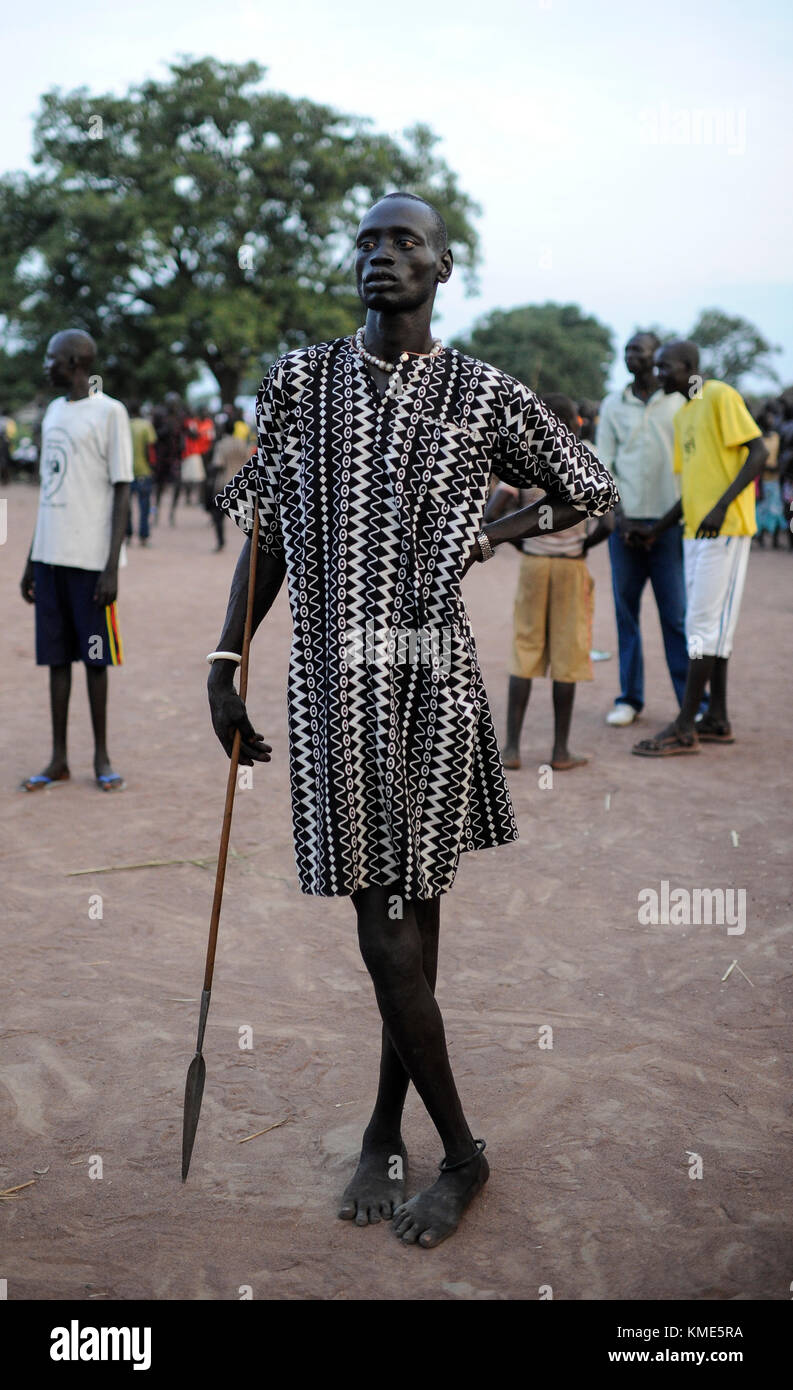 SOUTH SUDAN, Lakes State, village Mapourdit, Dinka celebrate harvest festival , posing man with dress and spear/ SUED-SUDAN Bahr el Ghazal region , Lakes State, Dorf Mapourdit , Dinka feiern ein Erntedankfest, posierender Mann mit Kleid und Speer Stock Photohttps://www.alamy.com/image-license-details/?v=1https://www.alamy.com/stock-image-south-sudan-lakes-state-village-mapourdit-dinka-celebrate-harvest-167498334.html
SOUTH SUDAN, Lakes State, village Mapourdit, Dinka celebrate harvest festival , posing man with dress and spear/ SUED-SUDAN Bahr el Ghazal region , Lakes State, Dorf Mapourdit , Dinka feiern ein Erntedankfest, posierender Mann mit Kleid und Speer Stock Photohttps://www.alamy.com/image-license-details/?v=1https://www.alamy.com/stock-image-south-sudan-lakes-state-village-mapourdit-dinka-celebrate-harvest-167498334.htmlRMKME5RA–SOUTH SUDAN, Lakes State, village Mapourdit, Dinka celebrate harvest festival , posing man with dress and spear/ SUED-SUDAN Bahr el Ghazal region , Lakes State, Dorf Mapourdit , Dinka feiern ein Erntedankfest, posierender Mann mit Kleid und Speer
 Men from the Toposa tribe posing in their traditional warrior costume, Eastern Equatoria, South Sudan Stock Photohttps://www.alamy.com/image-license-details/?v=1https://www.alamy.com/men-from-the-toposa-tribe-posing-in-their-traditional-warrior-costume-eastern-equatoria-south-sudan-image447854765.html
Men from the Toposa tribe posing in their traditional warrior costume, Eastern Equatoria, South Sudan Stock Photohttps://www.alamy.com/image-license-details/?v=1https://www.alamy.com/men-from-the-toposa-tribe-posing-in-their-traditional-warrior-costume-eastern-equatoria-south-sudan-image447854765.htmlRM2H0HF91–Men from the Toposa tribe posing in their traditional warrior costume, Eastern Equatoria, South Sudan
 A Shoa warrior. From a drawing by P. Blanchard Stock Photohttps://www.alamy.com/image-license-details/?v=1https://www.alamy.com/a-shoa-warrior-from-a-drawing-by-p-blanchard-image268798196.html
A Shoa warrior. From a drawing by P. Blanchard Stock Photohttps://www.alamy.com/image-license-details/?v=1https://www.alamy.com/a-shoa-warrior-from-a-drawing-by-p-blanchard-image268798196.htmlRMWH8PRG–A Shoa warrior. From a drawing by P. Blanchard
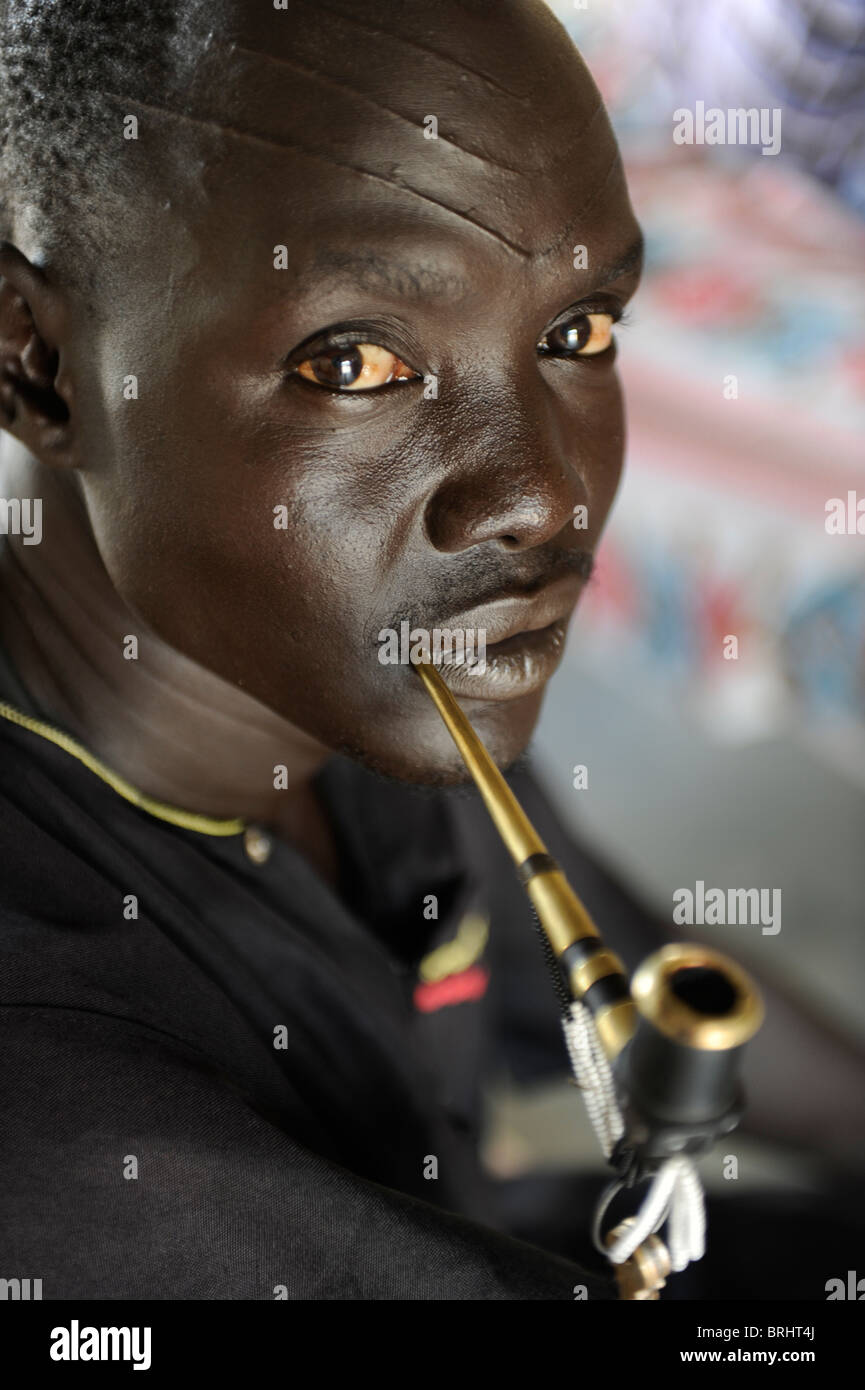 South Sudan, Rumbek , Cuibet, Dinka man with scar on his fore head and tobacco pipe Stock Photohttps://www.alamy.com/image-license-details/?v=1https://www.alamy.com/stock-photo-south-sudan-rumbek-cuibet-dinka-man-with-scar-on-his-fore-head-and-31739586.html
South Sudan, Rumbek , Cuibet, Dinka man with scar on his fore head and tobacco pipe Stock Photohttps://www.alamy.com/image-license-details/?v=1https://www.alamy.com/stock-photo-south-sudan-rumbek-cuibet-dinka-man-with-scar-on-his-fore-head-and-31739586.htmlRMBRHT4J–South Sudan, Rumbek , Cuibet, Dinka man with scar on his fore head and tobacco pipe
 Mar. 28, 1973 - President Numeiry at Westminster Abbey President Numeiry of Sudan, who is here on an official visit, this morning went to Westminster Abbey, where he placed a wreath at the Tomb of the Unknown Warrior. Keystone Photo Shows: President Numeiry, on left, salutes after placing a wreath at the Tomb of the Unknown Warrior today, watched by his wife. Stock Photohttps://www.alamy.com/image-license-details/?v=1https://www.alamy.com/mar-28-1973-president-numeiry-at-westminster-abbey-president-numeiry-image69471282.html
Mar. 28, 1973 - President Numeiry at Westminster Abbey President Numeiry of Sudan, who is here on an official visit, this morning went to Westminster Abbey, where he placed a wreath at the Tomb of the Unknown Warrior. Keystone Photo Shows: President Numeiry, on left, salutes after placing a wreath at the Tomb of the Unknown Warrior today, watched by his wife. Stock Photohttps://www.alamy.com/image-license-details/?v=1https://www.alamy.com/mar-28-1973-president-numeiry-at-westminster-abbey-president-numeiry-image69471282.htmlRME10K96–Mar. 28, 1973 - President Numeiry at Westminster Abbey President Numeiry of Sudan, who is here on an official visit, this morning went to Westminster Abbey, where he placed a wreath at the Tomb of the Unknown Warrior. Keystone Photo Shows: President Numeiry, on left, salutes after placing a wreath at the Tomb of the Unknown Warrior today, watched by his wife.
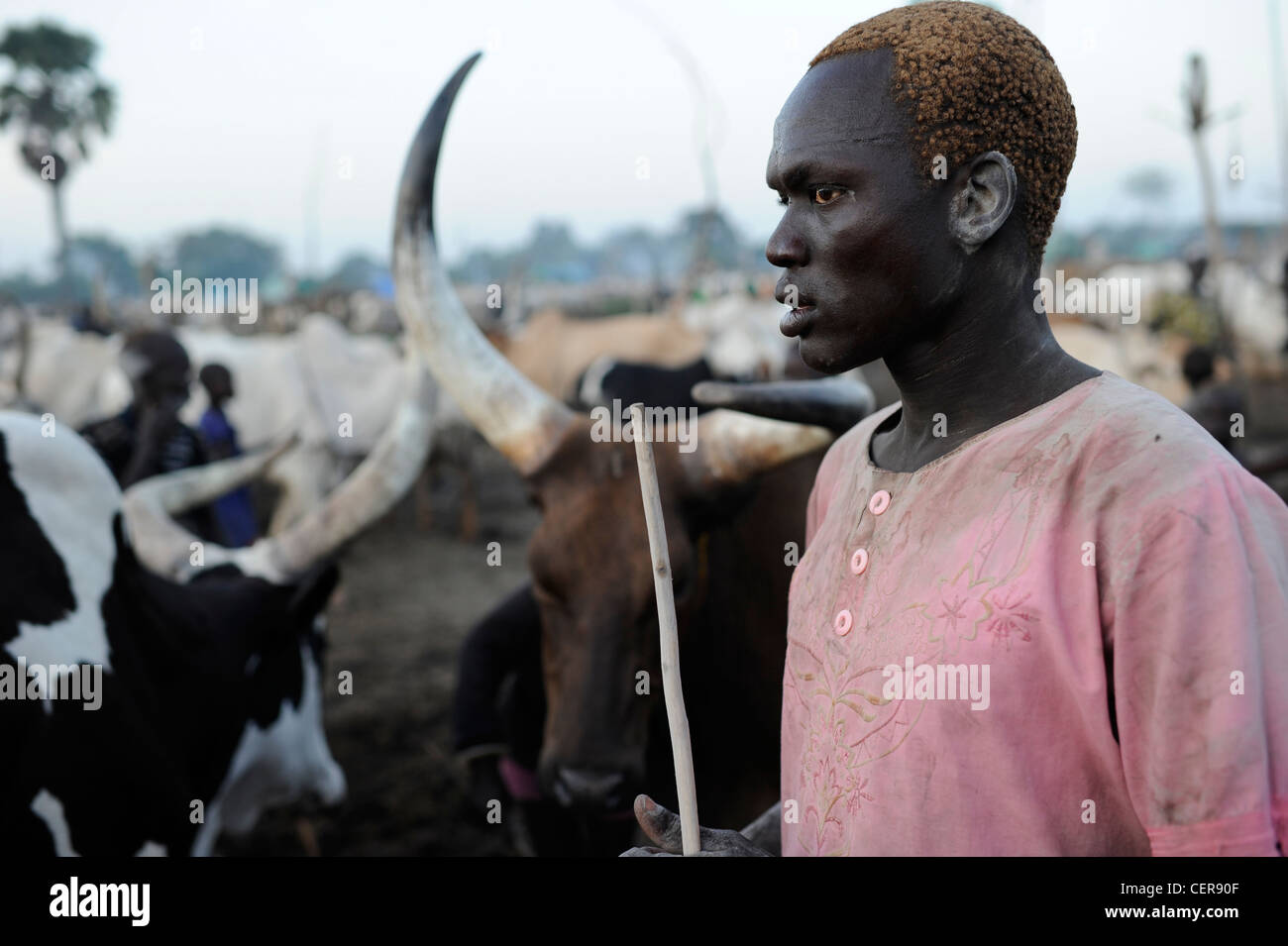 SOUTHERN SUDAN, Bahr al Ghazal region , Lakes State, Dinka tribe with Zebu cows in cattle camp near Rumbek Stock Photohttps://www.alamy.com/image-license-details/?v=1https://www.alamy.com/stock-photo-southern-sudan-bahr-al-ghazal-region-lakes-state-dinka-tribe-with-43537887.html
SOUTHERN SUDAN, Bahr al Ghazal region , Lakes State, Dinka tribe with Zebu cows in cattle camp near Rumbek Stock Photohttps://www.alamy.com/image-license-details/?v=1https://www.alamy.com/stock-photo-southern-sudan-bahr-al-ghazal-region-lakes-state-dinka-tribe-with-43537887.htmlRMCER90F–SOUTHERN SUDAN, Bahr al Ghazal region , Lakes State, Dinka tribe with Zebu cows in cattle camp near Rumbek
![Sudan, Printed caption reads: 'Arab Warriors, West Kordofan. Published by G N Morhig, The English Pharmacy, Khartoum. Copyright 245'. Portrait of two Sudanese warriors on horseback, positioned in front of a line of mounted cavalry on the horizon. The men are dressed in traditional warrior costume; their horses equipped with protective quilted coverings and nose guards, [c.1906]. 2003/222/1/2/45. Stock Photo Sudan, Printed caption reads: 'Arab Warriors, West Kordofan. Published by G N Morhig, The English Pharmacy, Khartoum. Copyright 245'. Portrait of two Sudanese warriors on horseback, positioned in front of a line of mounted cavalry on the horizon. The men are dressed in traditional warrior costume; their horses equipped with protective quilted coverings and nose guards, [c.1906]. 2003/222/1/2/45. Stock Photo](https://c8.alamy.com/comp/2AH837M/sudan-printed-caption-reads-arab-warriors-west-kordofan-published-by-g-n-morhig-the-english-pharmacy-khartoum-copyright-245-portrait-of-two-sudanese-warriors-on-horseback-positioned-in-front-of-a-line-of-mounted-cavalry-on-the-horizon-the-men-are-dressed-in-traditional-warrior-costume-their-horses-equipped-with-protective-quilted-coverings-and-nose-guards-c1906-20032221245-2AH837M.jpg) Sudan, Printed caption reads: 'Arab Warriors, West Kordofan. Published by G N Morhig, The English Pharmacy, Khartoum. Copyright 245'. Portrait of two Sudanese warriors on horseback, positioned in front of a line of mounted cavalry on the horizon. The men are dressed in traditional warrior costume; their horses equipped with protective quilted coverings and nose guards, [c.1906]. 2003/222/1/2/45. Stock Photohttps://www.alamy.com/image-license-details/?v=1https://www.alamy.com/sudan-printed-caption-reads-arab-warriors-west-kordofan-published-by-g-n-morhig-the-english-pharmacy-khartoum-copyright-245-portrait-of-two-sudanese-warriors-on-horseback-positioned-in-front-of-a-line-of-mounted-cavalry-on-the-horizon-the-men-are-dressed-in-traditional-warrior-costume-their-horses-equipped-with-protective-quilted-coverings-and-nose-guards-c1906-20032221245-image337624328.html
Sudan, Printed caption reads: 'Arab Warriors, West Kordofan. Published by G N Morhig, The English Pharmacy, Khartoum. Copyright 245'. Portrait of two Sudanese warriors on horseback, positioned in front of a line of mounted cavalry on the horizon. The men are dressed in traditional warrior costume; their horses equipped with protective quilted coverings and nose guards, [c.1906]. 2003/222/1/2/45. Stock Photohttps://www.alamy.com/image-license-details/?v=1https://www.alamy.com/sudan-printed-caption-reads-arab-warriors-west-kordofan-published-by-g-n-morhig-the-english-pharmacy-khartoum-copyright-245-portrait-of-two-sudanese-warriors-on-horseback-positioned-in-front-of-a-line-of-mounted-cavalry-on-the-horizon-the-men-are-dressed-in-traditional-warrior-costume-their-horses-equipped-with-protective-quilted-coverings-and-nose-guards-c1906-20032221245-image337624328.htmlRM2AH837M–Sudan, Printed caption reads: 'Arab Warriors, West Kordofan. Published by G N Morhig, The English Pharmacy, Khartoum. Copyright 245'. Portrait of two Sudanese warriors on horseback, positioned in front of a line of mounted cavalry on the horizon. The men are dressed in traditional warrior costume; their horses equipped with protective quilted coverings and nose guards, [c.1906]. 2003/222/1/2/45.
 Warrior dressed for harvest wrestling match, Sudan. Stock Photohttps://www.alamy.com/image-license-details/?v=1https://www.alamy.com/warrior-dressed-for-harvest-wrestling-match-sudan-image618873791.html
Warrior dressed for harvest wrestling match, Sudan. Stock Photohttps://www.alamy.com/image-license-details/?v=1https://www.alamy.com/warrior-dressed-for-harvest-wrestling-match-sudan-image618873791.htmlRF2XXT3RB–Warrior dressed for harvest wrestling match, Sudan.
 MUNDARI TRIBE, SOUTH SUDAN - MARCH 11, 2020: Young men smiling and wrestling on field near cattle of Mundari Tribe on sunny day in South Sudan, Africa Stock Photohttps://www.alamy.com/image-license-details/?v=1https://www.alamy.com/mundari-tribe-south-sudan-march-11-2020-young-men-smiling-and-wrestling-on-field-near-cattle-of-mundari-tribe-on-sunny-day-in-south-sudan-africa-image359304384.html
MUNDARI TRIBE, SOUTH SUDAN - MARCH 11, 2020: Young men smiling and wrestling on field near cattle of Mundari Tribe on sunny day in South Sudan, Africa Stock Photohttps://www.alamy.com/image-license-details/?v=1https://www.alamy.com/mundari-tribe-south-sudan-march-11-2020-young-men-smiling-and-wrestling-on-field-near-cattle-of-mundari-tribe-on-sunny-day-in-south-sudan-africa-image359304384.htmlRF2BTFMBC–MUNDARI TRIBE, SOUTH SUDAN - MARCH 11, 2020: Young men smiling and wrestling on field near cattle of Mundari Tribe on sunny day in South Sudan, Africa
 Sudan 19980622: Norwegian People's Aid rejoices after the Minister of Development and Human Rights Hilde Frafjord Johnson these days secures further operation of three hospitals in South Sudan. The need is great, and the victims of the Civil War are many. Photo: Nils-Inge Kruhaug / NTB / NTB / Child / Civil War / Warrior / Hospital / Hospital / Stock Photohttps://www.alamy.com/image-license-details/?v=1https://www.alamy.com/sudan-19980622-norwegian-peoples-aid-rejoices-after-the-minister-of-development-and-human-rights-hilde-frafjord-johnson-these-days-secures-further-operation-of-three-hospitals-in-south-sudan-the-need-is-great-and-the-victims-of-the-civil-war-are-many-photo-nils-inge-kruhaug-ntb-ntb-child-civil-war-warrior-hospital-hospital-image487249225.html
Sudan 19980622: Norwegian People's Aid rejoices after the Minister of Development and Human Rights Hilde Frafjord Johnson these days secures further operation of three hospitals in South Sudan. The need is great, and the victims of the Civil War are many. Photo: Nils-Inge Kruhaug / NTB / NTB / Child / Civil War / Warrior / Hospital / Hospital / Stock Photohttps://www.alamy.com/image-license-details/?v=1https://www.alamy.com/sudan-19980622-norwegian-peoples-aid-rejoices-after-the-minister-of-development-and-human-rights-hilde-frafjord-johnson-these-days-secures-further-operation-of-three-hospitals-in-south-sudan-the-need-is-great-and-the-victims-of-the-civil-war-are-many-photo-nils-inge-kruhaug-ntb-ntb-child-civil-war-warrior-hospital-hospital-image487249225.htmlRM2K8M3A1–Sudan 19980622: Norwegian People's Aid rejoices after the Minister of Development and Human Rights Hilde Frafjord Johnson these days secures further operation of three hospitals in South Sudan. The need is great, and the victims of the Civil War are many. Photo: Nils-Inge Kruhaug / NTB / NTB / Child / Civil War / Warrior / Hospital / Hospital /
 Battle of Omdurman. Engraving of 1898. Stock Photohttps://www.alamy.com/image-license-details/?v=1https://www.alamy.com/battle-of-omdurman-engraving-of-1898-image398083748.html
Battle of Omdurman. Engraving of 1898. Stock Photohttps://www.alamy.com/image-license-details/?v=1https://www.alamy.com/battle-of-omdurman-engraving-of-1898-image398083748.htmlRM2E3J7TM–Battle of Omdurman. Engraving of 1898.
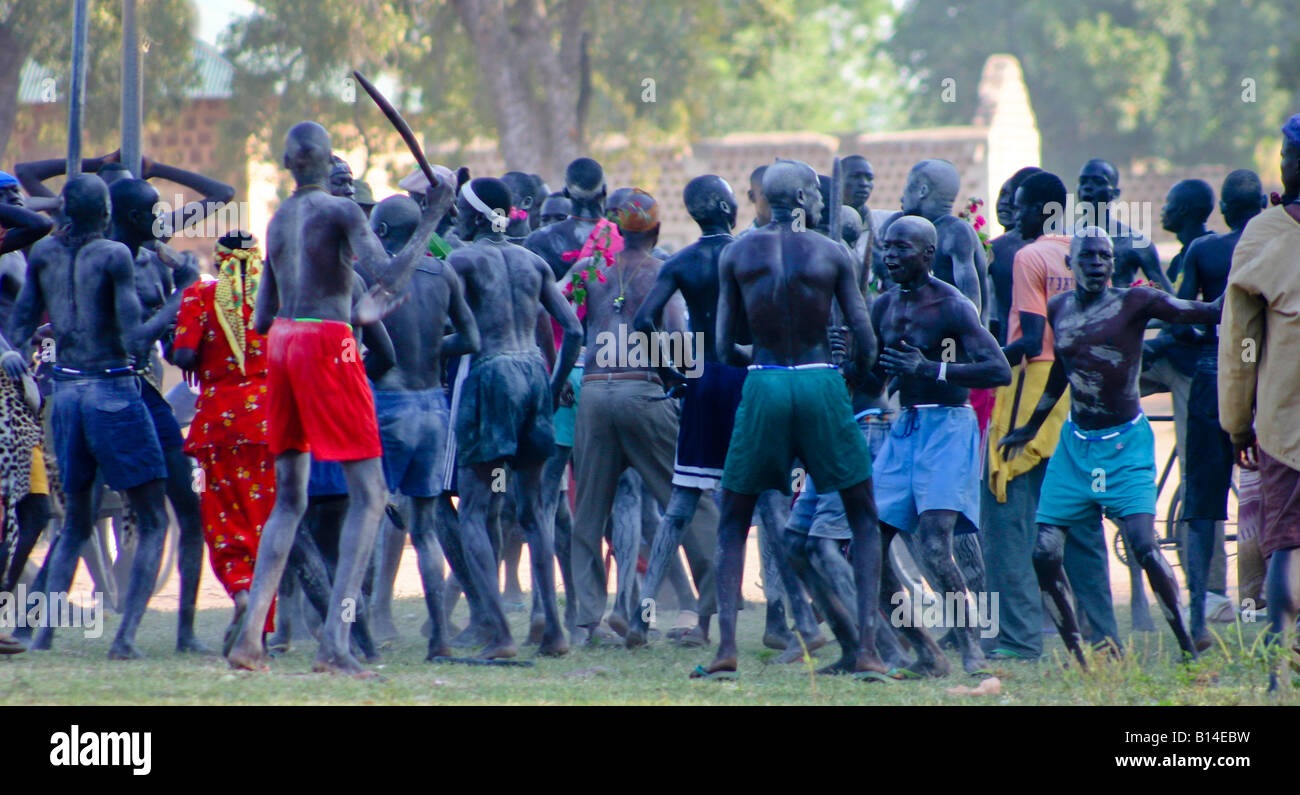 Every Dinka male is a warrior. These young men group at an annual gathering to select a new song for their warrior age-set Stock Photohttps://www.alamy.com/image-license-details/?v=1https://www.alamy.com/stock-photo-every-dinka-male-is-a-warrior-these-young-men-group-at-an-annual-gathering-17924141.html
Every Dinka male is a warrior. These young men group at an annual gathering to select a new song for their warrior age-set Stock Photohttps://www.alamy.com/image-license-details/?v=1https://www.alamy.com/stock-photo-every-dinka-male-is-a-warrior-these-young-men-group-at-an-annual-gathering-17924141.htmlRMB14EBW–Every Dinka male is a warrior. These young men group at an annual gathering to select a new song for their warrior age-set
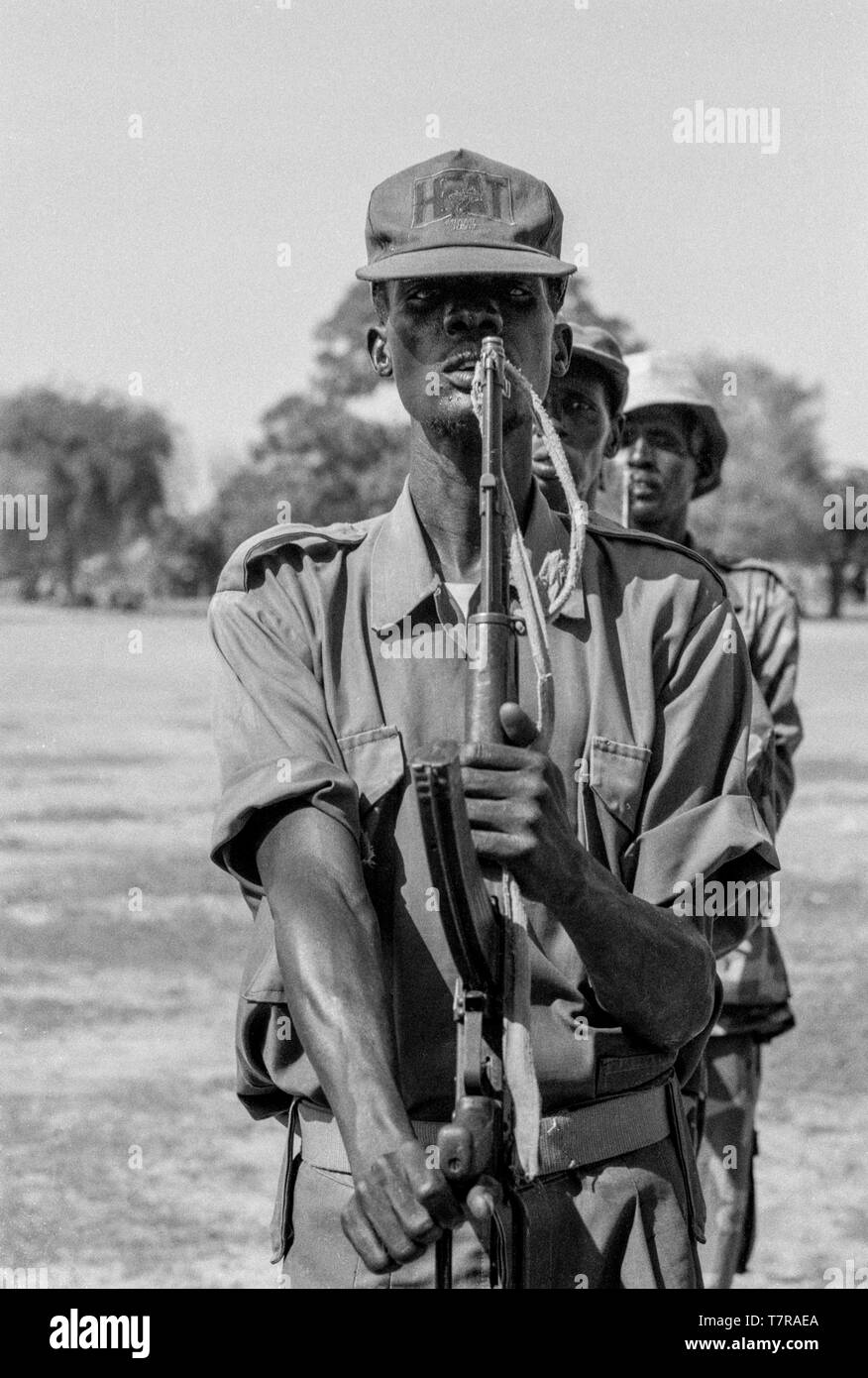 In a small town of Malual kon in south Sudan, the SPLA (Sudanese People Liberation Army) takes part in a Peace Rally to demonstrate their acceptance of the Peace Agreement by laying down their arms. Stock Photohttps://www.alamy.com/image-license-details/?v=1https://www.alamy.com/in-a-small-town-of-malual-kon-in-south-sudan-the-spla-sudanese-people-liberation-army-takes-part-in-a-peace-rally-to-demonstrate-their-acceptance-of-the-peace-agreement-by-laying-down-their-arms-image245760882.html
In a small town of Malual kon in south Sudan, the SPLA (Sudanese People Liberation Army) takes part in a Peace Rally to demonstrate their acceptance of the Peace Agreement by laying down their arms. Stock Photohttps://www.alamy.com/image-license-details/?v=1https://www.alamy.com/in-a-small-town-of-malual-kon-in-south-sudan-the-spla-sudanese-people-liberation-army-takes-part-in-a-peace-rally-to-demonstrate-their-acceptance-of-the-peace-agreement-by-laying-down-their-arms-image245760882.htmlRMT7RAEA–In a small town of Malual kon in south Sudan, the SPLA (Sudanese People Liberation Army) takes part in a Peace Rally to demonstrate their acceptance of the Peace Agreement by laying down their arms.
 Beja Tribe Men Dancing In Front Of The Khatmiyah Mosque At The Base Of The Taka Mountains, Kassala, Sudan Stock Photohttps://www.alamy.com/image-license-details/?v=1https://www.alamy.com/stock-photo-beja-tribe-men-dancing-in-front-of-the-khatmiyah-mosque-at-the-base-55549754.html
Beja Tribe Men Dancing In Front Of The Khatmiyah Mosque At The Base Of The Taka Mountains, Kassala, Sudan Stock Photohttps://www.alamy.com/image-license-details/?v=1https://www.alamy.com/stock-photo-beja-tribe-men-dancing-in-front-of-the-khatmiyah-mosque-at-the-base-55549754.htmlRMD6AE7P–Beja Tribe Men Dancing In Front Of The Khatmiyah Mosque At The Base Of The Taka Mountains, Kassala, Sudan
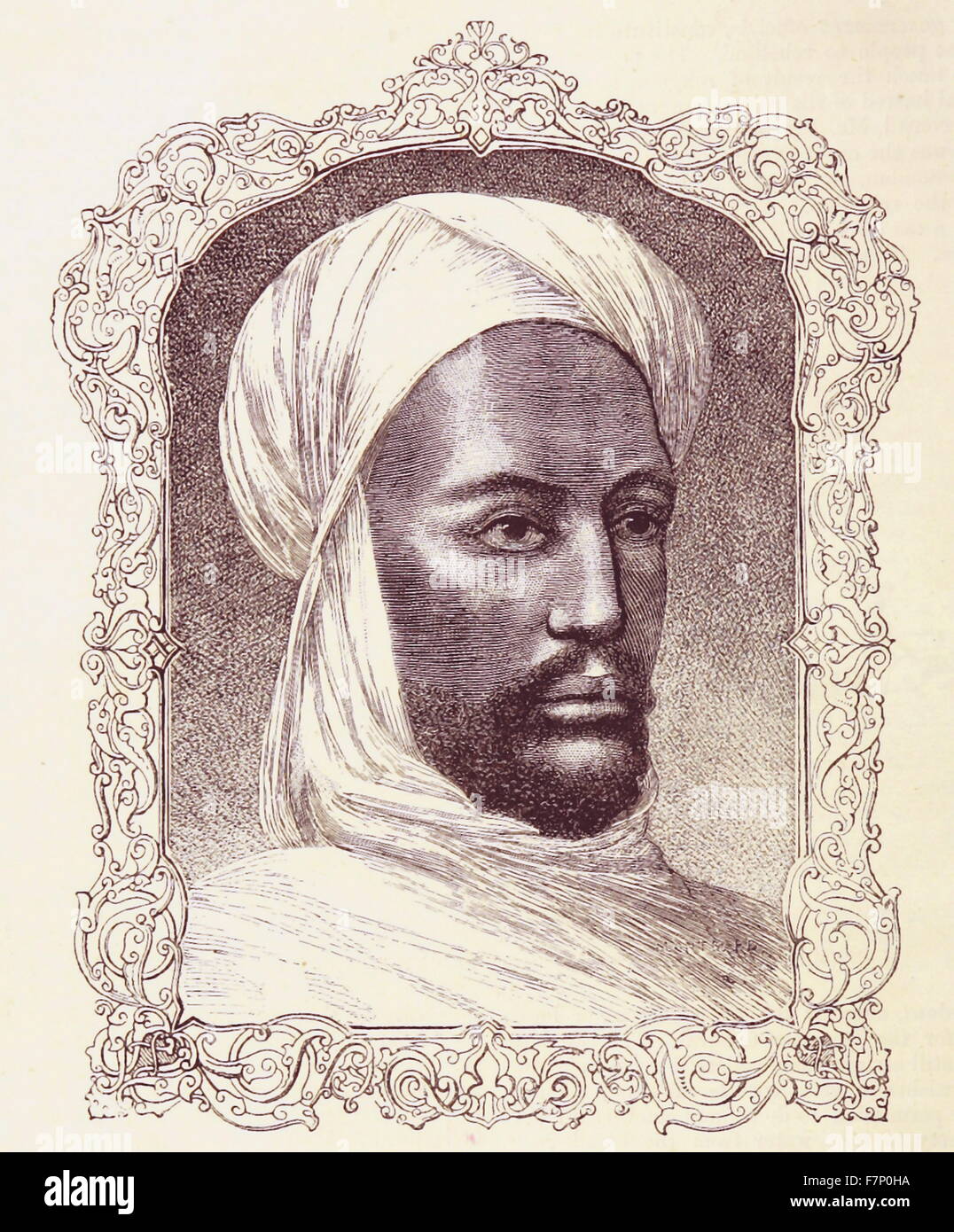 Muhammad Ahmad bin Abd Allah (1844 – June 22, 1885) religious leader of the Samaniyya order in Sudan who, on June 29, 1881, proclaimed himself the Mahdi (or Mahdi), the messianic redeemer of the Islamic faith. Stock Photohttps://www.alamy.com/image-license-details/?v=1https://www.alamy.com/stock-photo-muhammad-ahmad-bin-abd-allah-1844-june-22-1885-religious-leader-of-90837862.html
Muhammad Ahmad bin Abd Allah (1844 – June 22, 1885) religious leader of the Samaniyya order in Sudan who, on June 29, 1881, proclaimed himself the Mahdi (or Mahdi), the messianic redeemer of the Islamic faith. Stock Photohttps://www.alamy.com/image-license-details/?v=1https://www.alamy.com/stock-photo-muhammad-ahmad-bin-abd-allah-1844-june-22-1885-religious-leader-of-90837862.htmlRMF7P0HA–Muhammad Ahmad bin Abd Allah (1844 – June 22, 1885) religious leader of the Samaniyya order in Sudan who, on June 29, 1881, proclaimed himself the Mahdi (or Mahdi), the messianic redeemer of the Islamic faith.
 British imperialism. Sudan. Africa. English army attacking. Colored engraving, 1898. Stock Photohttps://www.alamy.com/image-license-details/?v=1https://www.alamy.com/british-imperialism-sudan-africa-english-army-attacking-colored-engraving-1898-image220375746.html
British imperialism. Sudan. Africa. English army attacking. Colored engraving, 1898. Stock Photohttps://www.alamy.com/image-license-details/?v=1https://www.alamy.com/british-imperialism-sudan-africa-english-army-attacking-colored-engraving-1898-image220375746.htmlRMPPEYEA–British imperialism. Sudan. Africa. English army attacking. Colored engraving, 1898.
 Kerma, Sudan, February 8., 2019: Close-up view of a warrior statue in the museum of Kerma, Sudan Stock Photohttps://www.alamy.com/image-license-details/?v=1https://www.alamy.com/kerma-sudan-february-8-2019-close-up-view-of-a-warrior-statue-in-the-museum-of-kerma-sudan-image239892887.html
Kerma, Sudan, February 8., 2019: Close-up view of a warrior statue in the museum of Kerma, Sudan Stock Photohttps://www.alamy.com/image-license-details/?v=1https://www.alamy.com/kerma-sudan-february-8-2019-close-up-view-of-a-warrior-statue-in-the-museum-of-kerma-sudan-image239892887.htmlRFRX81R3–Kerma, Sudan, February 8., 2019: Close-up view of a warrior statue in the museum of Kerma, Sudan
 A NATIVE WARRIOR, ILLELA, CENTRAL SUDAN from the book ' The living races of mankind ' a popular illustrated account of the customs, habits, pursuits, feasts & ceremonies of the races of mankind throughout the world by Sir Harry Hamilton Johnston, and Henry Neville Hutchinson Published in London by Hutchinson & Co. in 1902 Stock Photohttps://www.alamy.com/image-license-details/?v=1https://www.alamy.com/a-native-warrior-illela-central-sudan-from-the-book-the-living-races-of-mankind-a-popular-illustrated-account-of-the-customs-habits-pursuits-feasts-ceremonies-of-the-races-of-mankind-throughout-the-world-by-sir-harry-hamilton-johnston-and-henry-neville-hutchinson-published-in-london-by-hutchinson-co-in-1902-image461256473.html
A NATIVE WARRIOR, ILLELA, CENTRAL SUDAN from the book ' The living races of mankind ' a popular illustrated account of the customs, habits, pursuits, feasts & ceremonies of the races of mankind throughout the world by Sir Harry Hamilton Johnston, and Henry Neville Hutchinson Published in London by Hutchinson & Co. in 1902 Stock Photohttps://www.alamy.com/image-license-details/?v=1https://www.alamy.com/a-native-warrior-illela-central-sudan-from-the-book-the-living-races-of-mankind-a-popular-illustrated-account-of-the-customs-habits-pursuits-feasts-ceremonies-of-the-races-of-mankind-throughout-the-world-by-sir-harry-hamilton-johnston-and-henry-neville-hutchinson-published-in-london-by-hutchinson-co-in-1902-image461256473.htmlRF2HPC19D–A NATIVE WARRIOR, ILLELA, CENTRAL SUDAN from the book ' The living races of mankind ' a popular illustrated account of the customs, habits, pursuits, feasts & ceremonies of the races of mankind throughout the world by Sir Harry Hamilton Johnston, and Henry Neville Hutchinson Published in London by Hutchinson & Co. in 1902
 African Maasai spear head on skin shield. Stock Photohttps://www.alamy.com/image-license-details/?v=1https://www.alamy.com/stock-photo-african-maasai-spear-head-on-skin-shield-97303073.html
African Maasai spear head on skin shield. Stock Photohttps://www.alamy.com/image-license-details/?v=1https://www.alamy.com/stock-photo-african-maasai-spear-head-on-skin-shield-97303073.htmlRFFJ8F1N–African Maasai spear head on skin shield.
 Bari Attack on Samuel Baker Military Expedition, 19th Century Stock Photohttps://www.alamy.com/image-license-details/?v=1https://www.alamy.com/bari-attack-on-samuel-baker-military-expedition-19th-century-image352774306.html
Bari Attack on Samuel Baker Military Expedition, 19th Century Stock Photohttps://www.alamy.com/image-license-details/?v=1https://www.alamy.com/bari-attack-on-samuel-baker-military-expedition-19th-century-image352774306.htmlRM2BDX76A–Bari Attack on Samuel Baker Military Expedition, 19th Century
 Men from the Toposa tribe posing in their traditional warrior costume, Eastern Equatoria, South Sudan Stock Photohttps://www.alamy.com/image-license-details/?v=1https://www.alamy.com/men-from-the-toposa-tribe-posing-in-their-traditional-warrior-costume-eastern-equatoria-south-sudan-image447854735.html
Men from the Toposa tribe posing in their traditional warrior costume, Eastern Equatoria, South Sudan Stock Photohttps://www.alamy.com/image-license-details/?v=1https://www.alamy.com/men-from-the-toposa-tribe-posing-in-their-traditional-warrior-costume-eastern-equatoria-south-sudan-image447854735.htmlRM2H0HF7Y–Men from the Toposa tribe posing in their traditional warrior costume, Eastern Equatoria, South Sudan
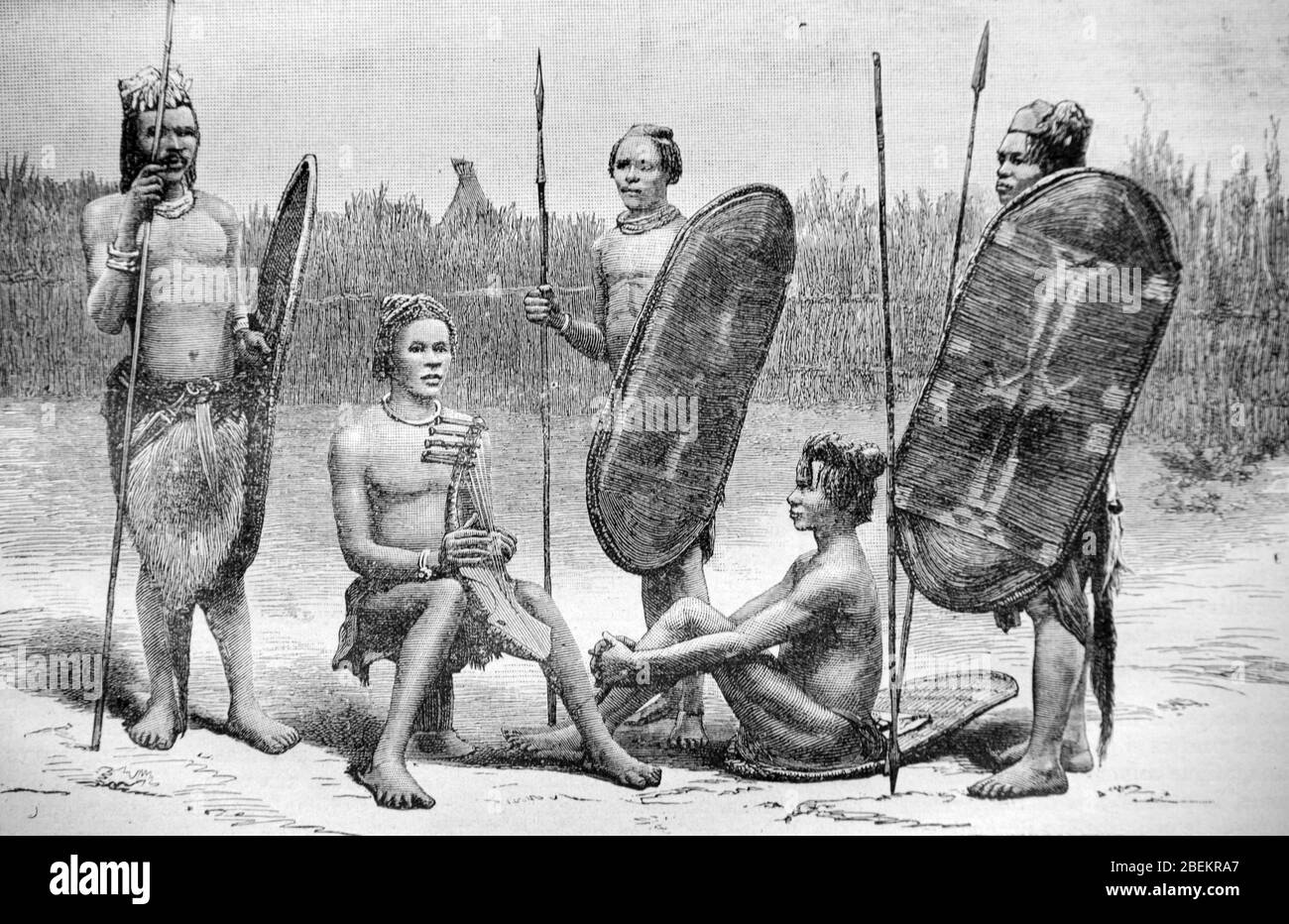 Niam-niam or nyam-nyam Warriors with Shields and Spears, now the Zande People or Azande, an Ethnic Group of North Central Africa including parts of Congo, South Sudan and the Central African Republic. Vintage or Old Illustration or Engraving 1887. Stock Photohttps://www.alamy.com/image-license-details/?v=1https://www.alamy.com/niam-niam-or-nyam-nyam-warriors-with-shields-and-spears-now-the-zande-people-or-azande-an-ethnic-group-of-north-central-africa-including-parts-of-congo-south-sudan-and-the-central-african-republic-vintage-or-old-illustration-or-engraving-1887-image353247951.html
Niam-niam or nyam-nyam Warriors with Shields and Spears, now the Zande People or Azande, an Ethnic Group of North Central Africa including parts of Congo, South Sudan and the Central African Republic. Vintage or Old Illustration or Engraving 1887. Stock Photohttps://www.alamy.com/image-license-details/?v=1https://www.alamy.com/niam-niam-or-nyam-nyam-warriors-with-shields-and-spears-now-the-zande-people-or-azande-an-ethnic-group-of-north-central-africa-including-parts-of-congo-south-sudan-and-the-central-african-republic-vintage-or-old-illustration-or-engraving-1887-image353247951.htmlRM2BEKRA7–Niam-niam or nyam-nyam Warriors with Shields and Spears, now the Zande People or Azande, an Ethnic Group of North Central Africa including parts of Congo, South Sudan and the Central African Republic. Vintage or Old Illustration or Engraving 1887.
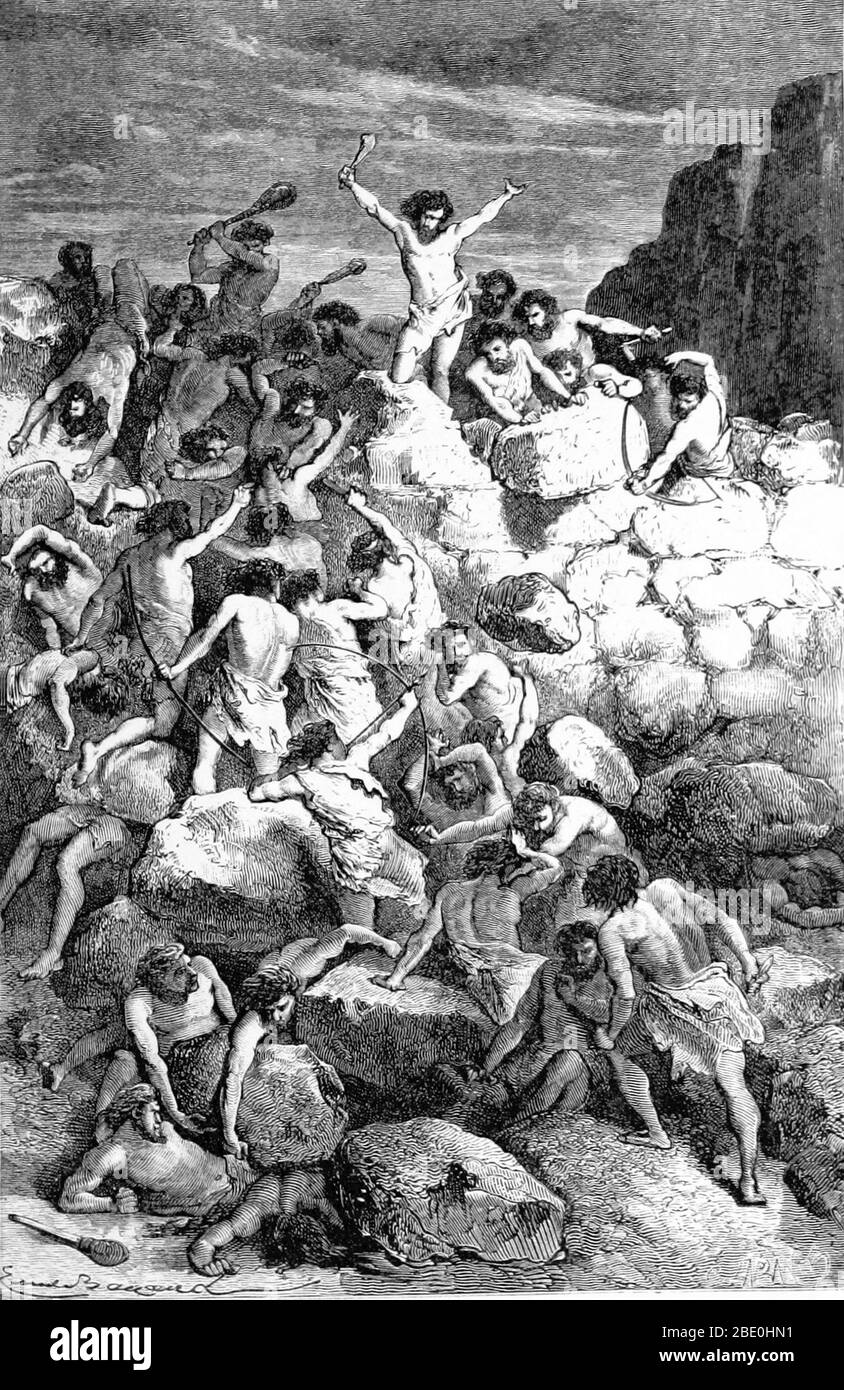 When humans first began fighting wars is a matter of debate among anthropologists and historians. The first archeological record of what could be a prehistoric battle is at a Mesolithic site known as Cemetery 117. It was determined to be about 14,340 to 13,140 years old and located on the Nile near the Egypt-Sudan border. It contains a large number of bodies, many with arrowheads embedded in their skeletons, which indicates that they may have been the casualties of a battle. Beginning around 12,000 BC, combat was transformed by the development of bows, maces, and slings. The bow seems to have Stock Photohttps://www.alamy.com/image-license-details/?v=1https://www.alamy.com/when-humans-first-began-fighting-wars-is-a-matter-of-debate-among-anthropologists-and-historians-the-first-archeological-record-of-what-could-be-a-prehistoric-battle-is-at-a-mesolithic-site-known-as-cemetery-117-it-was-determined-to-be-about-14340-to-13140-years-old-and-located-on-the-nile-near-the-egypt-sudan-border-it-contains-a-large-number-of-bodies-many-with-arrowheads-embedded-in-their-skeletons-which-indicates-that-they-may-have-been-the-casualties-of-a-battle-beginning-around-12000-bc-combat-was-transformed-by-the-development-of-bows-maces-and-slings-the-bow-seems-to-have-image352826461.html
When humans first began fighting wars is a matter of debate among anthropologists and historians. The first archeological record of what could be a prehistoric battle is at a Mesolithic site known as Cemetery 117. It was determined to be about 14,340 to 13,140 years old and located on the Nile near the Egypt-Sudan border. It contains a large number of bodies, many with arrowheads embedded in their skeletons, which indicates that they may have been the casualties of a battle. Beginning around 12,000 BC, combat was transformed by the development of bows, maces, and slings. The bow seems to have Stock Photohttps://www.alamy.com/image-license-details/?v=1https://www.alamy.com/when-humans-first-began-fighting-wars-is-a-matter-of-debate-among-anthropologists-and-historians-the-first-archeological-record-of-what-could-be-a-prehistoric-battle-is-at-a-mesolithic-site-known-as-cemetery-117-it-was-determined-to-be-about-14340-to-13140-years-old-and-located-on-the-nile-near-the-egypt-sudan-border-it-contains-a-large-number-of-bodies-many-with-arrowheads-embedded-in-their-skeletons-which-indicates-that-they-may-have-been-the-casualties-of-a-battle-beginning-around-12000-bc-combat-was-transformed-by-the-development-of-bows-maces-and-slings-the-bow-seems-to-have-image352826461.htmlRM2BE0HN1–When humans first began fighting wars is a matter of debate among anthropologists and historians. The first archeological record of what could be a prehistoric battle is at a Mesolithic site known as Cemetery 117. It was determined to be about 14,340 to 13,140 years old and located on the Nile near the Egypt-Sudan border. It contains a large number of bodies, many with arrowheads embedded in their skeletons, which indicates that they may have been the casualties of a battle. Beginning around 12,000 BC, combat was transformed by the development of bows, maces, and slings. The bow seems to have
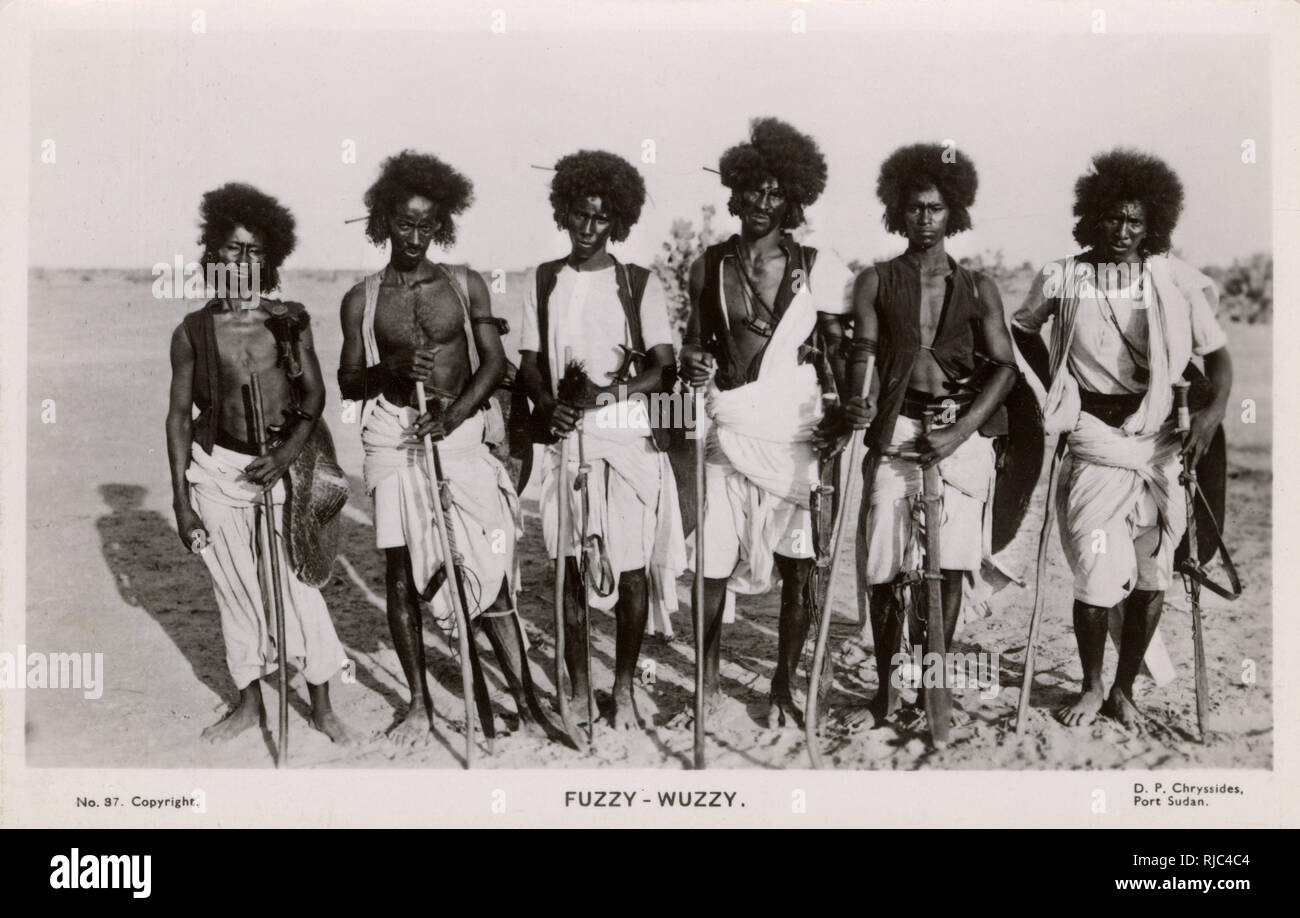 Sudan - A group of Hadendoa Warriors. The Hadendoa is the name of a nomadic subdivision of the Beja people, known for their support of the Mahdiyyah rebellion during the 1880s to 1890s. The area historically inhabited by the Hadendoa is today parts of Sudan, Egypt and Eritrea. Their elaborate hairdressing (pictured here) gained them the name of 'Fuzzy-wuzzies' among the British troops during the Mahdist War. Stock Photohttps://www.alamy.com/image-license-details/?v=1https://www.alamy.com/sudan-a-group-of-hadendoa-warriors-the-hadendoa-is-the-name-of-a-nomadic-subdivision-of-the-beja-people-known-for-their-support-of-the-mahdiyyah-rebellion-during-the-1880s-to-1890s-the-area-historically-inhabited-by-the-hadendoa-is-today-parts-of-sudan-egypt-and-eritrea-their-elaborate-hairdressing-pictured-here-gained-them-the-name-of-fuzzy-wuzzies-among-the-british-troops-during-the-mahdist-war-image235065492.html
Sudan - A group of Hadendoa Warriors. The Hadendoa is the name of a nomadic subdivision of the Beja people, known for their support of the Mahdiyyah rebellion during the 1880s to 1890s. The area historically inhabited by the Hadendoa is today parts of Sudan, Egypt and Eritrea. Their elaborate hairdressing (pictured here) gained them the name of 'Fuzzy-wuzzies' among the British troops during the Mahdist War. Stock Photohttps://www.alamy.com/image-license-details/?v=1https://www.alamy.com/sudan-a-group-of-hadendoa-warriors-the-hadendoa-is-the-name-of-a-nomadic-subdivision-of-the-beja-people-known-for-their-support-of-the-mahdiyyah-rebellion-during-the-1880s-to-1890s-the-area-historically-inhabited-by-the-hadendoa-is-today-parts-of-sudan-egypt-and-eritrea-their-elaborate-hairdressing-pictured-here-gained-them-the-name-of-fuzzy-wuzzies-among-the-british-troops-during-the-mahdist-war-image235065492.htmlRMRJC4C4–Sudan - A group of Hadendoa Warriors. The Hadendoa is the name of a nomadic subdivision of the Beja people, known for their support of the Mahdiyyah rebellion during the 1880s to 1890s. The area historically inhabited by the Hadendoa is today parts of Sudan, Egypt and Eritrea. Their elaborate hairdressing (pictured here) gained them the name of 'Fuzzy-wuzzies' among the British troops during the Mahdist War.
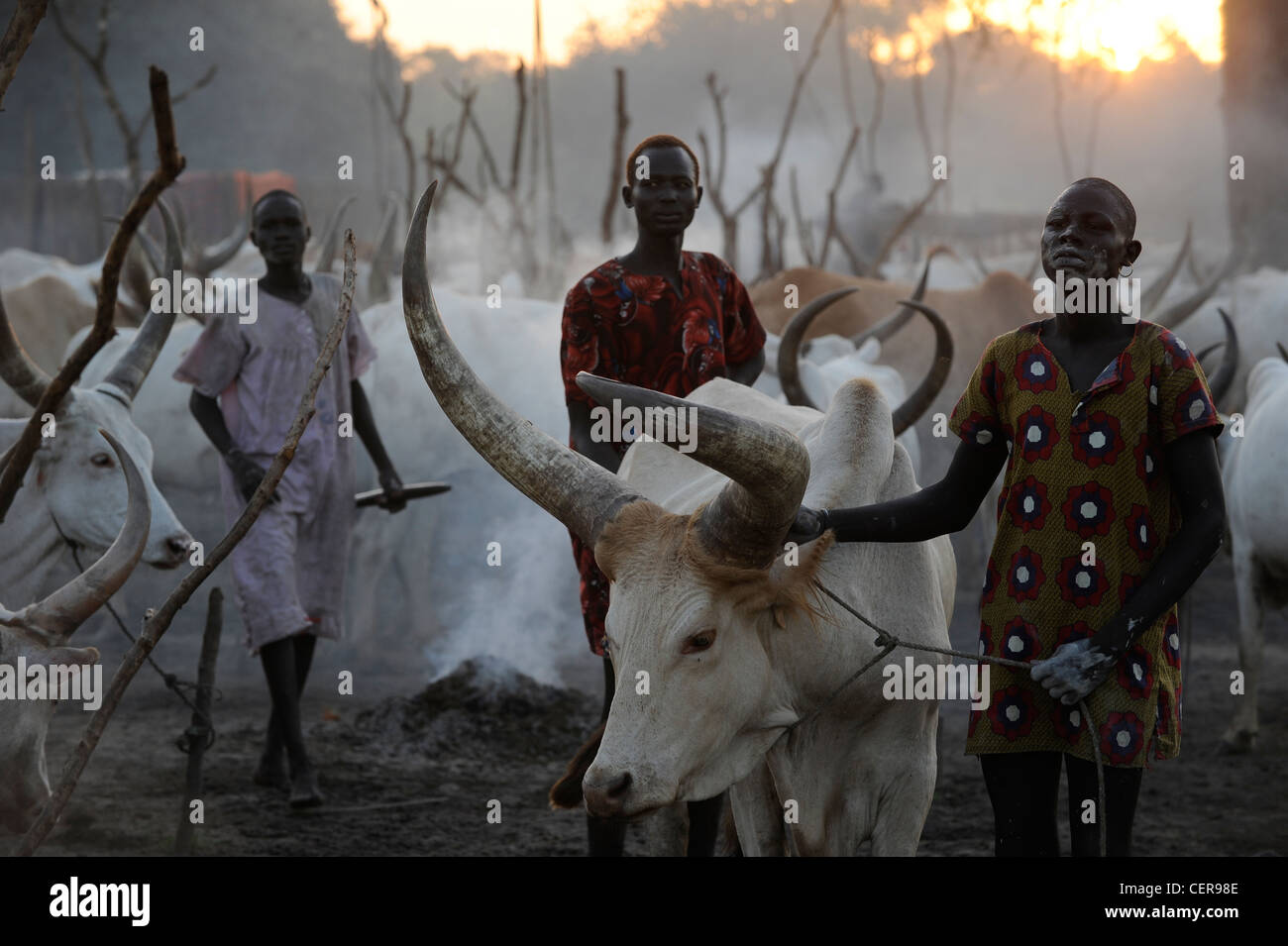 SOUTHERN SUDAN, Bahr al Ghazal region , Lakes State, Dinka tribe with Zebu cows in cattle camp near Rumbek Stock Photohttps://www.alamy.com/image-license-details/?v=1https://www.alamy.com/stock-photo-southern-sudan-bahr-al-ghazal-region-lakes-state-dinka-tribe-with-43538110.html
SOUTHERN SUDAN, Bahr al Ghazal region , Lakes State, Dinka tribe with Zebu cows in cattle camp near Rumbek Stock Photohttps://www.alamy.com/image-license-details/?v=1https://www.alamy.com/stock-photo-southern-sudan-bahr-al-ghazal-region-lakes-state-dinka-tribe-with-43538110.htmlRMCER98E–SOUTHERN SUDAN, Bahr al Ghazal region , Lakes State, Dinka tribe with Zebu cows in cattle camp near Rumbek
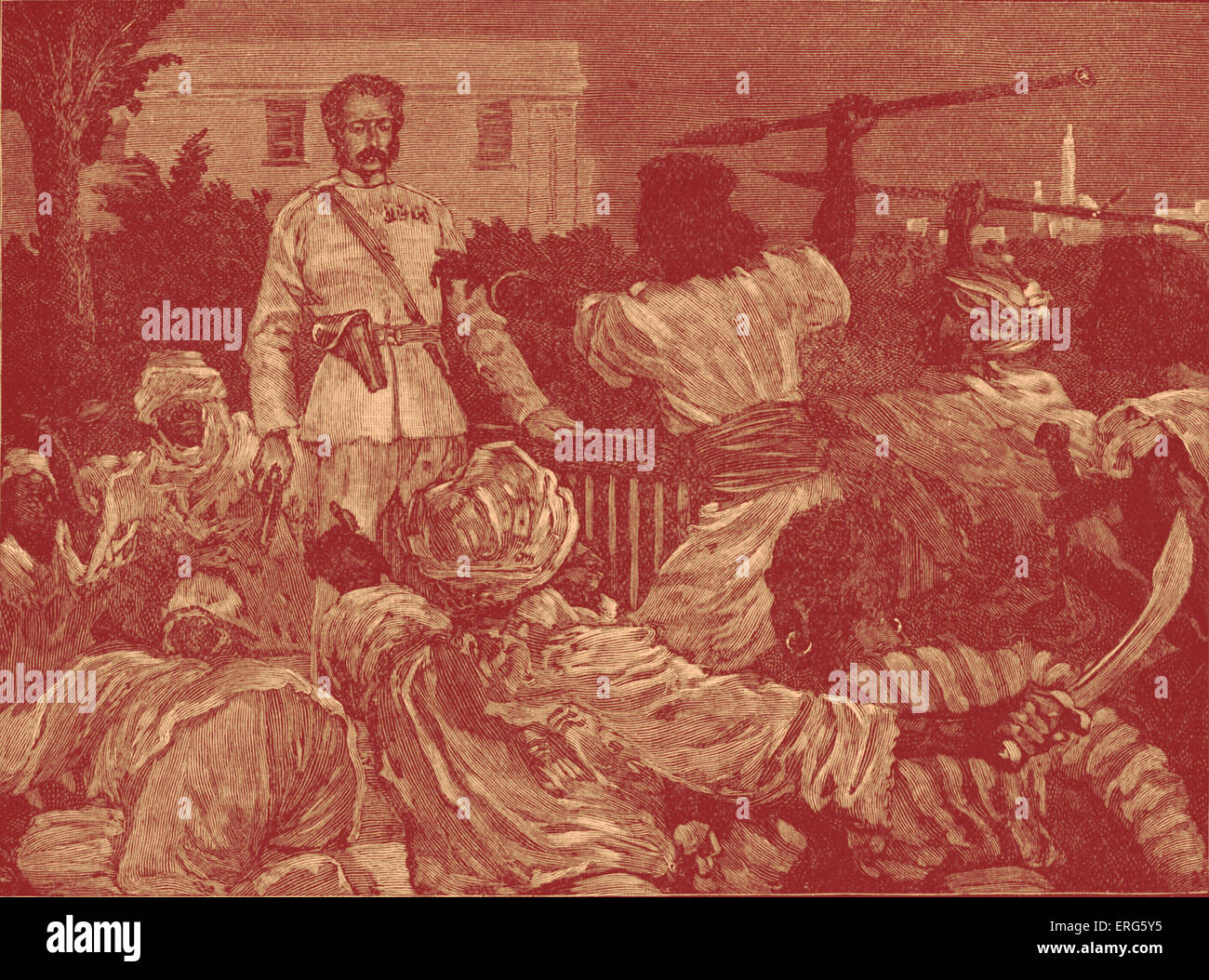 General Gordon's Last Stand. Gordon about to be attacked by warriors of the Mahdi in Khartoum, Sudan. GG:: British army officer Stock Photohttps://www.alamy.com/image-license-details/?v=1https://www.alamy.com/stock-photo-general-gordons-last-stand-gordon-about-to-be-attacked-by-warriors-83334473.html
General Gordon's Last Stand. Gordon about to be attacked by warriors of the Mahdi in Khartoum, Sudan. GG:: British army officer Stock Photohttps://www.alamy.com/image-license-details/?v=1https://www.alamy.com/stock-photo-general-gordons-last-stand-gordon-about-to-be-attacked-by-warriors-83334473.htmlRMERG5Y5–General Gordon's Last Stand. Gordon about to be attacked by warriors of the Mahdi in Khartoum, Sudan. GG:: British army officer
!['The Death of the Khalifa', 1899, (c1900). Abdallahi ibn Muhammad, styled Khalifat al-Mahdi (usually rendered as 'Khalifa'), was caught and killed by Sir Reginald Wingate's Egyptian column at Umm Diwaikarat in Kordofan on 25 November 1899. His death marked the defeat of the Mahdist State in Sudan. From "Cassell's History of England, Vol. IX". [Cassell and Company, Limited, London, Paris, New York & Melbourne] Stock Photo 'The Death of the Khalifa', 1899, (c1900). Abdallahi ibn Muhammad, styled Khalifat al-Mahdi (usually rendered as 'Khalifa'), was caught and killed by Sir Reginald Wingate's Egyptian column at Umm Diwaikarat in Kordofan on 25 November 1899. His death marked the defeat of the Mahdist State in Sudan. From "Cassell's History of England, Vol. IX". [Cassell and Company, Limited, London, Paris, New York & Melbourne] Stock Photo](https://c8.alamy.com/comp/2R8Y2KA/the-death-of-the-khalifa-1899-c1900-abdallahi-ibn-muhammad-styled-khalifat-al-mahdi-usually-rendered-as-khalifa-was-caught-and-killed-by-sir-reginald-wingates-egyptian-column-at-umm-diwaikarat-in-kordofan-on-25-november-1899-his-death-marked-the-defeat-of-the-mahdist-state-in-sudan-from-quotcassells-history-of-england-vol-ixquot-cassell-and-company-limited-london-paris-new-york-amp-melbourne-2R8Y2KA.jpg) 'The Death of the Khalifa', 1899, (c1900). Abdallahi ibn Muhammad, styled Khalifat al-Mahdi (usually rendered as 'Khalifa'), was caught and killed by Sir Reginald Wingate's Egyptian column at Umm Diwaikarat in Kordofan on 25 November 1899. His death marked the defeat of the Mahdist State in Sudan. From "Cassell's History of England, Vol. IX". [Cassell and Company, Limited, London, Paris, New York & Melbourne] Stock Photohttps://www.alamy.com/image-license-details/?v=1https://www.alamy.com/the-death-of-the-khalifa-1899-c1900-abdallahi-ibn-muhammad-styled-khalifat-al-mahdi-usually-rendered-as-khalifa-was-caught-and-killed-by-sir-reginald-wingates-egyptian-column-at-umm-diwaikarat-in-kordofan-on-25-november-1899-his-death-marked-the-defeat-of-the-mahdist-state-in-sudan-from-quotcassells-history-of-england-vol-ixquot-cassell-and-company-limited-london-paris-new-york-amp-melbourne-image556243838.html
'The Death of the Khalifa', 1899, (c1900). Abdallahi ibn Muhammad, styled Khalifat al-Mahdi (usually rendered as 'Khalifa'), was caught and killed by Sir Reginald Wingate's Egyptian column at Umm Diwaikarat in Kordofan on 25 November 1899. His death marked the defeat of the Mahdist State in Sudan. From "Cassell's History of England, Vol. IX". [Cassell and Company, Limited, London, Paris, New York & Melbourne] Stock Photohttps://www.alamy.com/image-license-details/?v=1https://www.alamy.com/the-death-of-the-khalifa-1899-c1900-abdallahi-ibn-muhammad-styled-khalifat-al-mahdi-usually-rendered-as-khalifa-was-caught-and-killed-by-sir-reginald-wingates-egyptian-column-at-umm-diwaikarat-in-kordofan-on-25-november-1899-his-death-marked-the-defeat-of-the-mahdist-state-in-sudan-from-quotcassells-history-of-england-vol-ixquot-cassell-and-company-limited-london-paris-new-york-amp-melbourne-image556243838.htmlRM2R8Y2KA–'The Death of the Khalifa', 1899, (c1900). Abdallahi ibn Muhammad, styled Khalifat al-Mahdi (usually rendered as 'Khalifa'), was caught and killed by Sir Reginald Wingate's Egyptian column at Umm Diwaikarat in Kordofan on 25 November 1899. His death marked the defeat of the Mahdist State in Sudan. From "Cassell's History of England, Vol. IX". [Cassell and Company, Limited, London, Paris, New York & Melbourne]
 MUNDARI TRIBE, SOUTH SUDAN - MARCH 11, 2020: Young men smiling and wrestling on field near cattle of Mundari Tribe on sunny day in South Sudan, Africa Stock Photohttps://www.alamy.com/image-license-details/?v=1https://www.alamy.com/mundari-tribe-south-sudan-march-11-2020-young-men-smiling-and-wrestling-on-field-near-cattle-of-mundari-tribe-on-sunny-day-in-south-sudan-africa-image359306342.html
MUNDARI TRIBE, SOUTH SUDAN - MARCH 11, 2020: Young men smiling and wrestling on field near cattle of Mundari Tribe on sunny day in South Sudan, Africa Stock Photohttps://www.alamy.com/image-license-details/?v=1https://www.alamy.com/mundari-tribe-south-sudan-march-11-2020-young-men-smiling-and-wrestling-on-field-near-cattle-of-mundari-tribe-on-sunny-day-in-south-sudan-africa-image359306342.htmlRF2BTFPWA–MUNDARI TRIBE, SOUTH SUDAN - MARCH 11, 2020: Young men smiling and wrestling on field near cattle of Mundari Tribe on sunny day in South Sudan, Africa
 Soldier from Sudan Stock Photohttps://www.alamy.com/image-license-details/?v=1https://www.alamy.com/soldier-from-sudan-image60455260.html
Soldier from Sudan Stock Photohttps://www.alamy.com/image-license-details/?v=1https://www.alamy.com/soldier-from-sudan-image60455260.htmlRFDE9Y8C–Soldier from Sudan
 An armed ranger in northern Uganda's Kidepo Valley national park patrols along the Sudan-Uganda border. Stock Photohttps://www.alamy.com/image-license-details/?v=1https://www.alamy.com/stock-photo-an-armed-ranger-in-northern-ugandas-kidepo-valley-national-park-patrols-31969726.html
An armed ranger in northern Uganda's Kidepo Valley national park patrols along the Sudan-Uganda border. Stock Photohttps://www.alamy.com/image-license-details/?v=1https://www.alamy.com/stock-photo-an-armed-ranger-in-northern-ugandas-kidepo-valley-national-park-patrols-31969726.htmlRMBT09KX–An armed ranger in northern Uganda's Kidepo Valley national park patrols along the Sudan-Uganda border.
 JONGLEI, SOUTH SUDAN-DECEMBER 4, 2010: Unidentified shepherd walks down the road in Jonglei county, South Sudan Stock Photohttps://www.alamy.com/image-license-details/?v=1https://www.alamy.com/jonglei-south-sudan-december-4-2010-unidentified-shepherd-walks-down-the-road-in-jonglei-county-south-sudan-image265600488.html
JONGLEI, SOUTH SUDAN-DECEMBER 4, 2010: Unidentified shepherd walks down the road in Jonglei county, South Sudan Stock Photohttps://www.alamy.com/image-license-details/?v=1https://www.alamy.com/jonglei-south-sudan-december-4-2010-unidentified-shepherd-walks-down-the-road-in-jonglei-county-south-sudan-image265600488.htmlRFWC343M–JONGLEI, SOUTH SUDAN-DECEMBER 4, 2010: Unidentified shepherd walks down the road in Jonglei county, South Sudan
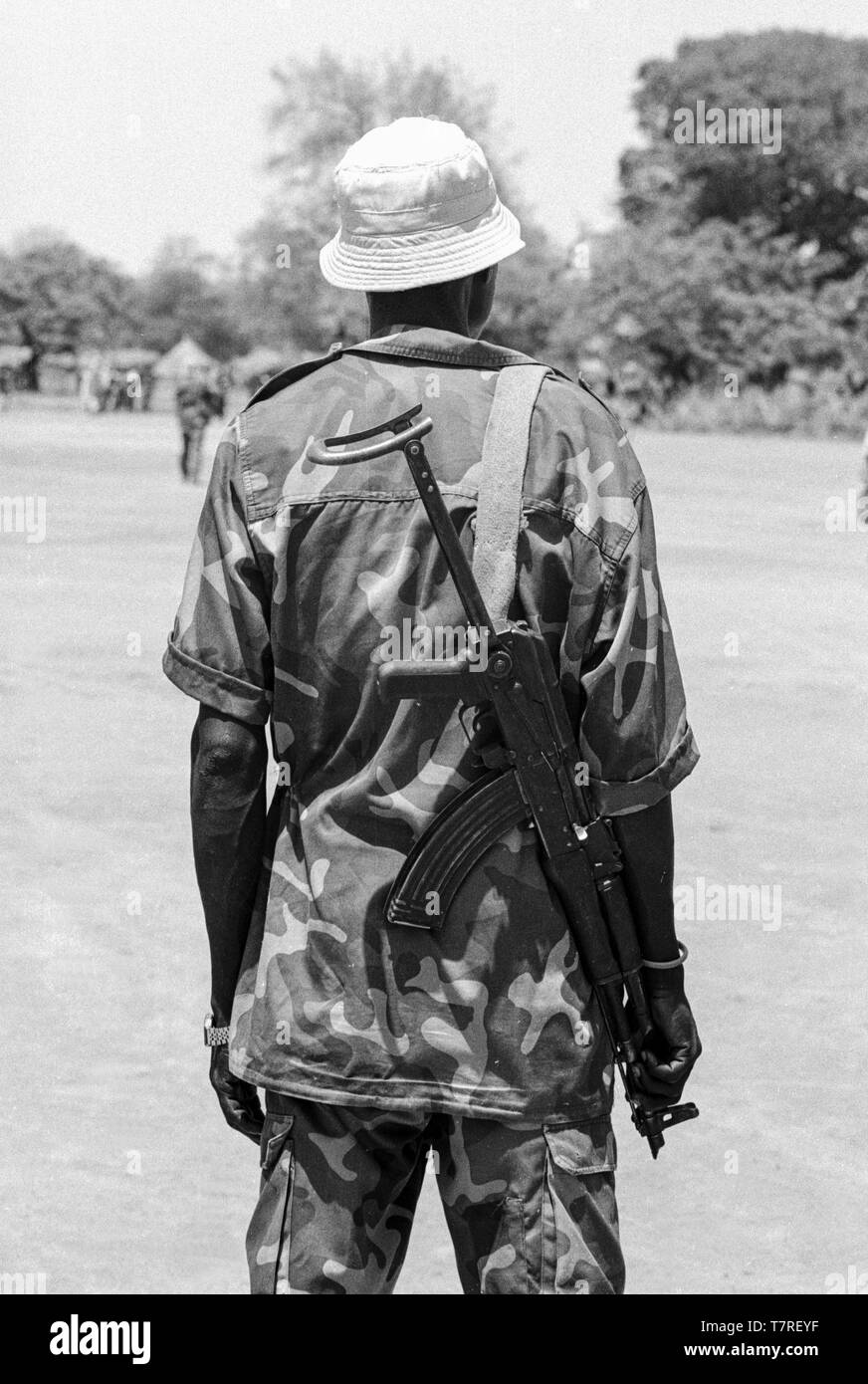 In a small town of Malual kon in south Sudan, the SPLA (Sudanese People Liberation Army) takes part in a Peace Rally to demonstrate their acceptance of the Peace Agreement by laying down their arms. Stock Photohttps://www.alamy.com/image-license-details/?v=1https://www.alamy.com/in-a-small-town-of-malual-kon-in-south-sudan-the-spla-sudanese-people-liberation-army-takes-part-in-a-peace-rally-to-demonstrate-their-acceptance-of-the-peace-agreement-by-laying-down-their-arms-image245764387.html
In a small town of Malual kon in south Sudan, the SPLA (Sudanese People Liberation Army) takes part in a Peace Rally to demonstrate their acceptance of the Peace Agreement by laying down their arms. Stock Photohttps://www.alamy.com/image-license-details/?v=1https://www.alamy.com/in-a-small-town-of-malual-kon-in-south-sudan-the-spla-sudanese-people-liberation-army-takes-part-in-a-peace-rally-to-demonstrate-their-acceptance-of-the-peace-agreement-by-laying-down-their-arms-image245764387.htmlRMT7REYF–In a small town of Malual kon in south Sudan, the SPLA (Sudanese People Liberation Army) takes part in a Peace Rally to demonstrate their acceptance of the Peace Agreement by laying down their arms.
 Beja Tribe Man Dancing In Front Of The Khatmiyah Mosque At The Base Of The Taka Mountains, Kassala, Sudan Stock Photohttps://www.alamy.com/image-license-details/?v=1https://www.alamy.com/stock-photo-beja-tribe-man-dancing-in-front-of-the-khatmiyah-mosque-at-the-base-55549714.html
Beja Tribe Man Dancing In Front Of The Khatmiyah Mosque At The Base Of The Taka Mountains, Kassala, Sudan Stock Photohttps://www.alamy.com/image-license-details/?v=1https://www.alamy.com/stock-photo-beja-tribe-man-dancing-in-front-of-the-khatmiyah-mosque-at-the-base-55549714.htmlRMD6AE6A–Beja Tribe Man Dancing In Front Of The Khatmiyah Mosque At The Base Of The Taka Mountains, Kassala, Sudan
 Flag of Sudan on a computer binary codes falling from the top and fading away. Stock Photohttps://www.alamy.com/image-license-details/?v=1https://www.alamy.com/flag-of-sudan-on-a-computer-binary-codes-falling-from-the-top-and-fading-away-image597686035.html
Flag of Sudan on a computer binary codes falling from the top and fading away. Stock Photohttps://www.alamy.com/image-license-details/?v=1https://www.alamy.com/flag-of-sudan-on-a-computer-binary-codes-falling-from-the-top-and-fading-away-image597686035.htmlRF2WMAXHR–Flag of Sudan on a computer binary codes falling from the top and fading away.
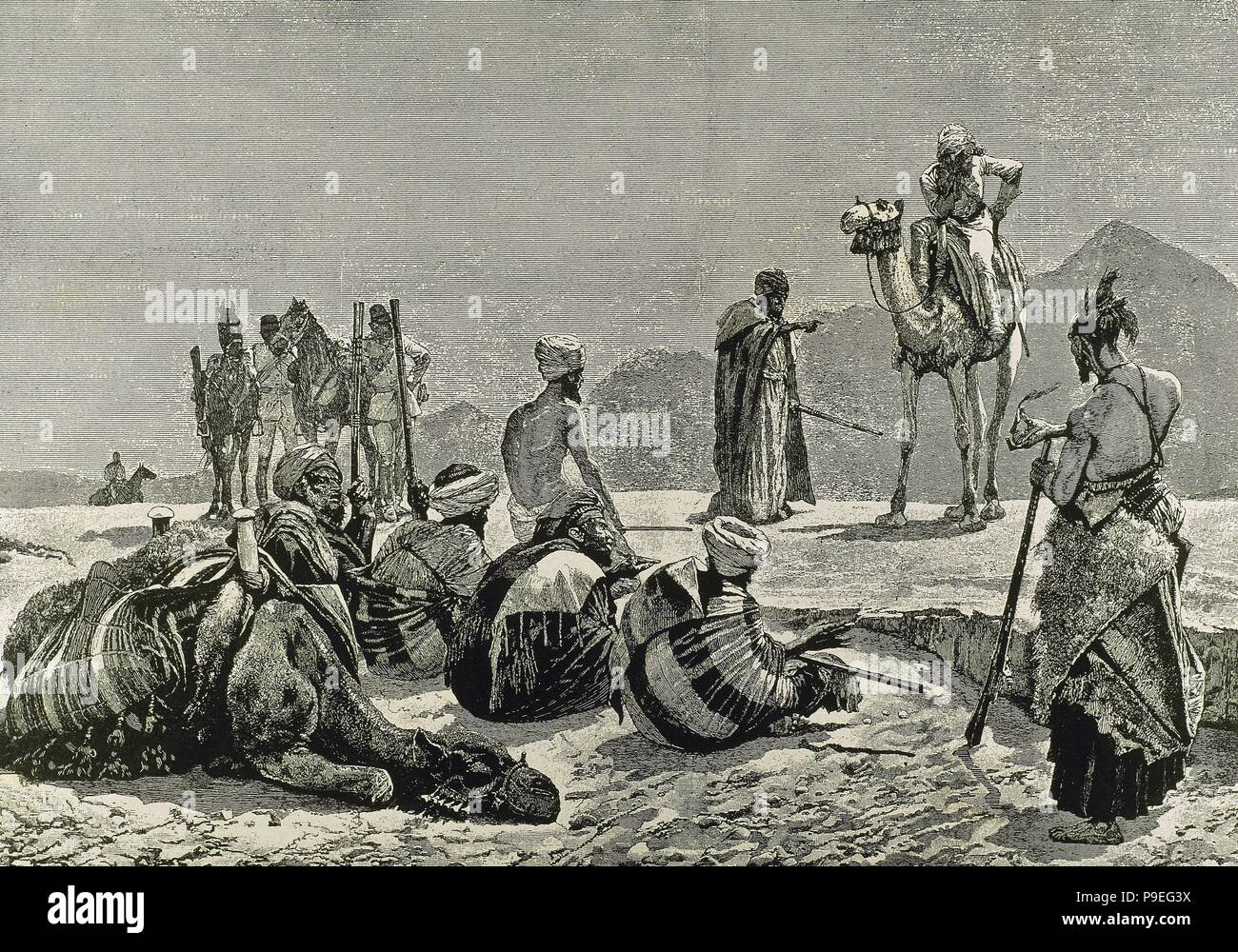 Colonialism. Africa. Charles George Gordon (1833-1855). British General and Governor of Egyptian Sudan. A British exploration by Sudan. Engraving by Caton, 'La Ilustracion Artistica', 1884. Stock Photohttps://www.alamy.com/image-license-details/?v=1https://www.alamy.com/colonialism-africa-charles-george-gordon-1833-1855-british-general-and-governor-of-egyptian-sudan-a-british-exploration-by-sudan-engraving-by-caton-la-ilustracion-artistica-1884-image212376302.html
Colonialism. Africa. Charles George Gordon (1833-1855). British General and Governor of Egyptian Sudan. A British exploration by Sudan. Engraving by Caton, 'La Ilustracion Artistica', 1884. Stock Photohttps://www.alamy.com/image-license-details/?v=1https://www.alamy.com/colonialism-africa-charles-george-gordon-1833-1855-british-general-and-governor-of-egyptian-sudan-a-british-exploration-by-sudan-engraving-by-caton-la-ilustracion-artistica-1884-image212376302.htmlRMP9EG3X–Colonialism. Africa. Charles George Gordon (1833-1855). British General and Governor of Egyptian Sudan. A British exploration by Sudan. Engraving by Caton, 'La Ilustracion Artistica', 1884.
 Kerma, Sudan, February 8., 2019: Exhibition room with statues of warriors made of granite in the museum near the excavation sites of Kerma Stock Photohttps://www.alamy.com/image-license-details/?v=1https://www.alamy.com/kerma-sudan-february-8-2019-exhibition-room-with-statues-of-warriors-made-of-granite-in-the-museum-near-the-excavation-sites-of-kerma-image240976829.html
Kerma, Sudan, February 8., 2019: Exhibition room with statues of warriors made of granite in the museum near the excavation sites of Kerma Stock Photohttps://www.alamy.com/image-license-details/?v=1https://www.alamy.com/kerma-sudan-february-8-2019-exhibition-room-with-statues-of-warriors-made-of-granite-in-the-museum-near-the-excavation-sites-of-kerma-image240976829.htmlRFT01CB9–Kerma, Sudan, February 8., 2019: Exhibition room with statues of warriors made of granite in the museum near the excavation sites of Kerma
 A NYAMNYAM WARRIOR, EGYPTIAN SUDAN, BAHR-AL-GHAZAL The Azande are an Ubangian ethnic group in Central Africa. They live primarily in the northeastern part of the Democratic Republic of the Congo, in south-central and southwestern part of South Sudan, and in southeastern Central African Republic. The Congolese Azande live in Orientale Province, specifically along the Uele River; Isiro, Dungu, Kisangani and Duruma. The Central African Azande live in the districts of Rafaï, Bangasu and Obo. The Azande of South Sudan live in Central, Western Equatoria and Western Bahr al-Ghazal States, Yei, Maridi Stock Photohttps://www.alamy.com/image-license-details/?v=1https://www.alamy.com/a-nyamnyam-warrior-egyptian-sudan-bahr-al-ghazal-the-azande-are-an-ubangian-ethnic-group-in-central-africa-they-live-primarily-in-the-northeastern-part-of-the-democratic-republic-of-the-congo-in-south-central-and-southwestern-part-of-south-sudan-and-in-southeastern-central-african-republic-the-congolese-azande-live-in-orientale-province-specifically-along-the-uele-river-isiro-dungu-kisangani-and-duruma-the-central-african-azande-live-in-the-districts-of-rafa-bangasu-and-obo-the-azande-of-south-sudan-live-in-central-western-equatoria-and-western-bahr-al-ghazal-states-yei-maridi-image461256400.html
A NYAMNYAM WARRIOR, EGYPTIAN SUDAN, BAHR-AL-GHAZAL The Azande are an Ubangian ethnic group in Central Africa. They live primarily in the northeastern part of the Democratic Republic of the Congo, in south-central and southwestern part of South Sudan, and in southeastern Central African Republic. The Congolese Azande live in Orientale Province, specifically along the Uele River; Isiro, Dungu, Kisangani and Duruma. The Central African Azande live in the districts of Rafaï, Bangasu and Obo. The Azande of South Sudan live in Central, Western Equatoria and Western Bahr al-Ghazal States, Yei, Maridi Stock Photohttps://www.alamy.com/image-license-details/?v=1https://www.alamy.com/a-nyamnyam-warrior-egyptian-sudan-bahr-al-ghazal-the-azande-are-an-ubangian-ethnic-group-in-central-africa-they-live-primarily-in-the-northeastern-part-of-the-democratic-republic-of-the-congo-in-south-central-and-southwestern-part-of-south-sudan-and-in-southeastern-central-african-republic-the-congolese-azande-live-in-orientale-province-specifically-along-the-uele-river-isiro-dungu-kisangani-and-duruma-the-central-african-azande-live-in-the-districts-of-rafa-bangasu-and-obo-the-azande-of-south-sudan-live-in-central-western-equatoria-and-western-bahr-al-ghazal-states-yei-maridi-image461256400.htmlRF2HPC16T–A NYAMNYAM WARRIOR, EGYPTIAN SUDAN, BAHR-AL-GHAZAL The Azande are an Ubangian ethnic group in Central Africa. They live primarily in the northeastern part of the Democratic Republic of the Congo, in south-central and southwestern part of South Sudan, and in southeastern Central African Republic. The Congolese Azande live in Orientale Province, specifically along the Uele River; Isiro, Dungu, Kisangani and Duruma. The Central African Azande live in the districts of Rafaï, Bangasu and Obo. The Azande of South Sudan live in Central, Western Equatoria and Western Bahr al-Ghazal States, Yei, Maridi
 JUBA, SUDAN -Members of the Dinka tribe participate in a traditional celebratory dance during Independence day on July 9, 2015 Stock Photohttps://www.alamy.com/image-license-details/?v=1https://www.alamy.com/juba-sudan-members-of-the-dinka-tribe-participate-in-a-traditional-celebratory-dance-during-independence-day-on-july-9-2015-image387267787.html
JUBA, SUDAN -Members of the Dinka tribe participate in a traditional celebratory dance during Independence day on July 9, 2015 Stock Photohttps://www.alamy.com/image-license-details/?v=1https://www.alamy.com/juba-sudan-members-of-the-dinka-tribe-participate-in-a-traditional-celebratory-dance-during-independence-day-on-july-9-2015-image387267787.htmlRF2DE1G0B–JUBA, SUDAN -Members of the Dinka tribe participate in a traditional celebratory dance during Independence day on July 9, 2015
 (Left) A young Shilluk warrior, holding hide shield, spear and club, wearing a fringed hair ornament. (Right) A young Shilluk woman dressed in an animal skin, holding a large vessel on her head. . Die oberen Nil-Länder. Volkstypen und Landschaften. Dargestellt in 160 Photographien. Nach der Natur aufgenommen von R. Buchta. Mit einer Einleitung von Dr. Robert Hartmann. Berlin, 1881. Source: 1789.a.13 plate 26. Language: German. Author: Buchta, Richard. Stock Photohttps://www.alamy.com/image-license-details/?v=1https://www.alamy.com/left-a-young-shilluk-warrior-holding-hide-shield-spear-and-club-wearing-a-fringed-hair-ornament-right-a-young-shilluk-woman-dressed-in-an-animal-skin-holding-a-large-vessel-on-her-head-die-oberen-nil-lander-volkstypen-und-landschaften-dargestellt-in-160-photographien-nach-der-natur-aufgenommen-von-r-buchta-mit-einer-einleitung-von-dr-robert-hartmann-berlin-1881-source-1789a13-plate-26-language-german-author-buchta-richard-image227075932.html
(Left) A young Shilluk warrior, holding hide shield, spear and club, wearing a fringed hair ornament. (Right) A young Shilluk woman dressed in an animal skin, holding a large vessel on her head. . Die oberen Nil-Länder. Volkstypen und Landschaften. Dargestellt in 160 Photographien. Nach der Natur aufgenommen von R. Buchta. Mit einer Einleitung von Dr. Robert Hartmann. Berlin, 1881. Source: 1789.a.13 plate 26. Language: German. Author: Buchta, Richard. Stock Photohttps://www.alamy.com/image-license-details/?v=1https://www.alamy.com/left-a-young-shilluk-warrior-holding-hide-shield-spear-and-club-wearing-a-fringed-hair-ornament-right-a-young-shilluk-woman-dressed-in-an-animal-skin-holding-a-large-vessel-on-her-head-die-oberen-nil-lander-volkstypen-und-landschaften-dargestellt-in-160-photographien-nach-der-natur-aufgenommen-von-r-buchta-mit-einer-einleitung-von-dr-robert-hartmann-berlin-1881-source-1789a13-plate-26-language-german-author-buchta-richard-image227075932.htmlRMR5C5JM–(Left) A young Shilluk warrior, holding hide shield, spear and club, wearing a fringed hair ornament. (Right) A young Shilluk woman dressed in an animal skin, holding a large vessel on her head. . Die oberen Nil-Länder. Volkstypen und Landschaften. Dargestellt in 160 Photographien. Nach der Natur aufgenommen von R. Buchta. Mit einer Einleitung von Dr. Robert Hartmann. Berlin, 1881. Source: 1789.a.13 plate 26. Language: German. Author: Buchta, Richard.
 Men from the Toposa tribe posing in their traditional warrior costume, Eastern Equatoria, South Sudan Stock Photohttps://www.alamy.com/image-license-details/?v=1https://www.alamy.com/men-from-the-toposa-tribe-posing-in-their-traditional-warrior-costume-eastern-equatoria-south-sudan-image447854738.html
Men from the Toposa tribe posing in their traditional warrior costume, Eastern Equatoria, South Sudan Stock Photohttps://www.alamy.com/image-license-details/?v=1https://www.alamy.com/men-from-the-toposa-tribe-posing-in-their-traditional-warrior-costume-eastern-equatoria-south-sudan-image447854738.htmlRM2H0HF82–Men from the Toposa tribe posing in their traditional warrior costume, Eastern Equatoria, South Sudan
